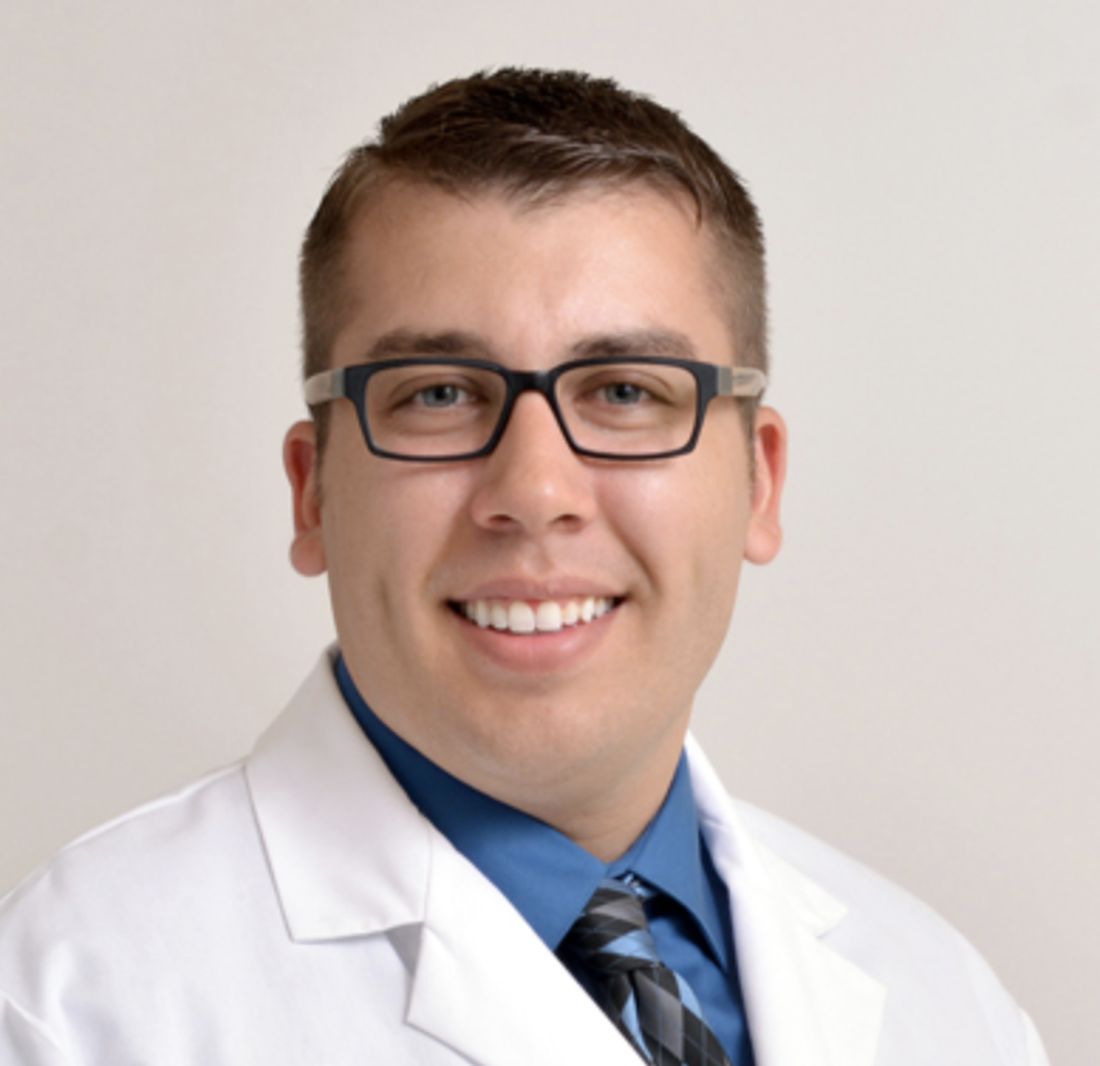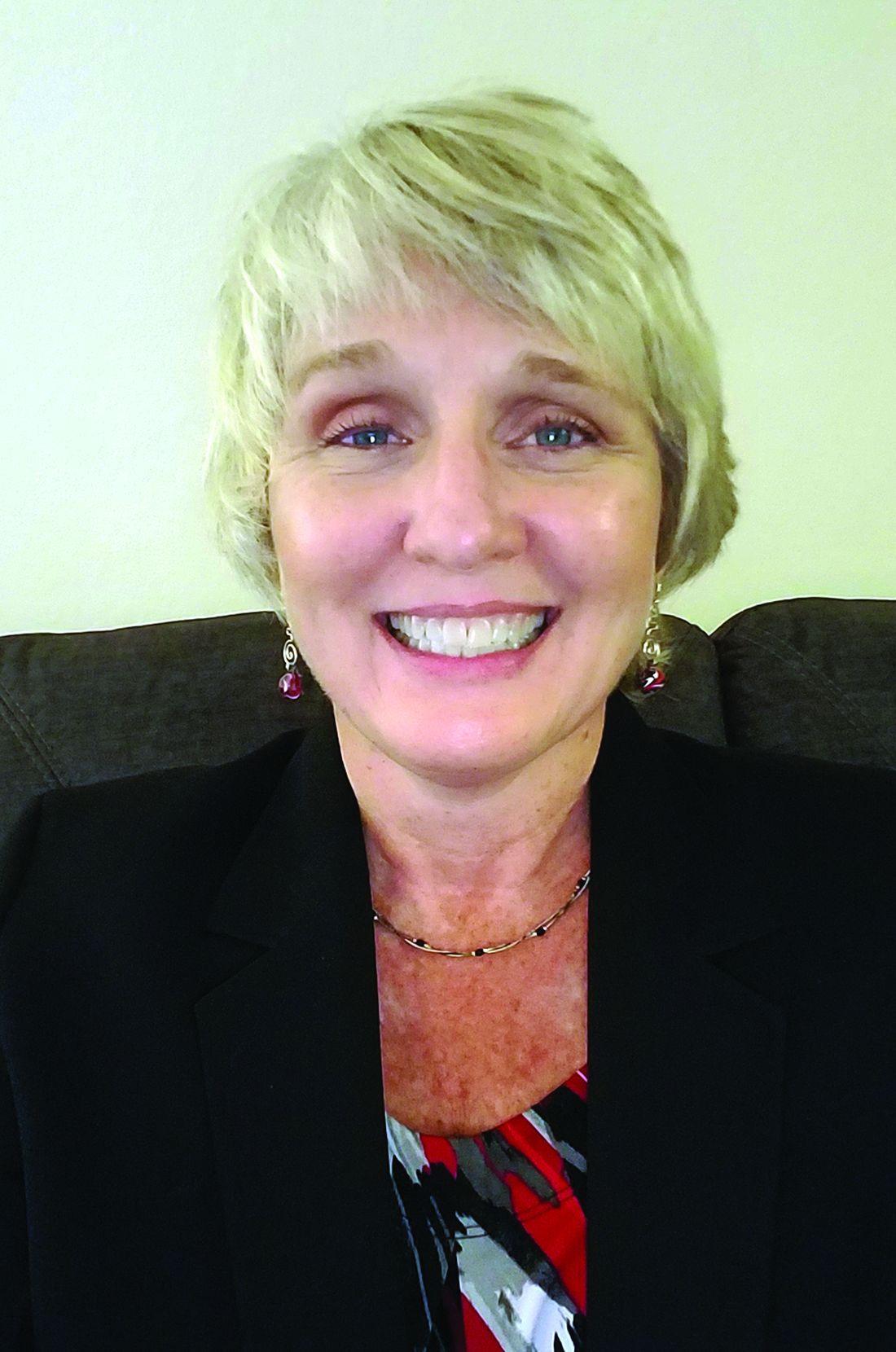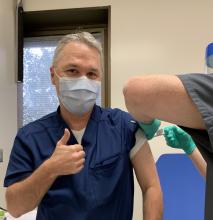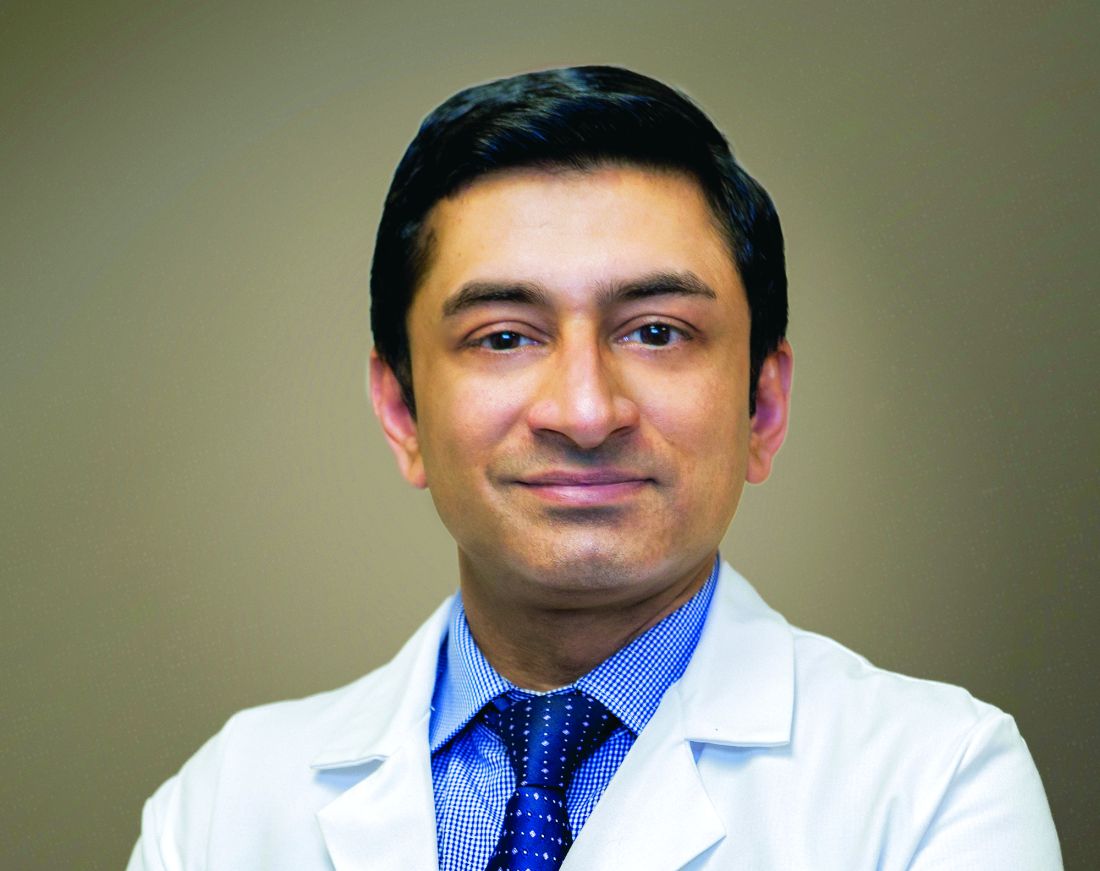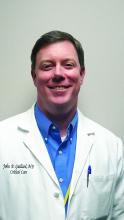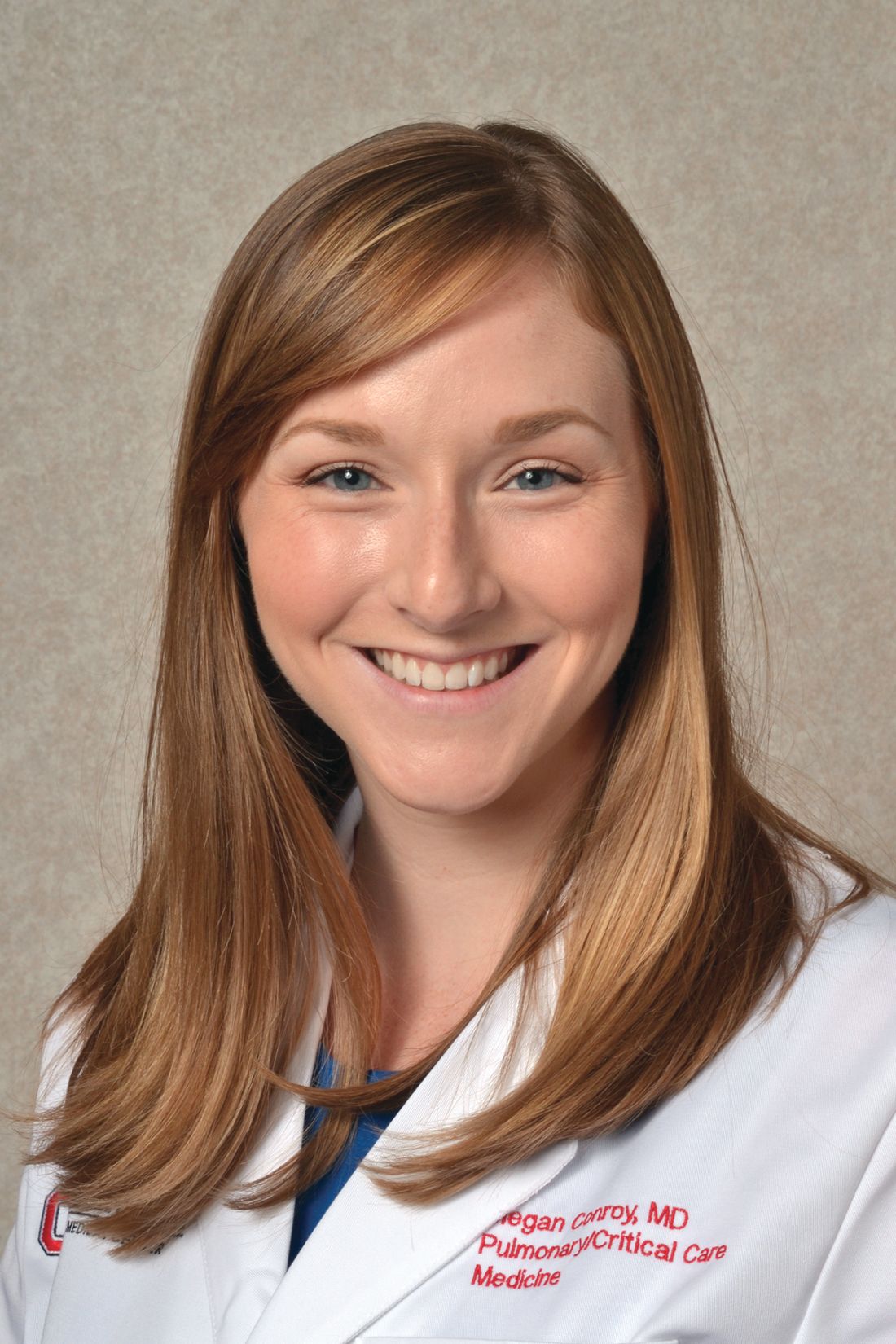User login
Evolution of ECMO. COVID-19 and pulmonary aspergillus. Lung cancer screening. Food as medicine. Air pollution.
Cardiovascular medicine and surgery
Evolution of ECMO as a result of COVID
A year and a half ago, the enormity of this pandemic was only beginning to be realized. Likewise, we have never before been so well-equipped to communicate, investigate, and collaborate through modern innovations. Despite our monumental progress with diagnostics and expedited vaccine production, there remain significant challenges with management of infected individuals suffering from severe sequelae after infection such as respiratory failure. Pharmacologic therapies with steroids, antivirals, and targeted immune modulators have demonstrated modest results at best thus far.
Early intubation unsurprisingly resulted in poor outcomes and a return to other established methods using high-flow nasal cannula and noninvasive positive-pressure ventilation (NIPPV) with a goal of avoiding mechanical ventilation are again the standard of care (Rola P, et al. Clin Exp Emerg Med. 2020 Jun 10. doi: 10.15441/ceem.20.043). Furthermore, limited resources encouraged utilization of established and probably previously underutilized techniques, such as proning with expected improvements in outcomes.
When conventional lung protective mechanical ventilation strategies have been unsuccessful, we have seen improved survival with the incorporation of extracorporeal membrane oxygenation (ECMO), especially when cannulated earlier (Giraud R, et al. 2021. Phys Rep). Many centers now offer ECMO support with considerable expertise and trends toward earlier ECMO cannulation, which permit ultraprotective lung ventilation (Schmidt M, et al. Am J Respir Crit Care Med. 2019 Oct 15;200[8]:1002-12). With benefits that parallel early tracheostomy, early ECMO may permit decreased sedation and earlier mobilization, which contribute to improved outcomes (Levin NM, et al. J Clin Med. 2021 Jan 12;10[2]:25). We may be approaching a paradigm shift where ECMO is performed in lieu of mechanical ventilation (Kurihara C, et al. 2018. Crit Care Med. 2018 Nov;46[11]:e1070-e1073). Future randomized clinical trials will need to be designed to answer this question.
Robert Baeten, II, DSc, PA-C, FCCP
NetWork Steering Committee Member
Chest infections
COVID-19-associated pulmonary aspergillosis: A cause for concern?
Since the global spread of SARS-CoV-2 more than a year ago, reports of secondary infections with Aspergillus spp. have emerged. Like influenza, there has been speculation that severe COVID-19 pneumonia is a unique risk factor for invasive pulmonary aspergillosis (IPA). This entity has been dubbed CAPA, or COVID-associated pulmonary aspergillosis. While the reported incidence of CAPA has ranged from around 5% to 35% in critically ill patients, it has been difficult to distinguish reports of colonization from true infection as histopathologic evidence of disease has been limited. Using stringent diagnostic criteria, a retrospective review of 145 mechanically ventilated patients with COVID-19 found the incidence of CAPA to be 4.8% (Fekkar A, et al. Am J Respir Crit Care Med. 2021 Feb 1;203[3]:307-17) which is similar to other non-COVID ARDS series. The authors found solid organ transplant and prolonged steroid treatment to be risk factors. Like other studies, no comparator group was utilized, limiting the conclusions regarding COVID-19 as an independent risk factor for IPA. Diagnostic criteria have been adapted to assist clinicians and allow for future research: Proven infection requires temporal relation with COVID-19 ICU admission and histopathologic evidence of Aspergillus spp. invasion or positive culture from sterile sites (Koehler P, et al. Lancet Infect Dis. 2020 Dec 14;S1473-3099[20]30847-1).
Aspergillus conidia are ubiquitous in the environment, and the respiratory epithelium and associated cilia act as the first defense against IPA. Distinct from influenza pneumonia, severe COVID-19 causes diffuse alveolar damage and does not appear to cause significant damage to the respiratory epithelium (Borczuk AC, et al. Mod Pathol. 2020;33[11]:2156-68). This coupled with the lack of histopathologic evidence of invasion in most reports of CAPA raises question regarding the extent of the association between COVID-19 and IPA. Nonetheless, immune perturbation caused by COVID-19 immunomodulating therapies, such as corticosteroids and IL-6 inhibitors, may ultimately leave patients susceptible to IPA and other opportunistic infections.
Kelly M. Pennington, MD
Charles S. Dela Cruz, MD
Sebastion Kurz, MD
NetWork Steering Committee Members
Clinical pulmonary medicine
New USPSTF guidelines for lung cancer screening: A step forward
Despite lung cancer being the number one cause of cancer-related death in America, screening for lung cancer remains low, with only 2-16% eligible patients being offered screening since the US Preventive Services Task Force (USPSTF) recommendation in 2013. New guidelines published in JAMA (Krist AH, et al. JAMA. 2021;325[10]:962-970; Meza R, et al. JAMA. 2021;325[10]:988-97; Jonas DE, at al. JAMA. 2021;325[10]:971-87) have suggested broadening eligibility to those 50-80 years old, who are smokers or previously quit in the past 15 years and have a minimum 20 pack-year smoking history (Grade B recommendation). The change lowers the starting age to 50 and the smoking requirement from 30 to 20 pack-years. Based on Cancer Intervention and Surveillance Modeling Network (CISNET) modeling, utilized by the UPSTF, this change can result in 503 (vs. 381 in the prior guideline) cancer deaths averted for every 100,000 adults and an estimated 13% reduction in lung cancer mortality and 6,918 life-years gained.
This recommendation will dramatically increase the number of eligible adults for screening by 6.4 million people, an increase of 86% compared with the 2013 guidelines. Most importantly, the decrease in pack-year requirement to 20 is expected to increase eligibility for women and minimize racial disparities. African American men have a higher incidence of lung cancer with less smoke exposure compared with white men. Non-Hispanic Black, Hispanics, American Indian/Alaska Native persons are hoped to have significant benefit from these new recommendations. Original recommendations in the 2013 guideline mirrored the National Lung Screening Trial, in which 91% participants were White. Regardless of these updated recommendations, serious socioeconomic barriers may continue to limit racial/ethnic minorities from accessing high-quality lung cancer screening programs. Besides changing the screening criteria, barriers to access will need to be addressed to achieve maximal benefits of the lung cancer screening program.
Munish Luthra, MD, FCCP
Samantha D’Annunzio, MD
Steering Committee Members
Interprofessional team
Let food be thy medicine and medicine be thy food – Hippocrates
Recently an article published in The Lancet discussed malnutrition in the patient with COVID-19 infection requiring non-invasive ventilation (NIV) (Turner P, et al. Lancet. 2021 Apr 3;397[10281]:126). It is known that COVID-19 infection causes hyperinflammation and hypercatabolism, resulting in disruption of metabolic pathways leading to muscle wasting, including cardiac muscle dysfunction, muscle weakness, and prolonged fatigue (Singer PJ, et al. 2021. Intensive Med. In press).
Lipids, specifically DHA and EPA, are known to inhibit cyclooxygenase enzyme and may suppress prostaglandin production and block platelet-activating factor. Consumption of carbohydrates with high glycemic indexes can result in free radical synthesis (increasing inflammatory cytokines C reactive protein, tumor necrosis alpha and interleukin-6). Other nutrients known to have an anti-inflammatory role include vitamins A & D, selenium, and copper. Vitamin A is known to enhance an antigen-specific immune response. Probiotics may also play a role in enhancing the immune response (Turner P, et al. 2021. Lancet. 2021 Apr 3;397[10281]:1261).
Patients requiring NIV encounter impaired tolerance to oral nutrition, and enteral nutrition (EN) is prescribed (Singer PJ, et al. 2021. Intensive Med. In press). Advantages of EN are maintenance of gut integrity and intestinal permeability as well as down regulation of the inflammatory response and insulin resistance. Furthermore, negative energy balance is associated with poor outcomes. Better focus on nutrition assessment practices is needed to overcome energy deficits during treatment of COVID-19 pneumonia. An interprofessional team approach increases use of nutritional scores and optimizes nutritional interventions.
If oral nutrition is feasible, prescribing small, frequent meals and high‐protein, calorically dense foods can ensure adequate caloric intake. (Behrens S, et al. Nutr Clin Pract. 2021 Feb;36[1]:105-9). When EN is indicated, the Intensive Care Society endorses the use of fine bore feeding tubes and NIV masks with special nasogastric tube adapters to reduce mask leak. Head-of-bed elevation and avoidance of bolus feeding improve EN tolerance (Pardo T, et al. 2021. Anaesth Crit Care Pain Med. 2020 Dec;39[6]:738-9).
*Due to the novelty of this disease information is limited and further study is warranted.
David W. Unkle, MSN, APN, FCCP
Robert Baeten, DMSc, PA-C, FCCP
Nikky Keer, DO
NetWork Steering Committee Members
Occupational and environmental health
Not just COVID in the air
Particulate matter (PM) is a specific type of air pollution referred to by its size in micrometers. A direct correlation has been shown between non-accidental death and PM2.5 concentration with a 1.5% increase in daily mortality (Schwartz J, et al. J Air Waste Manag Assoc. 1996 Oct;46[10]:927-39). From 2000-2019, PM2.5 concentrations have steadily decreased over 43% (Environmental Protection Agency). Significant decline in air pollution has occurred early in the COVID-19 pandemic. PM2.5 declined in counties from states instituting early non-essential business closures in the U.S. Additionally, NASA models revealed a nearly 20% drop in global nitrogen dioxide concentrations using a COVID-19-free 2020 model to compare with actual space and ground-based observations since February 2020 (NASA Model Reveals How Much COVID-related Pollution Levels Deviated from the Norm. 2020 Nov 17. The pandemic has shown that there is a significant human behavior-driven contribution to air pollution. The historic fire season of 2020 in the western states contributed to record high air pollution with attributable mortality (Liu X, et al. medRxiv 2020.09.20197921). Additionally, the COVID-19 pandemic impeded firefighting response (Burke M, et al. PNAS. 2021;11[2]:e2011048118).
Despite the pandemic related reduction, racial-ethnic disparities continue to exist in consumption of PM2.5. In a model looking at production of PM2.5, defined as consumption by the consumer and exposure as where the product or service originated, African American and Hispanic individuals have up to 12-21% greater pollution exposure within the United States (Tessum CW, et al. Proc Natl Acad Sci USA. 2019 Mar 26;116[13]:6001-6). PM pollution increased the risk of asthma attacks corresponding to zip codes with higher poverty levels and eligibility to Medicaid (O’Lenick CR, et al. Epidemiol Community Health. 2017 Feb;71[2]:129-36). Other studies have shown people with a lower socioeconomic position, have less education, live nearer to major sources of pollution, greater reliance on public transportation and unemployment are at higher risk from effects of PM pollution (American Lung Association. Disparities in the impact of air pollution.
Disclaimer: The views expressed in this article are those of the author(s) and do not reflect the official policy of the Department of Army/Navy/Air Force, Department of Defense, or US government.
Tyler Church, DO
Fellow-in-Training Member
Bathmapriya Balakrishnan, MD
Dixie Harris, MD
NetWork Steering Committee Members
Cardiovascular medicine and surgery
Evolution of ECMO as a result of COVID
A year and a half ago, the enormity of this pandemic was only beginning to be realized. Likewise, we have never before been so well-equipped to communicate, investigate, and collaborate through modern innovations. Despite our monumental progress with diagnostics and expedited vaccine production, there remain significant challenges with management of infected individuals suffering from severe sequelae after infection such as respiratory failure. Pharmacologic therapies with steroids, antivirals, and targeted immune modulators have demonstrated modest results at best thus far.
Early intubation unsurprisingly resulted in poor outcomes and a return to other established methods using high-flow nasal cannula and noninvasive positive-pressure ventilation (NIPPV) with a goal of avoiding mechanical ventilation are again the standard of care (Rola P, et al. Clin Exp Emerg Med. 2020 Jun 10. doi: 10.15441/ceem.20.043). Furthermore, limited resources encouraged utilization of established and probably previously underutilized techniques, such as proning with expected improvements in outcomes.
When conventional lung protective mechanical ventilation strategies have been unsuccessful, we have seen improved survival with the incorporation of extracorporeal membrane oxygenation (ECMO), especially when cannulated earlier (Giraud R, et al. 2021. Phys Rep). Many centers now offer ECMO support with considerable expertise and trends toward earlier ECMO cannulation, which permit ultraprotective lung ventilation (Schmidt M, et al. Am J Respir Crit Care Med. 2019 Oct 15;200[8]:1002-12). With benefits that parallel early tracheostomy, early ECMO may permit decreased sedation and earlier mobilization, which contribute to improved outcomes (Levin NM, et al. J Clin Med. 2021 Jan 12;10[2]:25). We may be approaching a paradigm shift where ECMO is performed in lieu of mechanical ventilation (Kurihara C, et al. 2018. Crit Care Med. 2018 Nov;46[11]:e1070-e1073). Future randomized clinical trials will need to be designed to answer this question.
Robert Baeten, II, DSc, PA-C, FCCP
NetWork Steering Committee Member
Chest infections
COVID-19-associated pulmonary aspergillosis: A cause for concern?
Since the global spread of SARS-CoV-2 more than a year ago, reports of secondary infections with Aspergillus spp. have emerged. Like influenza, there has been speculation that severe COVID-19 pneumonia is a unique risk factor for invasive pulmonary aspergillosis (IPA). This entity has been dubbed CAPA, or COVID-associated pulmonary aspergillosis. While the reported incidence of CAPA has ranged from around 5% to 35% in critically ill patients, it has been difficult to distinguish reports of colonization from true infection as histopathologic evidence of disease has been limited. Using stringent diagnostic criteria, a retrospective review of 145 mechanically ventilated patients with COVID-19 found the incidence of CAPA to be 4.8% (Fekkar A, et al. Am J Respir Crit Care Med. 2021 Feb 1;203[3]:307-17) which is similar to other non-COVID ARDS series. The authors found solid organ transplant and prolonged steroid treatment to be risk factors. Like other studies, no comparator group was utilized, limiting the conclusions regarding COVID-19 as an independent risk factor for IPA. Diagnostic criteria have been adapted to assist clinicians and allow for future research: Proven infection requires temporal relation with COVID-19 ICU admission and histopathologic evidence of Aspergillus spp. invasion or positive culture from sterile sites (Koehler P, et al. Lancet Infect Dis. 2020 Dec 14;S1473-3099[20]30847-1).
Aspergillus conidia are ubiquitous in the environment, and the respiratory epithelium and associated cilia act as the first defense against IPA. Distinct from influenza pneumonia, severe COVID-19 causes diffuse alveolar damage and does not appear to cause significant damage to the respiratory epithelium (Borczuk AC, et al. Mod Pathol. 2020;33[11]:2156-68). This coupled with the lack of histopathologic evidence of invasion in most reports of CAPA raises question regarding the extent of the association between COVID-19 and IPA. Nonetheless, immune perturbation caused by COVID-19 immunomodulating therapies, such as corticosteroids and IL-6 inhibitors, may ultimately leave patients susceptible to IPA and other opportunistic infections.
Kelly M. Pennington, MD
Charles S. Dela Cruz, MD
Sebastion Kurz, MD
NetWork Steering Committee Members
Clinical pulmonary medicine
New USPSTF guidelines for lung cancer screening: A step forward
Despite lung cancer being the number one cause of cancer-related death in America, screening for lung cancer remains low, with only 2-16% eligible patients being offered screening since the US Preventive Services Task Force (USPSTF) recommendation in 2013. New guidelines published in JAMA (Krist AH, et al. JAMA. 2021;325[10]:962-970; Meza R, et al. JAMA. 2021;325[10]:988-97; Jonas DE, at al. JAMA. 2021;325[10]:971-87) have suggested broadening eligibility to those 50-80 years old, who are smokers or previously quit in the past 15 years and have a minimum 20 pack-year smoking history (Grade B recommendation). The change lowers the starting age to 50 and the smoking requirement from 30 to 20 pack-years. Based on Cancer Intervention and Surveillance Modeling Network (CISNET) modeling, utilized by the UPSTF, this change can result in 503 (vs. 381 in the prior guideline) cancer deaths averted for every 100,000 adults and an estimated 13% reduction in lung cancer mortality and 6,918 life-years gained.
This recommendation will dramatically increase the number of eligible adults for screening by 6.4 million people, an increase of 86% compared with the 2013 guidelines. Most importantly, the decrease in pack-year requirement to 20 is expected to increase eligibility for women and minimize racial disparities. African American men have a higher incidence of lung cancer with less smoke exposure compared with white men. Non-Hispanic Black, Hispanics, American Indian/Alaska Native persons are hoped to have significant benefit from these new recommendations. Original recommendations in the 2013 guideline mirrored the National Lung Screening Trial, in which 91% participants were White. Regardless of these updated recommendations, serious socioeconomic barriers may continue to limit racial/ethnic minorities from accessing high-quality lung cancer screening programs. Besides changing the screening criteria, barriers to access will need to be addressed to achieve maximal benefits of the lung cancer screening program.
Munish Luthra, MD, FCCP
Samantha D’Annunzio, MD
Steering Committee Members
Interprofessional team
Let food be thy medicine and medicine be thy food – Hippocrates
Recently an article published in The Lancet discussed malnutrition in the patient with COVID-19 infection requiring non-invasive ventilation (NIV) (Turner P, et al. Lancet. 2021 Apr 3;397[10281]:126). It is known that COVID-19 infection causes hyperinflammation and hypercatabolism, resulting in disruption of metabolic pathways leading to muscle wasting, including cardiac muscle dysfunction, muscle weakness, and prolonged fatigue (Singer PJ, et al. 2021. Intensive Med. In press).
Lipids, specifically DHA and EPA, are known to inhibit cyclooxygenase enzyme and may suppress prostaglandin production and block platelet-activating factor. Consumption of carbohydrates with high glycemic indexes can result in free radical synthesis (increasing inflammatory cytokines C reactive protein, tumor necrosis alpha and interleukin-6). Other nutrients known to have an anti-inflammatory role include vitamins A & D, selenium, and copper. Vitamin A is known to enhance an antigen-specific immune response. Probiotics may also play a role in enhancing the immune response (Turner P, et al. 2021. Lancet. 2021 Apr 3;397[10281]:1261).
Patients requiring NIV encounter impaired tolerance to oral nutrition, and enteral nutrition (EN) is prescribed (Singer PJ, et al. 2021. Intensive Med. In press). Advantages of EN are maintenance of gut integrity and intestinal permeability as well as down regulation of the inflammatory response and insulin resistance. Furthermore, negative energy balance is associated with poor outcomes. Better focus on nutrition assessment practices is needed to overcome energy deficits during treatment of COVID-19 pneumonia. An interprofessional team approach increases use of nutritional scores and optimizes nutritional interventions.
If oral nutrition is feasible, prescribing small, frequent meals and high‐protein, calorically dense foods can ensure adequate caloric intake. (Behrens S, et al. Nutr Clin Pract. 2021 Feb;36[1]:105-9). When EN is indicated, the Intensive Care Society endorses the use of fine bore feeding tubes and NIV masks with special nasogastric tube adapters to reduce mask leak. Head-of-bed elevation and avoidance of bolus feeding improve EN tolerance (Pardo T, et al. 2021. Anaesth Crit Care Pain Med. 2020 Dec;39[6]:738-9).
*Due to the novelty of this disease information is limited and further study is warranted.
David W. Unkle, MSN, APN, FCCP
Robert Baeten, DMSc, PA-C, FCCP
Nikky Keer, DO
NetWork Steering Committee Members
Occupational and environmental health
Not just COVID in the air
Particulate matter (PM) is a specific type of air pollution referred to by its size in micrometers. A direct correlation has been shown between non-accidental death and PM2.5 concentration with a 1.5% increase in daily mortality (Schwartz J, et al. J Air Waste Manag Assoc. 1996 Oct;46[10]:927-39). From 2000-2019, PM2.5 concentrations have steadily decreased over 43% (Environmental Protection Agency). Significant decline in air pollution has occurred early in the COVID-19 pandemic. PM2.5 declined in counties from states instituting early non-essential business closures in the U.S. Additionally, NASA models revealed a nearly 20% drop in global nitrogen dioxide concentrations using a COVID-19-free 2020 model to compare with actual space and ground-based observations since February 2020 (NASA Model Reveals How Much COVID-related Pollution Levels Deviated from the Norm. 2020 Nov 17. The pandemic has shown that there is a significant human behavior-driven contribution to air pollution. The historic fire season of 2020 in the western states contributed to record high air pollution with attributable mortality (Liu X, et al. medRxiv 2020.09.20197921). Additionally, the COVID-19 pandemic impeded firefighting response (Burke M, et al. PNAS. 2021;11[2]:e2011048118).
Despite the pandemic related reduction, racial-ethnic disparities continue to exist in consumption of PM2.5. In a model looking at production of PM2.5, defined as consumption by the consumer and exposure as where the product or service originated, African American and Hispanic individuals have up to 12-21% greater pollution exposure within the United States (Tessum CW, et al. Proc Natl Acad Sci USA. 2019 Mar 26;116[13]:6001-6). PM pollution increased the risk of asthma attacks corresponding to zip codes with higher poverty levels and eligibility to Medicaid (O’Lenick CR, et al. Epidemiol Community Health. 2017 Feb;71[2]:129-36). Other studies have shown people with a lower socioeconomic position, have less education, live nearer to major sources of pollution, greater reliance on public transportation and unemployment are at higher risk from effects of PM pollution (American Lung Association. Disparities in the impact of air pollution.
Disclaimer: The views expressed in this article are those of the author(s) and do not reflect the official policy of the Department of Army/Navy/Air Force, Department of Defense, or US government.
Tyler Church, DO
Fellow-in-Training Member
Bathmapriya Balakrishnan, MD
Dixie Harris, MD
NetWork Steering Committee Members
Cardiovascular medicine and surgery
Evolution of ECMO as a result of COVID
A year and a half ago, the enormity of this pandemic was only beginning to be realized. Likewise, we have never before been so well-equipped to communicate, investigate, and collaborate through modern innovations. Despite our monumental progress with diagnostics and expedited vaccine production, there remain significant challenges with management of infected individuals suffering from severe sequelae after infection such as respiratory failure. Pharmacologic therapies with steroids, antivirals, and targeted immune modulators have demonstrated modest results at best thus far.
Early intubation unsurprisingly resulted in poor outcomes and a return to other established methods using high-flow nasal cannula and noninvasive positive-pressure ventilation (NIPPV) with a goal of avoiding mechanical ventilation are again the standard of care (Rola P, et al. Clin Exp Emerg Med. 2020 Jun 10. doi: 10.15441/ceem.20.043). Furthermore, limited resources encouraged utilization of established and probably previously underutilized techniques, such as proning with expected improvements in outcomes.
When conventional lung protective mechanical ventilation strategies have been unsuccessful, we have seen improved survival with the incorporation of extracorporeal membrane oxygenation (ECMO), especially when cannulated earlier (Giraud R, et al. 2021. Phys Rep). Many centers now offer ECMO support with considerable expertise and trends toward earlier ECMO cannulation, which permit ultraprotective lung ventilation (Schmidt M, et al. Am J Respir Crit Care Med. 2019 Oct 15;200[8]:1002-12). With benefits that parallel early tracheostomy, early ECMO may permit decreased sedation and earlier mobilization, which contribute to improved outcomes (Levin NM, et al. J Clin Med. 2021 Jan 12;10[2]:25). We may be approaching a paradigm shift where ECMO is performed in lieu of mechanical ventilation (Kurihara C, et al. 2018. Crit Care Med. 2018 Nov;46[11]:e1070-e1073). Future randomized clinical trials will need to be designed to answer this question.
Robert Baeten, II, DSc, PA-C, FCCP
NetWork Steering Committee Member
Chest infections
COVID-19-associated pulmonary aspergillosis: A cause for concern?
Since the global spread of SARS-CoV-2 more than a year ago, reports of secondary infections with Aspergillus spp. have emerged. Like influenza, there has been speculation that severe COVID-19 pneumonia is a unique risk factor for invasive pulmonary aspergillosis (IPA). This entity has been dubbed CAPA, or COVID-associated pulmonary aspergillosis. While the reported incidence of CAPA has ranged from around 5% to 35% in critically ill patients, it has been difficult to distinguish reports of colonization from true infection as histopathologic evidence of disease has been limited. Using stringent diagnostic criteria, a retrospective review of 145 mechanically ventilated patients with COVID-19 found the incidence of CAPA to be 4.8% (Fekkar A, et al. Am J Respir Crit Care Med. 2021 Feb 1;203[3]:307-17) which is similar to other non-COVID ARDS series. The authors found solid organ transplant and prolonged steroid treatment to be risk factors. Like other studies, no comparator group was utilized, limiting the conclusions regarding COVID-19 as an independent risk factor for IPA. Diagnostic criteria have been adapted to assist clinicians and allow for future research: Proven infection requires temporal relation with COVID-19 ICU admission and histopathologic evidence of Aspergillus spp. invasion or positive culture from sterile sites (Koehler P, et al. Lancet Infect Dis. 2020 Dec 14;S1473-3099[20]30847-1).
Aspergillus conidia are ubiquitous in the environment, and the respiratory epithelium and associated cilia act as the first defense against IPA. Distinct from influenza pneumonia, severe COVID-19 causes diffuse alveolar damage and does not appear to cause significant damage to the respiratory epithelium (Borczuk AC, et al. Mod Pathol. 2020;33[11]:2156-68). This coupled with the lack of histopathologic evidence of invasion in most reports of CAPA raises question regarding the extent of the association between COVID-19 and IPA. Nonetheless, immune perturbation caused by COVID-19 immunomodulating therapies, such as corticosteroids and IL-6 inhibitors, may ultimately leave patients susceptible to IPA and other opportunistic infections.
Kelly M. Pennington, MD
Charles S. Dela Cruz, MD
Sebastion Kurz, MD
NetWork Steering Committee Members
Clinical pulmonary medicine
New USPSTF guidelines for lung cancer screening: A step forward
Despite lung cancer being the number one cause of cancer-related death in America, screening for lung cancer remains low, with only 2-16% eligible patients being offered screening since the US Preventive Services Task Force (USPSTF) recommendation in 2013. New guidelines published in JAMA (Krist AH, et al. JAMA. 2021;325[10]:962-970; Meza R, et al. JAMA. 2021;325[10]:988-97; Jonas DE, at al. JAMA. 2021;325[10]:971-87) have suggested broadening eligibility to those 50-80 years old, who are smokers or previously quit in the past 15 years and have a minimum 20 pack-year smoking history (Grade B recommendation). The change lowers the starting age to 50 and the smoking requirement from 30 to 20 pack-years. Based on Cancer Intervention and Surveillance Modeling Network (CISNET) modeling, utilized by the UPSTF, this change can result in 503 (vs. 381 in the prior guideline) cancer deaths averted for every 100,000 adults and an estimated 13% reduction in lung cancer mortality and 6,918 life-years gained.
This recommendation will dramatically increase the number of eligible adults for screening by 6.4 million people, an increase of 86% compared with the 2013 guidelines. Most importantly, the decrease in pack-year requirement to 20 is expected to increase eligibility for women and minimize racial disparities. African American men have a higher incidence of lung cancer with less smoke exposure compared with white men. Non-Hispanic Black, Hispanics, American Indian/Alaska Native persons are hoped to have significant benefit from these new recommendations. Original recommendations in the 2013 guideline mirrored the National Lung Screening Trial, in which 91% participants were White. Regardless of these updated recommendations, serious socioeconomic barriers may continue to limit racial/ethnic minorities from accessing high-quality lung cancer screening programs. Besides changing the screening criteria, barriers to access will need to be addressed to achieve maximal benefits of the lung cancer screening program.
Munish Luthra, MD, FCCP
Samantha D’Annunzio, MD
Steering Committee Members
Interprofessional team
Let food be thy medicine and medicine be thy food – Hippocrates
Recently an article published in The Lancet discussed malnutrition in the patient with COVID-19 infection requiring non-invasive ventilation (NIV) (Turner P, et al. Lancet. 2021 Apr 3;397[10281]:126). It is known that COVID-19 infection causes hyperinflammation and hypercatabolism, resulting in disruption of metabolic pathways leading to muscle wasting, including cardiac muscle dysfunction, muscle weakness, and prolonged fatigue (Singer PJ, et al. 2021. Intensive Med. In press).
Lipids, specifically DHA and EPA, are known to inhibit cyclooxygenase enzyme and may suppress prostaglandin production and block platelet-activating factor. Consumption of carbohydrates with high glycemic indexes can result in free radical synthesis (increasing inflammatory cytokines C reactive protein, tumor necrosis alpha and interleukin-6). Other nutrients known to have an anti-inflammatory role include vitamins A & D, selenium, and copper. Vitamin A is known to enhance an antigen-specific immune response. Probiotics may also play a role in enhancing the immune response (Turner P, et al. 2021. Lancet. 2021 Apr 3;397[10281]:1261).
Patients requiring NIV encounter impaired tolerance to oral nutrition, and enteral nutrition (EN) is prescribed (Singer PJ, et al. 2021. Intensive Med. In press). Advantages of EN are maintenance of gut integrity and intestinal permeability as well as down regulation of the inflammatory response and insulin resistance. Furthermore, negative energy balance is associated with poor outcomes. Better focus on nutrition assessment practices is needed to overcome energy deficits during treatment of COVID-19 pneumonia. An interprofessional team approach increases use of nutritional scores and optimizes nutritional interventions.
If oral nutrition is feasible, prescribing small, frequent meals and high‐protein, calorically dense foods can ensure adequate caloric intake. (Behrens S, et al. Nutr Clin Pract. 2021 Feb;36[1]:105-9). When EN is indicated, the Intensive Care Society endorses the use of fine bore feeding tubes and NIV masks with special nasogastric tube adapters to reduce mask leak. Head-of-bed elevation and avoidance of bolus feeding improve EN tolerance (Pardo T, et al. 2021. Anaesth Crit Care Pain Med. 2020 Dec;39[6]:738-9).
*Due to the novelty of this disease information is limited and further study is warranted.
David W. Unkle, MSN, APN, FCCP
Robert Baeten, DMSc, PA-C, FCCP
Nikky Keer, DO
NetWork Steering Committee Members
Occupational and environmental health
Not just COVID in the air
Particulate matter (PM) is a specific type of air pollution referred to by its size in micrometers. A direct correlation has been shown between non-accidental death and PM2.5 concentration with a 1.5% increase in daily mortality (Schwartz J, et al. J Air Waste Manag Assoc. 1996 Oct;46[10]:927-39). From 2000-2019, PM2.5 concentrations have steadily decreased over 43% (Environmental Protection Agency). Significant decline in air pollution has occurred early in the COVID-19 pandemic. PM2.5 declined in counties from states instituting early non-essential business closures in the U.S. Additionally, NASA models revealed a nearly 20% drop in global nitrogen dioxide concentrations using a COVID-19-free 2020 model to compare with actual space and ground-based observations since February 2020 (NASA Model Reveals How Much COVID-related Pollution Levels Deviated from the Norm. 2020 Nov 17. The pandemic has shown that there is a significant human behavior-driven contribution to air pollution. The historic fire season of 2020 in the western states contributed to record high air pollution with attributable mortality (Liu X, et al. medRxiv 2020.09.20197921). Additionally, the COVID-19 pandemic impeded firefighting response (Burke M, et al. PNAS. 2021;11[2]:e2011048118).
Despite the pandemic related reduction, racial-ethnic disparities continue to exist in consumption of PM2.5. In a model looking at production of PM2.5, defined as consumption by the consumer and exposure as where the product or service originated, African American and Hispanic individuals have up to 12-21% greater pollution exposure within the United States (Tessum CW, et al. Proc Natl Acad Sci USA. 2019 Mar 26;116[13]:6001-6). PM pollution increased the risk of asthma attacks corresponding to zip codes with higher poverty levels and eligibility to Medicaid (O’Lenick CR, et al. Epidemiol Community Health. 2017 Feb;71[2]:129-36). Other studies have shown people with a lower socioeconomic position, have less education, live nearer to major sources of pollution, greater reliance on public transportation and unemployment are at higher risk from effects of PM pollution (American Lung Association. Disparities in the impact of air pollution.
Disclaimer: The views expressed in this article are those of the author(s) and do not reflect the official policy of the Department of Army/Navy/Air Force, Department of Defense, or US government.
Tyler Church, DO
Fellow-in-Training Member
Bathmapriya Balakrishnan, MD
Dixie Harris, MD
NetWork Steering Committee Members
: Management of pleural infections. Appendicitis and COVID-19. Screening for PAH. Lung function testing during the pandemic
Interventional chest and diagnostic procedures
Risk stratification and management of pleural infections
Pleural infection carries a significant health care burden with an estimated mortality rate between 10% and 20% in adults. Standard of care for pleural infections has traditionally included antibiotics and tube thoracostomy, with select patients requiring a surgical intervention. The landmark MIST II trial demonstrated that combination intrapleural fibrinolytic and DNase therapy led to reduced length of stay and lower surgical referral rates compared with placebo.1 While the use of combination intrapleural therapy has become common in the management of these patients, controversies still exist regarding nuances related to the various aspects of this therapy. A recent position paper published in Lancet Respiratory Medicine2 addresses these knowledge gaps and provides recommendations to offer guidance in decision-making. The consensus statement by the authors addresses the topics of intrapleural monotherapy, dosing regimen, sequence of dosing, and cost considerations amongst other things. The authors also summarize evidence and discuss a surgery first vs. intrapleural enzyme therapy first approach based on stage of empyema and presence of surgical expertise and surgical candidacy. However, the debate between early surgical intervention vs early intrapleural enzyme therapy has not been settled yet. A large prospective randomized control trial is currently ongoing to help answer this question [https://doi.org/10.1186/ISRCTN18192121].
Meanwhile, there has been a lack of robust validated prediction methods for selecting high-risk patients at presentation with pleural infection for an early aggressive intervention. Based on previous studies, Rahman et al.3 had described the RAPID (Renal[urea], Age, fluid Purulence, Infection Source, Dietary [albumin]) score for risk stratification of these patients. Corcoran et al.4 recently conducted a prospective, observational study and validated that the RAPID risk category (Low-risk [0-2], Medium-risk [3-4], and High-risk [5-7]) can help predict mortality at 3 months. This score may prove to be a useful tool for future research directed at improving outcomes in patients with pleural infections.
Abhinav Agrawal, MD
Samaan Rafeq , MD
NetWork Members
References
1. Rahman NM, et al. N Engl J Med. 2011 Aug 11;365(6):518.
doi: 10.1056/NEJMoa1012740.
2. Chaddha U, et al. Lancet Respir Med. 2021. S2213-2600(20)30533-6. doi: 10.1016/S2213-2600(20)30533-6.
3. Rahman NM, et al. Chest. 2014 Apr;145(4):848. doi: 10.1378/chest.13-1558.
4. Corcoran JP, et al. Eur Respir J. 2020 Nov 26;56(5):2000130. doi: 10.1183/13993003.00130-2020.
Pediatric chest medicine
Appendicitis and COVID-19
During the 2020-21 year, there was an unprecedent amount of literature and studies released to the scientific and general public about the severe, acute respiratory Coronavirus 2 (SARS-CoV-2) syndrome, commonly referred to as COVID-19. The impressive focus on SARS-CoV-2 appeared appropriately featured given the public health concerns with contraction of the disease.
While it is important to understand the potential presentations, complications, and treatments in the adult population, clinicians must be aware of the impact of this disease on children. Contrary to reports early in the pandemic, SARS-CoV-2 infection can lead to serious complications in the pediatric population. One complication is a condition called multisystem inflammation syndrome in children (MIS-C) that can mimic Kawasaki disease or toxic shock syndrome. In addition to the expected common clinical presentation of respiratory symptoms and fever, gastrointestinal complaints were reported in up to 84% of the infected children. Gastrointestinal symptoms may be the only complaint in this population, typically presenting with nausea, emesis, abdominal pain, and diarrhea. The Pediatric Chest NetWork intends to highlight these gastrointestinal complaints and make clinicians aware of an appendicitis-like syndrome or even true acute appendicitis that seems to occur in association with SARS-CoV-2 infection. There is a handful of case reports and case series that discussed this phenomenon. Due to the overlap of presenting symptoms in SARS-CoV-2 infection and acute appendicitis, clinicians must astutely evaluate patients to prevent worsening complications of a missed diagnosed appendicitis.
Eric Mull, DO
NetWork Fellow-in-Training
Pulmonary physiology, function, and rehabilitation
Lung function testing during the COVID-19 pandemic
The COVID-19 pandemic poses unique challenges to caring for patients with established lung disease or new onset respiratory complaints. Although maneuvers differ across individual tests, most involve forced expiration or high ventilatory rates. They also tend to generate cough. Because the SARS-CoV-2 virus is predominantly spread via respiratory droplets, coughing, forced expiration, and high ventilatory rates will increase the risk for transmission.
Respiratory societies across the world have developed recommendations for operating a pulmonary function lab during the pandemic (Pulmonology. 2020 Aug 5;S2531-0437[20]30175-6; Ann Am Thorac Soc. 2020;17[11]:1343). In general, deferring all non-ssential testing and adjusting precautions and testing volume by local infection rates is recommended. Using proper personal protective equipment (PPE), including N95 respirators for staff, enhanced cleaning of rooms and PFT equipment (per manufacturer recommendations), and allowing time for adequate air exchange between tests are recommended practices. Screening for symptoms prior to testing is mandatory, with the recognition that for pulmonary patients, the specificity for COVID-19 will be poor. Finally, testing for SARS-CoV-2, generally within 72 hours, and using negative pressure rooms, has been encouraged by all, though there is variation by institution and resources.
It remains imperative that lung function labs provide a safe environment for patients and staff. However, delays related to deferrals and the increased turnover time required for cleaning and air circulation grow worse over time. As the pandemic persists, the mounting toll on our pulmonary patients looms large – so please, get vaccinated and use proper precautions.
Thomas Decato, MD, FCCP
Vice-Chair
Aaron Holley, MD, FCCP
NetWork Member
Pulmonary vascular disease
I screen, you screen, we all screen for ... PAH
Although rare in the general population, pulmonary arterial hypertension (PAH) occurs more frequently in connective tissue disease, congenital heart disease, HIV, portal hypertension, and in carriers of gene mutations of heritable PAH. Given the high morbidity and mortality, and improved outcomes with earlier diagnosis and treatment, guidelines recommend aggressive assessment and screening for PAH in these high-risk groups (Frost A, et al. Eur Respir J. 2019; 53:1801904).
Effective PAH screening algorithms have been developed in systemic sclerosis. The best validated screening tool is the DETECT algorithm (Coghlan JG, et al. Ann Rheum Dis. 2014;73:1340), which uses clinical, laboratory, and pulmonary function test parameters in conjunction with echocardiographic findings to recommend right heart catheterization (RHC) for PH diagnosis. Multimodal assessments are more sensitive than echocardiography alone in diagnosing PAH in systemic sclerosis (Hao Y, et al. Arthritis Res Ther. 2015;17:7) and should be developed in other at-risk cohorts.
Recently, the DELPHI-2 study prospectively screened 55 asymptomatic adult carriers of a BMPR2 mutation- the most common genetic mutation in heritable PAH- for minimum of 2 years (Montani D, et al. Eur Respir J. 2020 Dec 30;2004229. doi: 10.1183/13993003.04229-2020). Using predefined symptomatic, echocardiographic, and cardiopulmonary exercise testing criteria for referral for RHC, the incidence of PAH was 2.3% per year. This study lays the foundation for a multimodal approach to screening carriers of BMPR2 mutations and emphasizes the importance of genetic counseling for idiopathic and familial PAH patients to identify mutation carriers who stand to benefit from appropriate PAH screening.
Christopher J. Mullin, MD, MHS
Steering Committee Member
Interventional chest and diagnostic procedures
Risk stratification and management of pleural infections
Pleural infection carries a significant health care burden with an estimated mortality rate between 10% and 20% in adults. Standard of care for pleural infections has traditionally included antibiotics and tube thoracostomy, with select patients requiring a surgical intervention. The landmark MIST II trial demonstrated that combination intrapleural fibrinolytic and DNase therapy led to reduced length of stay and lower surgical referral rates compared with placebo.1 While the use of combination intrapleural therapy has become common in the management of these patients, controversies still exist regarding nuances related to the various aspects of this therapy. A recent position paper published in Lancet Respiratory Medicine2 addresses these knowledge gaps and provides recommendations to offer guidance in decision-making. The consensus statement by the authors addresses the topics of intrapleural monotherapy, dosing regimen, sequence of dosing, and cost considerations amongst other things. The authors also summarize evidence and discuss a surgery first vs. intrapleural enzyme therapy first approach based on stage of empyema and presence of surgical expertise and surgical candidacy. However, the debate between early surgical intervention vs early intrapleural enzyme therapy has not been settled yet. A large prospective randomized control trial is currently ongoing to help answer this question [https://doi.org/10.1186/ISRCTN18192121].
Meanwhile, there has been a lack of robust validated prediction methods for selecting high-risk patients at presentation with pleural infection for an early aggressive intervention. Based on previous studies, Rahman et al.3 had described the RAPID (Renal[urea], Age, fluid Purulence, Infection Source, Dietary [albumin]) score for risk stratification of these patients. Corcoran et al.4 recently conducted a prospective, observational study and validated that the RAPID risk category (Low-risk [0-2], Medium-risk [3-4], and High-risk [5-7]) can help predict mortality at 3 months. This score may prove to be a useful tool for future research directed at improving outcomes in patients with pleural infections.
Abhinav Agrawal, MD
Samaan Rafeq , MD
NetWork Members
References
1. Rahman NM, et al. N Engl J Med. 2011 Aug 11;365(6):518.
doi: 10.1056/NEJMoa1012740.
2. Chaddha U, et al. Lancet Respir Med. 2021. S2213-2600(20)30533-6. doi: 10.1016/S2213-2600(20)30533-6.
3. Rahman NM, et al. Chest. 2014 Apr;145(4):848. doi: 10.1378/chest.13-1558.
4. Corcoran JP, et al. Eur Respir J. 2020 Nov 26;56(5):2000130. doi: 10.1183/13993003.00130-2020.
Pediatric chest medicine
Appendicitis and COVID-19
During the 2020-21 year, there was an unprecedent amount of literature and studies released to the scientific and general public about the severe, acute respiratory Coronavirus 2 (SARS-CoV-2) syndrome, commonly referred to as COVID-19. The impressive focus on SARS-CoV-2 appeared appropriately featured given the public health concerns with contraction of the disease.
While it is important to understand the potential presentations, complications, and treatments in the adult population, clinicians must be aware of the impact of this disease on children. Contrary to reports early in the pandemic, SARS-CoV-2 infection can lead to serious complications in the pediatric population. One complication is a condition called multisystem inflammation syndrome in children (MIS-C) that can mimic Kawasaki disease or toxic shock syndrome. In addition to the expected common clinical presentation of respiratory symptoms and fever, gastrointestinal complaints were reported in up to 84% of the infected children. Gastrointestinal symptoms may be the only complaint in this population, typically presenting with nausea, emesis, abdominal pain, and diarrhea. The Pediatric Chest NetWork intends to highlight these gastrointestinal complaints and make clinicians aware of an appendicitis-like syndrome or even true acute appendicitis that seems to occur in association with SARS-CoV-2 infection. There is a handful of case reports and case series that discussed this phenomenon. Due to the overlap of presenting symptoms in SARS-CoV-2 infection and acute appendicitis, clinicians must astutely evaluate patients to prevent worsening complications of a missed diagnosed appendicitis.
Eric Mull, DO
NetWork Fellow-in-Training
Pulmonary physiology, function, and rehabilitation
Lung function testing during the COVID-19 pandemic
The COVID-19 pandemic poses unique challenges to caring for patients with established lung disease or new onset respiratory complaints. Although maneuvers differ across individual tests, most involve forced expiration or high ventilatory rates. They also tend to generate cough. Because the SARS-CoV-2 virus is predominantly spread via respiratory droplets, coughing, forced expiration, and high ventilatory rates will increase the risk for transmission.
Respiratory societies across the world have developed recommendations for operating a pulmonary function lab during the pandemic (Pulmonology. 2020 Aug 5;S2531-0437[20]30175-6; Ann Am Thorac Soc. 2020;17[11]:1343). In general, deferring all non-ssential testing and adjusting precautions and testing volume by local infection rates is recommended. Using proper personal protective equipment (PPE), including N95 respirators for staff, enhanced cleaning of rooms and PFT equipment (per manufacturer recommendations), and allowing time for adequate air exchange between tests are recommended practices. Screening for symptoms prior to testing is mandatory, with the recognition that for pulmonary patients, the specificity for COVID-19 will be poor. Finally, testing for SARS-CoV-2, generally within 72 hours, and using negative pressure rooms, has been encouraged by all, though there is variation by institution and resources.
It remains imperative that lung function labs provide a safe environment for patients and staff. However, delays related to deferrals and the increased turnover time required for cleaning and air circulation grow worse over time. As the pandemic persists, the mounting toll on our pulmonary patients looms large – so please, get vaccinated and use proper precautions.
Thomas Decato, MD, FCCP
Vice-Chair
Aaron Holley, MD, FCCP
NetWork Member
Pulmonary vascular disease
I screen, you screen, we all screen for ... PAH
Although rare in the general population, pulmonary arterial hypertension (PAH) occurs more frequently in connective tissue disease, congenital heart disease, HIV, portal hypertension, and in carriers of gene mutations of heritable PAH. Given the high morbidity and mortality, and improved outcomes with earlier diagnosis and treatment, guidelines recommend aggressive assessment and screening for PAH in these high-risk groups (Frost A, et al. Eur Respir J. 2019; 53:1801904).
Effective PAH screening algorithms have been developed in systemic sclerosis. The best validated screening tool is the DETECT algorithm (Coghlan JG, et al. Ann Rheum Dis. 2014;73:1340), which uses clinical, laboratory, and pulmonary function test parameters in conjunction with echocardiographic findings to recommend right heart catheterization (RHC) for PH diagnosis. Multimodal assessments are more sensitive than echocardiography alone in diagnosing PAH in systemic sclerosis (Hao Y, et al. Arthritis Res Ther. 2015;17:7) and should be developed in other at-risk cohorts.
Recently, the DELPHI-2 study prospectively screened 55 asymptomatic adult carriers of a BMPR2 mutation- the most common genetic mutation in heritable PAH- for minimum of 2 years (Montani D, et al. Eur Respir J. 2020 Dec 30;2004229. doi: 10.1183/13993003.04229-2020). Using predefined symptomatic, echocardiographic, and cardiopulmonary exercise testing criteria for referral for RHC, the incidence of PAH was 2.3% per year. This study lays the foundation for a multimodal approach to screening carriers of BMPR2 mutations and emphasizes the importance of genetic counseling for idiopathic and familial PAH patients to identify mutation carriers who stand to benefit from appropriate PAH screening.
Christopher J. Mullin, MD, MHS
Steering Committee Member
Interventional chest and diagnostic procedures
Risk stratification and management of pleural infections
Pleural infection carries a significant health care burden with an estimated mortality rate between 10% and 20% in adults. Standard of care for pleural infections has traditionally included antibiotics and tube thoracostomy, with select patients requiring a surgical intervention. The landmark MIST II trial demonstrated that combination intrapleural fibrinolytic and DNase therapy led to reduced length of stay and lower surgical referral rates compared with placebo.1 While the use of combination intrapleural therapy has become common in the management of these patients, controversies still exist regarding nuances related to the various aspects of this therapy. A recent position paper published in Lancet Respiratory Medicine2 addresses these knowledge gaps and provides recommendations to offer guidance in decision-making. The consensus statement by the authors addresses the topics of intrapleural monotherapy, dosing regimen, sequence of dosing, and cost considerations amongst other things. The authors also summarize evidence and discuss a surgery first vs. intrapleural enzyme therapy first approach based on stage of empyema and presence of surgical expertise and surgical candidacy. However, the debate between early surgical intervention vs early intrapleural enzyme therapy has not been settled yet. A large prospective randomized control trial is currently ongoing to help answer this question [https://doi.org/10.1186/ISRCTN18192121].
Meanwhile, there has been a lack of robust validated prediction methods for selecting high-risk patients at presentation with pleural infection for an early aggressive intervention. Based on previous studies, Rahman et al.3 had described the RAPID (Renal[urea], Age, fluid Purulence, Infection Source, Dietary [albumin]) score for risk stratification of these patients. Corcoran et al.4 recently conducted a prospective, observational study and validated that the RAPID risk category (Low-risk [0-2], Medium-risk [3-4], and High-risk [5-7]) can help predict mortality at 3 months. This score may prove to be a useful tool for future research directed at improving outcomes in patients with pleural infections.
Abhinav Agrawal, MD
Samaan Rafeq , MD
NetWork Members
References
1. Rahman NM, et al. N Engl J Med. 2011 Aug 11;365(6):518.
doi: 10.1056/NEJMoa1012740.
2. Chaddha U, et al. Lancet Respir Med. 2021. S2213-2600(20)30533-6. doi: 10.1016/S2213-2600(20)30533-6.
3. Rahman NM, et al. Chest. 2014 Apr;145(4):848. doi: 10.1378/chest.13-1558.
4. Corcoran JP, et al. Eur Respir J. 2020 Nov 26;56(5):2000130. doi: 10.1183/13993003.00130-2020.
Pediatric chest medicine
Appendicitis and COVID-19
During the 2020-21 year, there was an unprecedent amount of literature and studies released to the scientific and general public about the severe, acute respiratory Coronavirus 2 (SARS-CoV-2) syndrome, commonly referred to as COVID-19. The impressive focus on SARS-CoV-2 appeared appropriately featured given the public health concerns with contraction of the disease.
While it is important to understand the potential presentations, complications, and treatments in the adult population, clinicians must be aware of the impact of this disease on children. Contrary to reports early in the pandemic, SARS-CoV-2 infection can lead to serious complications in the pediatric population. One complication is a condition called multisystem inflammation syndrome in children (MIS-C) that can mimic Kawasaki disease or toxic shock syndrome. In addition to the expected common clinical presentation of respiratory symptoms and fever, gastrointestinal complaints were reported in up to 84% of the infected children. Gastrointestinal symptoms may be the only complaint in this population, typically presenting with nausea, emesis, abdominal pain, and diarrhea. The Pediatric Chest NetWork intends to highlight these gastrointestinal complaints and make clinicians aware of an appendicitis-like syndrome or even true acute appendicitis that seems to occur in association with SARS-CoV-2 infection. There is a handful of case reports and case series that discussed this phenomenon. Due to the overlap of presenting symptoms in SARS-CoV-2 infection and acute appendicitis, clinicians must astutely evaluate patients to prevent worsening complications of a missed diagnosed appendicitis.
Eric Mull, DO
NetWork Fellow-in-Training
Pulmonary physiology, function, and rehabilitation
Lung function testing during the COVID-19 pandemic
The COVID-19 pandemic poses unique challenges to caring for patients with established lung disease or new onset respiratory complaints. Although maneuvers differ across individual tests, most involve forced expiration or high ventilatory rates. They also tend to generate cough. Because the SARS-CoV-2 virus is predominantly spread via respiratory droplets, coughing, forced expiration, and high ventilatory rates will increase the risk for transmission.
Respiratory societies across the world have developed recommendations for operating a pulmonary function lab during the pandemic (Pulmonology. 2020 Aug 5;S2531-0437[20]30175-6; Ann Am Thorac Soc. 2020;17[11]:1343). In general, deferring all non-ssential testing and adjusting precautions and testing volume by local infection rates is recommended. Using proper personal protective equipment (PPE), including N95 respirators for staff, enhanced cleaning of rooms and PFT equipment (per manufacturer recommendations), and allowing time for adequate air exchange between tests are recommended practices. Screening for symptoms prior to testing is mandatory, with the recognition that for pulmonary patients, the specificity for COVID-19 will be poor. Finally, testing for SARS-CoV-2, generally within 72 hours, and using negative pressure rooms, has been encouraged by all, though there is variation by institution and resources.
It remains imperative that lung function labs provide a safe environment for patients and staff. However, delays related to deferrals and the increased turnover time required for cleaning and air circulation grow worse over time. As the pandemic persists, the mounting toll on our pulmonary patients looms large – so please, get vaccinated and use proper precautions.
Thomas Decato, MD, FCCP
Vice-Chair
Aaron Holley, MD, FCCP
NetWork Member
Pulmonary vascular disease
I screen, you screen, we all screen for ... PAH
Although rare in the general population, pulmonary arterial hypertension (PAH) occurs more frequently in connective tissue disease, congenital heart disease, HIV, portal hypertension, and in carriers of gene mutations of heritable PAH. Given the high morbidity and mortality, and improved outcomes with earlier diagnosis and treatment, guidelines recommend aggressive assessment and screening for PAH in these high-risk groups (Frost A, et al. Eur Respir J. 2019; 53:1801904).
Effective PAH screening algorithms have been developed in systemic sclerosis. The best validated screening tool is the DETECT algorithm (Coghlan JG, et al. Ann Rheum Dis. 2014;73:1340), which uses clinical, laboratory, and pulmonary function test parameters in conjunction with echocardiographic findings to recommend right heart catheterization (RHC) for PH diagnosis. Multimodal assessments are more sensitive than echocardiography alone in diagnosing PAH in systemic sclerosis (Hao Y, et al. Arthritis Res Ther. 2015;17:7) and should be developed in other at-risk cohorts.
Recently, the DELPHI-2 study prospectively screened 55 asymptomatic adult carriers of a BMPR2 mutation- the most common genetic mutation in heritable PAH- for minimum of 2 years (Montani D, et al. Eur Respir J. 2020 Dec 30;2004229. doi: 10.1183/13993003.04229-2020). Using predefined symptomatic, echocardiographic, and cardiopulmonary exercise testing criteria for referral for RHC, the incidence of PAH was 2.3% per year. This study lays the foundation for a multimodal approach to screening carriers of BMPR2 mutations and emphasizes the importance of genetic counseling for idiopathic and familial PAH patients to identify mutation carriers who stand to benefit from appropriate PAH screening.
Christopher J. Mullin, MD, MHS
Steering Committee Member
Communicating serious news over video. Bringing protocols to the forefront. Sleep and burnout in health care workers. Lung cancer screening.
Palliative and end-of-life care
Communicating serious news over video
Critical care consultation using telemedicine is increasingly prevalent. Having serious conversations regarding end-of life care over video can be extremely challenging. Here are some suggestions and sample phrases to make palliative-focused conversations more successful
Prior to initiating the conversation, communicate with the bedside team. Ensure they want you to discuss palliative options and make an outline of discussion topics together. Identify and include all important decision-makers. Family may need to be connected over a digital meeting platform such as Zoom© or WEBex© and arrange for interpreter services if needed.
Prepare the virtual meeting place ahead of time. Test the connection, and make sure the audiovisual quality is clear. Have the camera centrally positioned, and ensure adequate lighting to easily see facial expressions. Remove distracting background furniture, and clear your space of confidential material. Have a quiet area planned to avoid interruptions (J Gen Intern Med. 2020 Oct 27:1-4. doi: 10.1007/s11606-020-06278-z. Online ahead of print).
Open the conversation with introductions, and explore perceptions with open-ended questions: “So I know where to begin, tell me about your understanding of what has been happening?” Get a sense of the patient’s previous function, quality of life, and their values as an individual. Maintain good eye contact throughout. When ready to give an update, use simple language and avoid details: “Unfortunately, your condition is worse. You have not been responding to treatments as hoped. Your lungs are needing much more support, and I’m worried they are not going to get better.”Anticipate emotions, and provide empathetic responses: “I wish we had better news. This must be overwhelming for you” (Back, et al. Ann Int Med. 2020;172[11]:759). Finally, offer a recommendation. Most patients and families are interested in your advice and want guidance. Use the patient’s previously stated values to support your recommendation.
Andrew Badke, MD
Steering Committee Member
Respiratory care
COVID-19 pandemic bringing protocols to the forefront
COVID-19 has health care organizations threatened like never before. Staffing requirements, equipment necessities, and personnel training happen in a whirlwind.1 Information could change daily/hourly, and the need to protocolize guidelines became more evident each day.
While protocols have existed long before COVID-19, many institutions and organizations responded to the ever-changing pandemic by creating clinical practice guidelines (CPGs) to help not only their experienced staff members but also the non-traditional ICU caregivers thrust onto the front lines.3 Organizations worked on PPE protocols, respiratory care management, and ECMO guidelines to name a few.2,3 Protocols with algorithms and CPGs have been shown to reduce patient harm and improve standardization and communication.
A CPG is a general principle that guides the management of care, in which specific questions are posed, a literature review is completed, and the quality of the research evaluated. The questions are answered using the strength of the available research. CPG decision points are then based on the evidence or on the consensus of experts, resulting in a protocol that are descriptions of detailed behaviors to be followed in specific situations. These behaviors are provided in a list format or a flow diagram. Using a universal language for protocols with algorithms has aided many hospitals ensure effective care for patients and has even helped develop multidisciplinary relationships not present prior to the pandemic (onepagericu.com).
DeDe Gardner, RRT, DrPh, FCCP
Donna Tanner, RRT-ACCS, MBA, FCCP
Steering Committee Members
1. epub JAMA 2/2021.
2. WHO, Guidelines 1/2021.
3. CHEST, Clinical Resources.
4. Curr Treat Options Ped 2015,1:347
Sleep medicine
Time to move the dial: Sleep and burnout in health care workers during the COVID-19 pandemic
Although the interaction between sleep, mood disorders, and burnout is well established, many of us are still sleep-deprived. A cross-sectional study of over 800 health care workers during the pandemic stay-at-home orders in March 2020 reported that those working in-person had shorter sleep times and worse mood, while those with longer sleep times had improved mood (Conroy DA, et al. J Clin Sleep Med. 2021;17[2]:185). Even prior to COVID-19, many trainees were facing issues with sleep deprivation and burnout (Sharp M, et al. Chest. 2021;159[2]:733).
One year into the pandemic, we continue to face a unique set of hardships, exacerbating underlying sleep disorders such as insomnia, feelings of burnout, and mental health problems. An international team led by Dr. Joel Goh calculated the cost of burnout and its economic impact on the nation’s health care system and estimated this at $4.6 billion per year (Han S, et al. Ann Intern Med. 2019;170[11]:784). National medical organizations, including the National Academy of Medicine and the American Medical Association, have also placed greater emphasis on clinician well-being and resilience. Practical frameworks for creating wellness during the pandemic exist; however. senior-level executive champions are critical for implementation (Adibe B, et al. N Engl J Med Catalyst. Jun 2020). While the long-term impact remains unknown, the current state of sleep and mental health problems and the cost of burnout should be a warning to health systems and institutions to implement remedial interventions now.(“Taking action against burnout: A systems approach to professional well-being,” National Academies of Sciences, Engineering, and Medicine, October 2019.
Nancy H. Stewart, DO, MS, Steering Committee Member
Thoracic oncology
Impact of COVID-19 on lung cancer screening
Lung cancer is the leading cause of cancer-related death worldwide and COVID-19 is making this worse. Prior to the COVID-19 pandemic, despite evidence of improved mortality, the uptake of lung cancer screening (LCS) was quite low with only 4% of those eligible having undergone screening in 2015 (Jemal A, et al. JAMA Oncol. 2017;3[9]:1278).
As the COVID-19 pandemic unfolded, health care resources were re-allocated to critically ill patients and areas, and nonurgent care was postponed. Therefore, LCS programs were halted (Mazzone PJ, et al. Chest. 2020;158[1]:406). This led to concerns that fewer patients would undergo screening and more patients would experience delays in cancer diagnosis.
Using population-based modeling, researchers in England estimated the COVID-19 pandemic will result in decreased lung cancer survival and a subsequent increase in avoidable cancer deaths (Maringe C, et al. Lancet Oncol. 2020;21[8]:1023). And in fact, investigators in Spain found fewer new lung cancer diagnoses during the COVID-19 pandemic compared with the same time-period pre-pandemic, and those that were diagnosed were later stage disease (Reyes R, et al. IASCL World Conference. 2020. A3700).
As we learn more about COVID-19 and communities become vaccinated, it becomes critical to both resume LCS programs and improve participation. While the pandemic has hampered efforts to screening patients, it has also facilitated the uptake of new technologies such as telemedicine. In March 2020, due to the COVID-19 pandemic, the Centers for Medicare and Medicaid Services relaxed the rules for telehealth, and now covers shared decisions making (SDM) virtual visits for LCS (Centers for Medicare & Medicaid Services, “Telehealth Services.” ICN MLN901705, March 2020). This new tool, amongst others, could increase access to LCS, facilitate more widespread adoption of screening, and ultimately improve lung cancer outcomes.
Max Wayne, MD, and Jose Cardenas-Garcia, MD
Steering Committee Members
Palliative and end-of-life care
Communicating serious news over video
Critical care consultation using telemedicine is increasingly prevalent. Having serious conversations regarding end-of life care over video can be extremely challenging. Here are some suggestions and sample phrases to make palliative-focused conversations more successful
Prior to initiating the conversation, communicate with the bedside team. Ensure they want you to discuss palliative options and make an outline of discussion topics together. Identify and include all important decision-makers. Family may need to be connected over a digital meeting platform such as Zoom© or WEBex© and arrange for interpreter services if needed.
Prepare the virtual meeting place ahead of time. Test the connection, and make sure the audiovisual quality is clear. Have the camera centrally positioned, and ensure adequate lighting to easily see facial expressions. Remove distracting background furniture, and clear your space of confidential material. Have a quiet area planned to avoid interruptions (J Gen Intern Med. 2020 Oct 27:1-4. doi: 10.1007/s11606-020-06278-z. Online ahead of print).
Open the conversation with introductions, and explore perceptions with open-ended questions: “So I know where to begin, tell me about your understanding of what has been happening?” Get a sense of the patient’s previous function, quality of life, and their values as an individual. Maintain good eye contact throughout. When ready to give an update, use simple language and avoid details: “Unfortunately, your condition is worse. You have not been responding to treatments as hoped. Your lungs are needing much more support, and I’m worried they are not going to get better.”Anticipate emotions, and provide empathetic responses: “I wish we had better news. This must be overwhelming for you” (Back, et al. Ann Int Med. 2020;172[11]:759). Finally, offer a recommendation. Most patients and families are interested in your advice and want guidance. Use the patient’s previously stated values to support your recommendation.
Andrew Badke, MD
Steering Committee Member
Respiratory care
COVID-19 pandemic bringing protocols to the forefront
COVID-19 has health care organizations threatened like never before. Staffing requirements, equipment necessities, and personnel training happen in a whirlwind.1 Information could change daily/hourly, and the need to protocolize guidelines became more evident each day.
While protocols have existed long before COVID-19, many institutions and organizations responded to the ever-changing pandemic by creating clinical practice guidelines (CPGs) to help not only their experienced staff members but also the non-traditional ICU caregivers thrust onto the front lines.3 Organizations worked on PPE protocols, respiratory care management, and ECMO guidelines to name a few.2,3 Protocols with algorithms and CPGs have been shown to reduce patient harm and improve standardization and communication.
A CPG is a general principle that guides the management of care, in which specific questions are posed, a literature review is completed, and the quality of the research evaluated. The questions are answered using the strength of the available research. CPG decision points are then based on the evidence or on the consensus of experts, resulting in a protocol that are descriptions of detailed behaviors to be followed in specific situations. These behaviors are provided in a list format or a flow diagram. Using a universal language for protocols with algorithms has aided many hospitals ensure effective care for patients and has even helped develop multidisciplinary relationships not present prior to the pandemic (onepagericu.com).
DeDe Gardner, RRT, DrPh, FCCP
Donna Tanner, RRT-ACCS, MBA, FCCP
Steering Committee Members
1. epub JAMA 2/2021.
2. WHO, Guidelines 1/2021.
3. CHEST, Clinical Resources.
4. Curr Treat Options Ped 2015,1:347
Sleep medicine
Time to move the dial: Sleep and burnout in health care workers during the COVID-19 pandemic
Although the interaction between sleep, mood disorders, and burnout is well established, many of us are still sleep-deprived. A cross-sectional study of over 800 health care workers during the pandemic stay-at-home orders in March 2020 reported that those working in-person had shorter sleep times and worse mood, while those with longer sleep times had improved mood (Conroy DA, et al. J Clin Sleep Med. 2021;17[2]:185). Even prior to COVID-19, many trainees were facing issues with sleep deprivation and burnout (Sharp M, et al. Chest. 2021;159[2]:733).
One year into the pandemic, we continue to face a unique set of hardships, exacerbating underlying sleep disorders such as insomnia, feelings of burnout, and mental health problems. An international team led by Dr. Joel Goh calculated the cost of burnout and its economic impact on the nation’s health care system and estimated this at $4.6 billion per year (Han S, et al. Ann Intern Med. 2019;170[11]:784). National medical organizations, including the National Academy of Medicine and the American Medical Association, have also placed greater emphasis on clinician well-being and resilience. Practical frameworks for creating wellness during the pandemic exist; however. senior-level executive champions are critical for implementation (Adibe B, et al. N Engl J Med Catalyst. Jun 2020). While the long-term impact remains unknown, the current state of sleep and mental health problems and the cost of burnout should be a warning to health systems and institutions to implement remedial interventions now.(“Taking action against burnout: A systems approach to professional well-being,” National Academies of Sciences, Engineering, and Medicine, October 2019.
Nancy H. Stewart, DO, MS, Steering Committee Member
Thoracic oncology
Impact of COVID-19 on lung cancer screening
Lung cancer is the leading cause of cancer-related death worldwide and COVID-19 is making this worse. Prior to the COVID-19 pandemic, despite evidence of improved mortality, the uptake of lung cancer screening (LCS) was quite low with only 4% of those eligible having undergone screening in 2015 (Jemal A, et al. JAMA Oncol. 2017;3[9]:1278).
As the COVID-19 pandemic unfolded, health care resources were re-allocated to critically ill patients and areas, and nonurgent care was postponed. Therefore, LCS programs were halted (Mazzone PJ, et al. Chest. 2020;158[1]:406). This led to concerns that fewer patients would undergo screening and more patients would experience delays in cancer diagnosis.
Using population-based modeling, researchers in England estimated the COVID-19 pandemic will result in decreased lung cancer survival and a subsequent increase in avoidable cancer deaths (Maringe C, et al. Lancet Oncol. 2020;21[8]:1023). And in fact, investigators in Spain found fewer new lung cancer diagnoses during the COVID-19 pandemic compared with the same time-period pre-pandemic, and those that were diagnosed were later stage disease (Reyes R, et al. IASCL World Conference. 2020. A3700).
As we learn more about COVID-19 and communities become vaccinated, it becomes critical to both resume LCS programs and improve participation. While the pandemic has hampered efforts to screening patients, it has also facilitated the uptake of new technologies such as telemedicine. In March 2020, due to the COVID-19 pandemic, the Centers for Medicare and Medicaid Services relaxed the rules for telehealth, and now covers shared decisions making (SDM) virtual visits for LCS (Centers for Medicare & Medicaid Services, “Telehealth Services.” ICN MLN901705, March 2020). This new tool, amongst others, could increase access to LCS, facilitate more widespread adoption of screening, and ultimately improve lung cancer outcomes.
Max Wayne, MD, and Jose Cardenas-Garcia, MD
Steering Committee Members
Palliative and end-of-life care
Communicating serious news over video
Critical care consultation using telemedicine is increasingly prevalent. Having serious conversations regarding end-of life care over video can be extremely challenging. Here are some suggestions and sample phrases to make palliative-focused conversations more successful
Prior to initiating the conversation, communicate with the bedside team. Ensure they want you to discuss palliative options and make an outline of discussion topics together. Identify and include all important decision-makers. Family may need to be connected over a digital meeting platform such as Zoom© or WEBex© and arrange for interpreter services if needed.
Prepare the virtual meeting place ahead of time. Test the connection, and make sure the audiovisual quality is clear. Have the camera centrally positioned, and ensure adequate lighting to easily see facial expressions. Remove distracting background furniture, and clear your space of confidential material. Have a quiet area planned to avoid interruptions (J Gen Intern Med. 2020 Oct 27:1-4. doi: 10.1007/s11606-020-06278-z. Online ahead of print).
Open the conversation with introductions, and explore perceptions with open-ended questions: “So I know where to begin, tell me about your understanding of what has been happening?” Get a sense of the patient’s previous function, quality of life, and their values as an individual. Maintain good eye contact throughout. When ready to give an update, use simple language and avoid details: “Unfortunately, your condition is worse. You have not been responding to treatments as hoped. Your lungs are needing much more support, and I’m worried they are not going to get better.”Anticipate emotions, and provide empathetic responses: “I wish we had better news. This must be overwhelming for you” (Back, et al. Ann Int Med. 2020;172[11]:759). Finally, offer a recommendation. Most patients and families are interested in your advice and want guidance. Use the patient’s previously stated values to support your recommendation.
Andrew Badke, MD
Steering Committee Member
Respiratory care
COVID-19 pandemic bringing protocols to the forefront
COVID-19 has health care organizations threatened like never before. Staffing requirements, equipment necessities, and personnel training happen in a whirlwind.1 Information could change daily/hourly, and the need to protocolize guidelines became more evident each day.
While protocols have existed long before COVID-19, many institutions and organizations responded to the ever-changing pandemic by creating clinical practice guidelines (CPGs) to help not only their experienced staff members but also the non-traditional ICU caregivers thrust onto the front lines.3 Organizations worked on PPE protocols, respiratory care management, and ECMO guidelines to name a few.2,3 Protocols with algorithms and CPGs have been shown to reduce patient harm and improve standardization and communication.
A CPG is a general principle that guides the management of care, in which specific questions are posed, a literature review is completed, and the quality of the research evaluated. The questions are answered using the strength of the available research. CPG decision points are then based on the evidence or on the consensus of experts, resulting in a protocol that are descriptions of detailed behaviors to be followed in specific situations. These behaviors are provided in a list format or a flow diagram. Using a universal language for protocols with algorithms has aided many hospitals ensure effective care for patients and has even helped develop multidisciplinary relationships not present prior to the pandemic (onepagericu.com).
DeDe Gardner, RRT, DrPh, FCCP
Donna Tanner, RRT-ACCS, MBA, FCCP
Steering Committee Members
1. epub JAMA 2/2021.
2. WHO, Guidelines 1/2021.
3. CHEST, Clinical Resources.
4. Curr Treat Options Ped 2015,1:347
Sleep medicine
Time to move the dial: Sleep and burnout in health care workers during the COVID-19 pandemic
Although the interaction between sleep, mood disorders, and burnout is well established, many of us are still sleep-deprived. A cross-sectional study of over 800 health care workers during the pandemic stay-at-home orders in March 2020 reported that those working in-person had shorter sleep times and worse mood, while those with longer sleep times had improved mood (Conroy DA, et al. J Clin Sleep Med. 2021;17[2]:185). Even prior to COVID-19, many trainees were facing issues with sleep deprivation and burnout (Sharp M, et al. Chest. 2021;159[2]:733).
One year into the pandemic, we continue to face a unique set of hardships, exacerbating underlying sleep disorders such as insomnia, feelings of burnout, and mental health problems. An international team led by Dr. Joel Goh calculated the cost of burnout and its economic impact on the nation’s health care system and estimated this at $4.6 billion per year (Han S, et al. Ann Intern Med. 2019;170[11]:784). National medical organizations, including the National Academy of Medicine and the American Medical Association, have also placed greater emphasis on clinician well-being and resilience. Practical frameworks for creating wellness during the pandemic exist; however. senior-level executive champions are critical for implementation (Adibe B, et al. N Engl J Med Catalyst. Jun 2020). While the long-term impact remains unknown, the current state of sleep and mental health problems and the cost of burnout should be a warning to health systems and institutions to implement remedial interventions now.(“Taking action against burnout: A systems approach to professional well-being,” National Academies of Sciences, Engineering, and Medicine, October 2019.
Nancy H. Stewart, DO, MS, Steering Committee Member
Thoracic oncology
Impact of COVID-19 on lung cancer screening
Lung cancer is the leading cause of cancer-related death worldwide and COVID-19 is making this worse. Prior to the COVID-19 pandemic, despite evidence of improved mortality, the uptake of lung cancer screening (LCS) was quite low with only 4% of those eligible having undergone screening in 2015 (Jemal A, et al. JAMA Oncol. 2017;3[9]:1278).
As the COVID-19 pandemic unfolded, health care resources were re-allocated to critically ill patients and areas, and nonurgent care was postponed. Therefore, LCS programs were halted (Mazzone PJ, et al. Chest. 2020;158[1]:406). This led to concerns that fewer patients would undergo screening and more patients would experience delays in cancer diagnosis.
Using population-based modeling, researchers in England estimated the COVID-19 pandemic will result in decreased lung cancer survival and a subsequent increase in avoidable cancer deaths (Maringe C, et al. Lancet Oncol. 2020;21[8]:1023). And in fact, investigators in Spain found fewer new lung cancer diagnoses during the COVID-19 pandemic compared with the same time-period pre-pandemic, and those that were diagnosed were later stage disease (Reyes R, et al. IASCL World Conference. 2020. A3700).
As we learn more about COVID-19 and communities become vaccinated, it becomes critical to both resume LCS programs and improve participation. While the pandemic has hampered efforts to screening patients, it has also facilitated the uptake of new technologies such as telemedicine. In March 2020, due to the COVID-19 pandemic, the Centers for Medicare and Medicaid Services relaxed the rules for telehealth, and now covers shared decisions making (SDM) virtual visits for LCS (Centers for Medicare & Medicaid Services, “Telehealth Services.” ICN MLN901705, March 2020). This new tool, amongst others, could increase access to LCS, facilitate more widespread adoption of screening, and ultimately improve lung cancer outcomes.
Max Wayne, MD, and Jose Cardenas-Garcia, MD
Steering Committee Members
Disaster response and global health. Interstitial and diffuse lung disease. Practice operations. Transplant. Women’s lung health.
Disaster response and global health
One step forward, two back…
No adult alive today will live to see global gender parity. The 2020 World Economic Forum Global Gender Gap Report, published December 2019, assessed four dimensions of gender inequality – health, economic opportunities, educational advancement, and political empowerment.
The report stated that despite some advances, overall global gender parity would not be reached for 99 years. The gender gap is not solely a developing nation’s problem. The US standing as the 51st in gender parity fell to 53rd during the previous 2-year period. And these numbers were before Covid COVID-19.
Disasters, including pandemics, negatively affect female subjects disproportionately. Covid COVID-19 has unmasked and exacerbated both gender and minority disparity. Global health care workers (HCW) are overwhelmingly female, exposing them to a higher risk of contagion. This risk was exceptionally high among Black, Asian, and minority ethnic HCW (Nguyen et al. Lancet Public Health. 2020;5[9]:E475). The gender pay gap, where women are paid 80% of their male counterparts and women of color make 63%, has led to a greater financial burden among female HCW during Covid COVID-19. Women, including HCW, provide the majority of the unpaid work, i.e., childcare, elder care, and home care. 2020 saw an unprecedented loss of women in the workplace, including health care. Both clinical practice and research have been affected. The long- term effect on women HCW careers is unknown at present. Global gross domestic product growth loss due to this decline in the female workforce is estimated at 1 trillion USD over the next decade.
Disaster and gender parity are entwined. Covid COVID-19 has revealed the persistence of inequalities that nees to be considered in future disaster planning.
Mary Jane Reed, MD, FCCP
Steering Committee Ex-Officio
Interstitial and diffuse lung disease
Emergence and benefits of home monitoring and telemedicine for patients with ILD
Patients with interstitial lung disease (ILD) require regular monitoring with outpatient clinic visits and pulmonary function tests.
The emergence of COVID-19 forced an unprecedented transition to telemedicine and a new reliance on home monitoring. Home spirometry enables quick detection of rapidly progressive disease and is more sensitive than hospital-based spirometry in predicting prognosis (Russel, et al. Am J Respir Crit Care Med. 2016;194[8]:989). Patients with idiopathic pulmonary fibrosis randomized to a home monitoring program had improved psychological wellbeing and higher patient satisfaction with individually tailored treatment decisions (Moor, et al. Am J Respir Crit Care Med. 2020;202[3]:393). However, there are some inaccuracies in home monitoring. For instance, pulse oximetry is less reliable in African American patients receiving supplemental oxygen (Sjoding, et al. N Engl J Med. 2020;383:2477). It is critical to protect ILD patients from potential COVID-19 exposure given the high risk of serious complications. Telemedicine should be offered to all patients and may actually increase access to care in ILD patients, a population with disabling dyspnea and supplemental oxygen needs that requires specialist care unavailable in many geographic regions. African American patients, those older than 65, and patients with lower socioeconomic status are less willing to engage in videoconferencing (Fischer, et al. JAMA Netw Open. 2020;3[10]:e2022302). It is essential that telephone visits be offered to minimize disparities in access to care. Many telemedicine platforms enable caregivers and family members to attend visits from separate locations and provide a unique opportunity to address advance care planning. In-person visits should be arranged for patients with no access to internet or telephone or those with poor medical literacy or insufficient social support to conduct a productive remote visit. Telemedicine and home monitoring have proved invaluable during the COVID-19 pandemic and have the potential to continually increase access to and quality of care.
Rebecca Anna Gersten, MD
Steering Committee Member
Practice operations
Use of media platforms to eliminate the COVID-19 infodemic
We were shocked when we read a tweet in December 2020 from a health care worker stating, “My biggest concern is the lack of data and the quick development time. Feels like we are a bunch of guinea pigs” in reference to the new COVID-19 vaccine.
I reflected back on the last pandemic in 2009, H1N1, and remembered when the new vaccine developed in 174 days was first released to pregnant women and children after phase 3 trials. How did we get here? What do we do to fix it?
This misinformation is labeled as the “COVID-19 infodemic.” In the last year, we have seen the media, more specifically social platforms, quickly spread medical misinformation. In the book “Made to Stick: Why Some Ideas Survive and Some Die,” the authors described core elements that make an idea “sticky.” Use of those exact same sticky techniques can be used to circulate accurate information and to halt the spread of this infodemic. Although, numerous media companies, including Twitter, are making an effort to remove the false content from their platforms, their efforts require a lengthy process and are delayed. Therefore, it is crucial for the public health figures and community at large in partnership with various national organizations to establish a robust connection with the social platforms in a dynamic and timely fashion to help spread the verified information across social media, digital and traditional media outlets.
The UN has launched an initiate called “Verified.” This is a worldwide effort to help individuals spread reliable information regarding COVID-19 to their friends and families via social platforms as various media platforms and businesses have partnered with Verified. Also, we encourage our members to access the CHEST COVID-19 resource center and benefit from the various clinical and practice management tools along with validated patient information materials.
Roozera Khan, DO, FCCP
Steering Committee Member
Humayun Anjum, MD, FCCP
Chair
References
1. The Lancet Infectious Diseases-Editorial. The COVID-19 infodemic. Lancet Infect Dis. 2020;20(8):875.
2. Tangcharoensathien V, et al. Framework for managing the COVID-19 infodemic: methods and results of an online, crowdsourced WHO technical consultation. J Med Internet Res. 2020;22e19659.
3. Verified. https://shareverified.com/en/about. Accessed Feb 18, 2021.
Transplant
COVID-19 + lung transplant
The COVID-19 pandemic has created a dilemma for lung transplantation, with a new group of patients with refractory respiratory failure secondary to the viral illness. As transplant centers worldwide receive referrals for COVID-19 related respiratory failure, information regarding evaluation, listing, and posttransplant care continues to be published, but further research will be needed to care for this complex population.
The first lung transplant for COVID-19 in the United States occurred at Northwestern Hospital on June 5th, 2020,and was publicized for its innovativeness. Information from their three lung transplants completed thus far includes information regarding pathologic findings of the explanted lung tissue; pulmonary fibrosis was the dominant feature, suggesting COVID-19-induced acute respiratory distress syndrome with prolonged time supported by mechanical support may only be survivable with the use of lung transplant (Bharat, et al. Sci Transl Med. 2020;12(574):eabe4282).
Lung transplant in the setting of COVID-19 fibrosis increases surgical complexity as well, with case reports of dense adhesions and distortion of regular surgical planes (Bharat, et al. Sci. Transl. Med. 2020; Lang, et al. Lancet Respir Med. 2020;8:1057). Recognizing the difficulty with deciding to use transplantation after an infectious disease, The International Society for Heart and Lung Transplant (ISHLT) has created guidelines regarding indications for transplantation (ISHLT.org). Continued research will be necessary to identify those at the highest likelihood for success from transplantation, preparation for the increased complexity, and long-term outcomes. Further information is available in a CHEST webinar titled “Lung Transplantation in the Era of COVID-19” .
Clauden Louis, MD
Grant Turner, MD
Fellows-in-Training NetWork Members
Women’s lung health
Pregnancy in cystic fibrosis
The newest in the line of modulator therapy, Trikafta (elexacaftor/tezacaftor/ivacaftor and ivacaftor), is expected to improve life expectancy and quality of life for patients with cystic fibrosis (CF). This evolution in therapy will shape how providers care for their patients, particularly women of reproductive age. Conventionally, women with significantly impaired lung function due to CF have been advised to avoid pregnancy due to potential complications for mother and baby. It is likely that now, with improved lung function while receiving Trikafta, more women will feel better equipped to attempt pregnancy.
There are several considerations in this setting, including the need for careful drug safety and monitoring, creating a plan of action for possible decline in lung function while off certain CF-related medications, and counseling on drug interactions during lactation. In our experience with women becoming pregnant while receiving Trikafta or contemplating pregnancy, all have opted to discontinue modulator therapy with declines in lung function. Trikafta does not report teratogenicity based on animal studies of the individual components of the drug; however, ivacaftor is known to cause impairment in fertility and reproductive indices, including nonviable embryos and implantation failure in a rat model at five times the maximum recommended human dose, dosed prior to and during early embryogenesis. Small mammal models have decreased birth weight at high doses of elexacaftor, tezacaftor and ivacaftor administered individually. There is evidence of placental transfer of ivacaftor and breast milk concentrations of tezacaftor and ivacaftor are higher than plasma concentrations in rats. There are no human data in parturient or lactating women or infants. Three women became pregnant during the phase 3 clinical study of Trikafta, one with elective termination, one pregnancy was carried to full term with normal birth outcome, and one ended in a spontaneous abortion, which was deemed not to be related to the study drug. Translating this information into recommendations for patients has important implications.
Debasree Banerjee, MD, MS
Steering Committee Member
Disaster response and global health
One step forward, two back…
No adult alive today will live to see global gender parity. The 2020 World Economic Forum Global Gender Gap Report, published December 2019, assessed four dimensions of gender inequality – health, economic opportunities, educational advancement, and political empowerment.
The report stated that despite some advances, overall global gender parity would not be reached for 99 years. The gender gap is not solely a developing nation’s problem. The US standing as the 51st in gender parity fell to 53rd during the previous 2-year period. And these numbers were before Covid COVID-19.
Disasters, including pandemics, negatively affect female subjects disproportionately. Covid COVID-19 has unmasked and exacerbated both gender and minority disparity. Global health care workers (HCW) are overwhelmingly female, exposing them to a higher risk of contagion. This risk was exceptionally high among Black, Asian, and minority ethnic HCW (Nguyen et al. Lancet Public Health. 2020;5[9]:E475). The gender pay gap, where women are paid 80% of their male counterparts and women of color make 63%, has led to a greater financial burden among female HCW during Covid COVID-19. Women, including HCW, provide the majority of the unpaid work, i.e., childcare, elder care, and home care. 2020 saw an unprecedented loss of women in the workplace, including health care. Both clinical practice and research have been affected. The long- term effect on women HCW careers is unknown at present. Global gross domestic product growth loss due to this decline in the female workforce is estimated at 1 trillion USD over the next decade.
Disaster and gender parity are entwined. Covid COVID-19 has revealed the persistence of inequalities that nees to be considered in future disaster planning.
Mary Jane Reed, MD, FCCP
Steering Committee Ex-Officio
Interstitial and diffuse lung disease
Emergence and benefits of home monitoring and telemedicine for patients with ILD
Patients with interstitial lung disease (ILD) require regular monitoring with outpatient clinic visits and pulmonary function tests.
The emergence of COVID-19 forced an unprecedented transition to telemedicine and a new reliance on home monitoring. Home spirometry enables quick detection of rapidly progressive disease and is more sensitive than hospital-based spirometry in predicting prognosis (Russel, et al. Am J Respir Crit Care Med. 2016;194[8]:989). Patients with idiopathic pulmonary fibrosis randomized to a home monitoring program had improved psychological wellbeing and higher patient satisfaction with individually tailored treatment decisions (Moor, et al. Am J Respir Crit Care Med. 2020;202[3]:393). However, there are some inaccuracies in home monitoring. For instance, pulse oximetry is less reliable in African American patients receiving supplemental oxygen (Sjoding, et al. N Engl J Med. 2020;383:2477). It is critical to protect ILD patients from potential COVID-19 exposure given the high risk of serious complications. Telemedicine should be offered to all patients and may actually increase access to care in ILD patients, a population with disabling dyspnea and supplemental oxygen needs that requires specialist care unavailable in many geographic regions. African American patients, those older than 65, and patients with lower socioeconomic status are less willing to engage in videoconferencing (Fischer, et al. JAMA Netw Open. 2020;3[10]:e2022302). It is essential that telephone visits be offered to minimize disparities in access to care. Many telemedicine platforms enable caregivers and family members to attend visits from separate locations and provide a unique opportunity to address advance care planning. In-person visits should be arranged for patients with no access to internet or telephone or those with poor medical literacy or insufficient social support to conduct a productive remote visit. Telemedicine and home monitoring have proved invaluable during the COVID-19 pandemic and have the potential to continually increase access to and quality of care.
Rebecca Anna Gersten, MD
Steering Committee Member
Practice operations
Use of media platforms to eliminate the COVID-19 infodemic
We were shocked when we read a tweet in December 2020 from a health care worker stating, “My biggest concern is the lack of data and the quick development time. Feels like we are a bunch of guinea pigs” in reference to the new COVID-19 vaccine.
I reflected back on the last pandemic in 2009, H1N1, and remembered when the new vaccine developed in 174 days was first released to pregnant women and children after phase 3 trials. How did we get here? What do we do to fix it?
This misinformation is labeled as the “COVID-19 infodemic.” In the last year, we have seen the media, more specifically social platforms, quickly spread medical misinformation. In the book “Made to Stick: Why Some Ideas Survive and Some Die,” the authors described core elements that make an idea “sticky.” Use of those exact same sticky techniques can be used to circulate accurate information and to halt the spread of this infodemic. Although, numerous media companies, including Twitter, are making an effort to remove the false content from their platforms, their efforts require a lengthy process and are delayed. Therefore, it is crucial for the public health figures and community at large in partnership with various national organizations to establish a robust connection with the social platforms in a dynamic and timely fashion to help spread the verified information across social media, digital and traditional media outlets.
The UN has launched an initiate called “Verified.” This is a worldwide effort to help individuals spread reliable information regarding COVID-19 to their friends and families via social platforms as various media platforms and businesses have partnered with Verified. Also, we encourage our members to access the CHEST COVID-19 resource center and benefit from the various clinical and practice management tools along with validated patient information materials.
Roozera Khan, DO, FCCP
Steering Committee Member
Humayun Anjum, MD, FCCP
Chair
References
1. The Lancet Infectious Diseases-Editorial. The COVID-19 infodemic. Lancet Infect Dis. 2020;20(8):875.
2. Tangcharoensathien V, et al. Framework for managing the COVID-19 infodemic: methods and results of an online, crowdsourced WHO technical consultation. J Med Internet Res. 2020;22e19659.
3. Verified. https://shareverified.com/en/about. Accessed Feb 18, 2021.
Transplant
COVID-19 + lung transplant
The COVID-19 pandemic has created a dilemma for lung transplantation, with a new group of patients with refractory respiratory failure secondary to the viral illness. As transplant centers worldwide receive referrals for COVID-19 related respiratory failure, information regarding evaluation, listing, and posttransplant care continues to be published, but further research will be needed to care for this complex population.
The first lung transplant for COVID-19 in the United States occurred at Northwestern Hospital on June 5th, 2020,and was publicized for its innovativeness. Information from their three lung transplants completed thus far includes information regarding pathologic findings of the explanted lung tissue; pulmonary fibrosis was the dominant feature, suggesting COVID-19-induced acute respiratory distress syndrome with prolonged time supported by mechanical support may only be survivable with the use of lung transplant (Bharat, et al. Sci Transl Med. 2020;12(574):eabe4282).
Lung transplant in the setting of COVID-19 fibrosis increases surgical complexity as well, with case reports of dense adhesions and distortion of regular surgical planes (Bharat, et al. Sci. Transl. Med. 2020; Lang, et al. Lancet Respir Med. 2020;8:1057). Recognizing the difficulty with deciding to use transplantation after an infectious disease, The International Society for Heart and Lung Transplant (ISHLT) has created guidelines regarding indications for transplantation (ISHLT.org). Continued research will be necessary to identify those at the highest likelihood for success from transplantation, preparation for the increased complexity, and long-term outcomes. Further information is available in a CHEST webinar titled “Lung Transplantation in the Era of COVID-19” .
Clauden Louis, MD
Grant Turner, MD
Fellows-in-Training NetWork Members
Women’s lung health
Pregnancy in cystic fibrosis
The newest in the line of modulator therapy, Trikafta (elexacaftor/tezacaftor/ivacaftor and ivacaftor), is expected to improve life expectancy and quality of life for patients with cystic fibrosis (CF). This evolution in therapy will shape how providers care for their patients, particularly women of reproductive age. Conventionally, women with significantly impaired lung function due to CF have been advised to avoid pregnancy due to potential complications for mother and baby. It is likely that now, with improved lung function while receiving Trikafta, more women will feel better equipped to attempt pregnancy.
There are several considerations in this setting, including the need for careful drug safety and monitoring, creating a plan of action for possible decline in lung function while off certain CF-related medications, and counseling on drug interactions during lactation. In our experience with women becoming pregnant while receiving Trikafta or contemplating pregnancy, all have opted to discontinue modulator therapy with declines in lung function. Trikafta does not report teratogenicity based on animal studies of the individual components of the drug; however, ivacaftor is known to cause impairment in fertility and reproductive indices, including nonviable embryos and implantation failure in a rat model at five times the maximum recommended human dose, dosed prior to and during early embryogenesis. Small mammal models have decreased birth weight at high doses of elexacaftor, tezacaftor and ivacaftor administered individually. There is evidence of placental transfer of ivacaftor and breast milk concentrations of tezacaftor and ivacaftor are higher than plasma concentrations in rats. There are no human data in parturient or lactating women or infants. Three women became pregnant during the phase 3 clinical study of Trikafta, one with elective termination, one pregnancy was carried to full term with normal birth outcome, and one ended in a spontaneous abortion, which was deemed not to be related to the study drug. Translating this information into recommendations for patients has important implications.
Debasree Banerjee, MD, MS
Steering Committee Member
Disaster response and global health
One step forward, two back…
No adult alive today will live to see global gender parity. The 2020 World Economic Forum Global Gender Gap Report, published December 2019, assessed four dimensions of gender inequality – health, economic opportunities, educational advancement, and political empowerment.
The report stated that despite some advances, overall global gender parity would not be reached for 99 years. The gender gap is not solely a developing nation’s problem. The US standing as the 51st in gender parity fell to 53rd during the previous 2-year period. And these numbers were before Covid COVID-19.
Disasters, including pandemics, negatively affect female subjects disproportionately. Covid COVID-19 has unmasked and exacerbated both gender and minority disparity. Global health care workers (HCW) are overwhelmingly female, exposing them to a higher risk of contagion. This risk was exceptionally high among Black, Asian, and minority ethnic HCW (Nguyen et al. Lancet Public Health. 2020;5[9]:E475). The gender pay gap, where women are paid 80% of their male counterparts and women of color make 63%, has led to a greater financial burden among female HCW during Covid COVID-19. Women, including HCW, provide the majority of the unpaid work, i.e., childcare, elder care, and home care. 2020 saw an unprecedented loss of women in the workplace, including health care. Both clinical practice and research have been affected. The long- term effect on women HCW careers is unknown at present. Global gross domestic product growth loss due to this decline in the female workforce is estimated at 1 trillion USD over the next decade.
Disaster and gender parity are entwined. Covid COVID-19 has revealed the persistence of inequalities that nees to be considered in future disaster planning.
Mary Jane Reed, MD, FCCP
Steering Committee Ex-Officio
Interstitial and diffuse lung disease
Emergence and benefits of home monitoring and telemedicine for patients with ILD
Patients with interstitial lung disease (ILD) require regular monitoring with outpatient clinic visits and pulmonary function tests.
The emergence of COVID-19 forced an unprecedented transition to telemedicine and a new reliance on home monitoring. Home spirometry enables quick detection of rapidly progressive disease and is more sensitive than hospital-based spirometry in predicting prognosis (Russel, et al. Am J Respir Crit Care Med. 2016;194[8]:989). Patients with idiopathic pulmonary fibrosis randomized to a home monitoring program had improved psychological wellbeing and higher patient satisfaction with individually tailored treatment decisions (Moor, et al. Am J Respir Crit Care Med. 2020;202[3]:393). However, there are some inaccuracies in home monitoring. For instance, pulse oximetry is less reliable in African American patients receiving supplemental oxygen (Sjoding, et al. N Engl J Med. 2020;383:2477). It is critical to protect ILD patients from potential COVID-19 exposure given the high risk of serious complications. Telemedicine should be offered to all patients and may actually increase access to care in ILD patients, a population with disabling dyspnea and supplemental oxygen needs that requires specialist care unavailable in many geographic regions. African American patients, those older than 65, and patients with lower socioeconomic status are less willing to engage in videoconferencing (Fischer, et al. JAMA Netw Open. 2020;3[10]:e2022302). It is essential that telephone visits be offered to minimize disparities in access to care. Many telemedicine platforms enable caregivers and family members to attend visits from separate locations and provide a unique opportunity to address advance care planning. In-person visits should be arranged for patients with no access to internet or telephone or those with poor medical literacy or insufficient social support to conduct a productive remote visit. Telemedicine and home monitoring have proved invaluable during the COVID-19 pandemic and have the potential to continually increase access to and quality of care.
Rebecca Anna Gersten, MD
Steering Committee Member
Practice operations
Use of media platforms to eliminate the COVID-19 infodemic
We were shocked when we read a tweet in December 2020 from a health care worker stating, “My biggest concern is the lack of data and the quick development time. Feels like we are a bunch of guinea pigs” in reference to the new COVID-19 vaccine.
I reflected back on the last pandemic in 2009, H1N1, and remembered when the new vaccine developed in 174 days was first released to pregnant women and children after phase 3 trials. How did we get here? What do we do to fix it?
This misinformation is labeled as the “COVID-19 infodemic.” In the last year, we have seen the media, more specifically social platforms, quickly spread medical misinformation. In the book “Made to Stick: Why Some Ideas Survive and Some Die,” the authors described core elements that make an idea “sticky.” Use of those exact same sticky techniques can be used to circulate accurate information and to halt the spread of this infodemic. Although, numerous media companies, including Twitter, are making an effort to remove the false content from their platforms, their efforts require a lengthy process and are delayed. Therefore, it is crucial for the public health figures and community at large in partnership with various national organizations to establish a robust connection with the social platforms in a dynamic and timely fashion to help spread the verified information across social media, digital and traditional media outlets.
The UN has launched an initiate called “Verified.” This is a worldwide effort to help individuals spread reliable information regarding COVID-19 to their friends and families via social platforms as various media platforms and businesses have partnered with Verified. Also, we encourage our members to access the CHEST COVID-19 resource center and benefit from the various clinical and practice management tools along with validated patient information materials.
Roozera Khan, DO, FCCP
Steering Committee Member
Humayun Anjum, MD, FCCP
Chair
References
1. The Lancet Infectious Diseases-Editorial. The COVID-19 infodemic. Lancet Infect Dis. 2020;20(8):875.
2. Tangcharoensathien V, et al. Framework for managing the COVID-19 infodemic: methods and results of an online, crowdsourced WHO technical consultation. J Med Internet Res. 2020;22e19659.
3. Verified. https://shareverified.com/en/about. Accessed Feb 18, 2021.
Transplant
COVID-19 + lung transplant
The COVID-19 pandemic has created a dilemma for lung transplantation, with a new group of patients with refractory respiratory failure secondary to the viral illness. As transplant centers worldwide receive referrals for COVID-19 related respiratory failure, information regarding evaluation, listing, and posttransplant care continues to be published, but further research will be needed to care for this complex population.
The first lung transplant for COVID-19 in the United States occurred at Northwestern Hospital on June 5th, 2020,and was publicized for its innovativeness. Information from their three lung transplants completed thus far includes information regarding pathologic findings of the explanted lung tissue; pulmonary fibrosis was the dominant feature, suggesting COVID-19-induced acute respiratory distress syndrome with prolonged time supported by mechanical support may only be survivable with the use of lung transplant (Bharat, et al. Sci Transl Med. 2020;12(574):eabe4282).
Lung transplant in the setting of COVID-19 fibrosis increases surgical complexity as well, with case reports of dense adhesions and distortion of regular surgical planes (Bharat, et al. Sci. Transl. Med. 2020; Lang, et al. Lancet Respir Med. 2020;8:1057). Recognizing the difficulty with deciding to use transplantation after an infectious disease, The International Society for Heart and Lung Transplant (ISHLT) has created guidelines regarding indications for transplantation (ISHLT.org). Continued research will be necessary to identify those at the highest likelihood for success from transplantation, preparation for the increased complexity, and long-term outcomes. Further information is available in a CHEST webinar titled “Lung Transplantation in the Era of COVID-19” .
Clauden Louis, MD
Grant Turner, MD
Fellows-in-Training NetWork Members
Women’s lung health
Pregnancy in cystic fibrosis
The newest in the line of modulator therapy, Trikafta (elexacaftor/tezacaftor/ivacaftor and ivacaftor), is expected to improve life expectancy and quality of life for patients with cystic fibrosis (CF). This evolution in therapy will shape how providers care for their patients, particularly women of reproductive age. Conventionally, women with significantly impaired lung function due to CF have been advised to avoid pregnancy due to potential complications for mother and baby. It is likely that now, with improved lung function while receiving Trikafta, more women will feel better equipped to attempt pregnancy.
There are several considerations in this setting, including the need for careful drug safety and monitoring, creating a plan of action for possible decline in lung function while off certain CF-related medications, and counseling on drug interactions during lactation. In our experience with women becoming pregnant while receiving Trikafta or contemplating pregnancy, all have opted to discontinue modulator therapy with declines in lung function. Trikafta does not report teratogenicity based on animal studies of the individual components of the drug; however, ivacaftor is known to cause impairment in fertility and reproductive indices, including nonviable embryos and implantation failure in a rat model at five times the maximum recommended human dose, dosed prior to and during early embryogenesis. Small mammal models have decreased birth weight at high doses of elexacaftor, tezacaftor and ivacaftor administered individually. There is evidence of placental transfer of ivacaftor and breast milk concentrations of tezacaftor and ivacaftor are higher than plasma concentrations in rats. There are no human data in parturient or lactating women or infants. Three women became pregnant during the phase 3 clinical study of Trikafta, one with elective termination, one pregnancy was carried to full term with normal birth outcome, and one ended in a spontaneous abortion, which was deemed not to be related to the study drug. Translating this information into recommendations for patients has important implications.
Debasree Banerjee, MD, MS
Steering Committee Member
Home O2 in COPD. Eradicating COVID-19. mRNA and beyond. COVID-19 treatment, so far. Awake proning in COVID-19. Home ventilation. Interprofessional team approach to palliative extubation.
Airways disorders
Updated guidelines on the use of home O2 in COPD: A much-needed respite
The use of long-term oxygen therapy (LTOT, oxygen prescribed for at least 15 h/day) in patients with COPD and chronic hypoxemia has been standard of care based on trials from the 1980s that conferred a survival benefit with the use of continuous oxygen (Ann Internal Med. 1980;93[3]:391-8). More recently, LTOT has not shown to improve survival or delay time to the hospitalization in patients with stable COPD and resting or exercise-induced moderate desaturation (N Engl J Med. 2016;375[17]:1617-27). Thus far, existing recommendations had been semi-inclusive in patient selection. A fundamental lack of evidence-based clinical practice guidelines prompted additional research into patient selection, portable oxygen technology, advocacy for improved oxygen therapy financing, and updating of policies (Jacobs et al., Ann Am Thorac Soc. 2018;15[12]:1369-81). With over a million patients in the United States being prescribed home oxygen and reported disconnect in-home oxygen needs/experiences across disease processes, lifestyles, and oxygen supply requirements, the 2020 American Thoracic Society (ATS) workshop on optimizing home oxygen therapy sought to answer critical questions in the use of LTOT for COPD patients (AlMutairi, et al. Respir Care. 2018;63[11]:1321-30; Jacobs, et al. Am J Respir Crit Care Med. 2020;202[10]:e121-e141).
Kadambari Vijaykumar, MD
Fellow-in-Training Member
Dharani Kumari Narendra, MBBS, FCCP
Steering Committee Member
Chest infections
Eradicating COVID-19 scourge: It is up to all of us— get vaccinated!
2021 brings hope, spurred by the availability of several effective COVID-19 vaccines – unprecedented scientific advances, considering that these vaccines were developed in record time. We have stark choices: while some individuals ignore scientific evidence and refuse to take the vaccine, we from the Chest Infections NetWork urge an alternative and imperative choice. As health providers caring for COVID-19 patients, we first-hand witness the horrors of dying alone in a hospital bed – far away from beloved ones. I have a sticker on my car that says: If you do not like your mask, you will not like my ventilator. With the advent of vaccines, I plan on replacing this sticker: If you do not want to get vaccinated, you will not like my ventilator. When the vaccine became available at my institution, I was the first to roll up my sleeve and feel the pinch in my upper arm. I urge you all to do the same. Make a difference, do your part – get vaccinated.
Marcos I. Restrepo, MD, MSc, PhD
Chair
Clinical pulmonary medicine
COVID-19 vaccines – mRNA and beyond
We currently have two COVID-19 mRNA vaccines with US FDA emergency use authorization (EUA) for use in individuals less than or equal to age 18 years – Pfizer and Moderna. They work by introducing mRNA into a muscle cell that instructs the host cell ribosomes to express Sars-CoV-2 spike proteins, thereby triggering a systemic immune response.
Both are two-dose regimens, with Pfizer’s 21 days apart and requires storage at -75 C, and Moderna’s 28 days apart, requiring storage at -20 C.
Presently in development are three more vaccines. AstraZeneca (AZ) and Johnson & Johnson (JnJ) use an adenovirus vector. Both vaccines are stable at standard refrigerator temperatures. AZ’s results were mixed – with two, full-size doses efficacy at 62% effective, but with a half-dose followed by a full dose, efficacy was 90%. Novavax candidate works differently - it’s a protein subunit vaccine and uses a lab-made version of the SARS-CoV-2 spike protein, mixed with an adjuvant to help trigger the immune system. Results from all trials are eagerly awaited.
Mary Jo S. Farmer, MD, PhD, FCCP
Steering Committee Member
Shyam Subramanian, MD, FCCP
Chair
Clinical research and quality improvement
COVID-19 treatment, so far!
COVID-19 has turned rapidly into a fatal illness, causing over 1.8 million deaths worldwide so far. The pandemic has also showed us the power of adaptive trials, multi-arm trials, and the role for collaboration across the global scientific community. A few significant studies are worth mentioning.
Possible future therapies include antiviral monoclonal antibodies, bamlanivimab (Chen P, et al. N Engl J Med. 2020; online ahead of print); early convalescent plasma (Libster R, et al. N Engl J Med. 2021 Jan 6. doi: 10.1056/NEJMoa2033700); and casirivimab-imdevimab (Baum A, et al. Science. 2020 Nov 27 doi: 10.1126/science.abe2402). Development of mRNA COVID-19 vaccines can help with primary prevention and herd immunity (Polack FP, et al. N Engl J Med. 2020;383[27]:2603; Baden LR, et al. N Engl J Med. 2020; Dec 30; doi: 10.1056/NEJMoa2035389).
We are starting to understand why COVID-19 infection is more pathogenic in some, how to predict development of severe disease, and how to best treat respiratory failure. Defeating the pandemic will require ongoing international collaboration in research, development, and resource allocation.
Muhammad Hayat Syed, MBBS
Ankita Agarwal, MD
Fellows-in-Training Members
Critical care
Awake proning in COVID-19
Prone positioning has been shown to improve pulmonary mechanics in intubated patients with acute respiratory distress syndrome (ARDS). Proposed mechanisms for these benefits include shape matching, reversing the pleural pressure gradient, homogenizing distribution of pleural pressures, reducing the impact of the heart and abdomen on the lungs, and maintaining distribution of perfusion. Application of prone positioning has also been shown to reduce mortality in severe ARDS (Guérin, et al. N Engl J Med. 2013;368(23):2159-68). With the COVID-19 pandemic, clinicians have extrapolated that nonintubated patients with severe hypoxia may benefit from awake proning in the hopes of improving oxygenation and decreasing need for intubation. But, what’s the evidence so far?
Kathryn Pendleton, MD
Viren Kaul, MD
Steering Committee Members
Home-Based Mechanical Ventilation and Neuromuscular Disease
New horizons in home ventilation
Phasing out a particular ventilator (Philips Respironics Trilogy 100 ventilator) has everyone on a steep learning curve with the replacement (Trilogy EVO). Most features are replicated in the EVO, including volume/pressure control and pressure-supported modes, mouthpiece ventilation, active/passive circuit capability, and portability (11.5 lb). Upgrades include longer battery life (15 hours; 7.5 hours internal/7.5 hours detachable) and use in pediatric patients now greater than or equal to 2.5 kg.
Other significant improvements include lower flow trigger sensitivity to accommodate patients with severe respiratory muscle weakness, a fast start AVAPS with rapid breath-to-breath 3 cm H20 increases for the first minute to rapidly reach target tidal volume, and breath-to-breath auto-EPAP sensing of upper airway resistance to maintain airway patency for patients with upper airway obstruction.
Internal bluetooth transmission to cloud-based monitoring (Care OrchestratorTM) expands access to patients without wi-fi or cellular service. New monitoring modules, SpO2 and EtCO2, and transcutaneous CO2 monitoring (Sentec), transmit to cloud-based monitoring (EVO EtCs2 spring 2021).
These welcome improvements allow clinicians to better match ventilator settings to the patients’ evolving physiology and provide flexibility and connectivity to optimize long-term care.
Karin Provost, DO, PhD
Steering Committee Member
Janet Hilbert, MD
NetWork Member
Online resources
EVO e-learning curriculum
Interprofessional team
Interprofessional team approach to palliative extubation
The emotional burden of caring for patients at the end of life affects all members of the care team. Palliative (or compassionate) extubation consists of the withdrawal of mechanical ventilation when the absolute priority in care delivery is to afford comfort and allow for natural death to occur. Rapid withdrawal of ventilatory support may lead to significant respiratory distress, and the critical care team has an obligation to ensure patient comfort during the dying process (Truog RD, et al. Crit Care Med. 2008;36[3]:953). Registered nurses (RN) are primarily responsible for the titration of sedation/analgesia and should be included in discussions regarding medication selection. It is imperative that neuromuscular blockade is absent, and benzodiazepines and/or opioids should be initiated prior to palliative extubation (Lanken PN, et al. Am J Respir Crit Care Med. 2008;177:912). Respiratory therapists (RT) are responsible for endotracheal tube removal despite rare participation in end-of-life discussions (Grandhige AP, et al. Respir Care. 2016;61[7]:891). It is recommended that an experienced physician, RN, and RT be readily available to respond quickly to any signs of distress (Downar J, et al. Intensive Care Med. 2016;42:1003). Regular debriefing sessions exploring team actions and communication dynamics are advised following end-of-life care (Ho A, et al. J Interprof Care. 2016;30[6]:795-803). Palliative extubation demands meticulous planning and clear communication among all team members (physician, RN, RT) and the patient’s family. Poor planning may result in physical and emotional suffering for the patient and difficult bereavement for the family (Coradazi A, et al. Hos Pal Med Int J. 2019;3[1]:10-14). Interprofessional team-based care results from intentional teams that exhibit collective identity and shared responsibility for the patients they serve (Core Competencies for Interprofessional Education Collaborative Practice, 2016). An inclusive and interprofessional approach to withdrawal of mechanical ventilation is key to both quality patient care and provider wellbeing.
Rebecca Anna Gersten, MD
Steering Committee Member
Samantha Davis, MS, RRT
Steering Committee Member
Munish Luthra, MD, FCCP
Vice-Chair Committee
Airways disorders
Updated guidelines on the use of home O2 in COPD: A much-needed respite
The use of long-term oxygen therapy (LTOT, oxygen prescribed for at least 15 h/day) in patients with COPD and chronic hypoxemia has been standard of care based on trials from the 1980s that conferred a survival benefit with the use of continuous oxygen (Ann Internal Med. 1980;93[3]:391-8). More recently, LTOT has not shown to improve survival or delay time to the hospitalization in patients with stable COPD and resting or exercise-induced moderate desaturation (N Engl J Med. 2016;375[17]:1617-27). Thus far, existing recommendations had been semi-inclusive in patient selection. A fundamental lack of evidence-based clinical practice guidelines prompted additional research into patient selection, portable oxygen technology, advocacy for improved oxygen therapy financing, and updating of policies (Jacobs et al., Ann Am Thorac Soc. 2018;15[12]:1369-81). With over a million patients in the United States being prescribed home oxygen and reported disconnect in-home oxygen needs/experiences across disease processes, lifestyles, and oxygen supply requirements, the 2020 American Thoracic Society (ATS) workshop on optimizing home oxygen therapy sought to answer critical questions in the use of LTOT for COPD patients (AlMutairi, et al. Respir Care. 2018;63[11]:1321-30; Jacobs, et al. Am J Respir Crit Care Med. 2020;202[10]:e121-e141).
Kadambari Vijaykumar, MD
Fellow-in-Training Member
Dharani Kumari Narendra, MBBS, FCCP
Steering Committee Member
Chest infections
Eradicating COVID-19 scourge: It is up to all of us— get vaccinated!
2021 brings hope, spurred by the availability of several effective COVID-19 vaccines – unprecedented scientific advances, considering that these vaccines were developed in record time. We have stark choices: while some individuals ignore scientific evidence and refuse to take the vaccine, we from the Chest Infections NetWork urge an alternative and imperative choice. As health providers caring for COVID-19 patients, we first-hand witness the horrors of dying alone in a hospital bed – far away from beloved ones. I have a sticker on my car that says: If you do not like your mask, you will not like my ventilator. With the advent of vaccines, I plan on replacing this sticker: If you do not want to get vaccinated, you will not like my ventilator. When the vaccine became available at my institution, I was the first to roll up my sleeve and feel the pinch in my upper arm. I urge you all to do the same. Make a difference, do your part – get vaccinated.
Marcos I. Restrepo, MD, MSc, PhD
Chair
Clinical pulmonary medicine
COVID-19 vaccines – mRNA and beyond
We currently have two COVID-19 mRNA vaccines with US FDA emergency use authorization (EUA) for use in individuals less than or equal to age 18 years – Pfizer and Moderna. They work by introducing mRNA into a muscle cell that instructs the host cell ribosomes to express Sars-CoV-2 spike proteins, thereby triggering a systemic immune response.
Both are two-dose regimens, with Pfizer’s 21 days apart and requires storage at -75 C, and Moderna’s 28 days apart, requiring storage at -20 C.
Presently in development are three more vaccines. AstraZeneca (AZ) and Johnson & Johnson (JnJ) use an adenovirus vector. Both vaccines are stable at standard refrigerator temperatures. AZ’s results were mixed – with two, full-size doses efficacy at 62% effective, but with a half-dose followed by a full dose, efficacy was 90%. Novavax candidate works differently - it’s a protein subunit vaccine and uses a lab-made version of the SARS-CoV-2 spike protein, mixed with an adjuvant to help trigger the immune system. Results from all trials are eagerly awaited.
Mary Jo S. Farmer, MD, PhD, FCCP
Steering Committee Member
Shyam Subramanian, MD, FCCP
Chair
Clinical research and quality improvement
COVID-19 treatment, so far!
COVID-19 has turned rapidly into a fatal illness, causing over 1.8 million deaths worldwide so far. The pandemic has also showed us the power of adaptive trials, multi-arm trials, and the role for collaboration across the global scientific community. A few significant studies are worth mentioning.
Possible future therapies include antiviral monoclonal antibodies, bamlanivimab (Chen P, et al. N Engl J Med. 2020; online ahead of print); early convalescent plasma (Libster R, et al. N Engl J Med. 2021 Jan 6. doi: 10.1056/NEJMoa2033700); and casirivimab-imdevimab (Baum A, et al. Science. 2020 Nov 27 doi: 10.1126/science.abe2402). Development of mRNA COVID-19 vaccines can help with primary prevention and herd immunity (Polack FP, et al. N Engl J Med. 2020;383[27]:2603; Baden LR, et al. N Engl J Med. 2020; Dec 30; doi: 10.1056/NEJMoa2035389).
We are starting to understand why COVID-19 infection is more pathogenic in some, how to predict development of severe disease, and how to best treat respiratory failure. Defeating the pandemic will require ongoing international collaboration in research, development, and resource allocation.
Muhammad Hayat Syed, MBBS
Ankita Agarwal, MD
Fellows-in-Training Members
Critical care
Awake proning in COVID-19
Prone positioning has been shown to improve pulmonary mechanics in intubated patients with acute respiratory distress syndrome (ARDS). Proposed mechanisms for these benefits include shape matching, reversing the pleural pressure gradient, homogenizing distribution of pleural pressures, reducing the impact of the heart and abdomen on the lungs, and maintaining distribution of perfusion. Application of prone positioning has also been shown to reduce mortality in severe ARDS (Guérin, et al. N Engl J Med. 2013;368(23):2159-68). With the COVID-19 pandemic, clinicians have extrapolated that nonintubated patients with severe hypoxia may benefit from awake proning in the hopes of improving oxygenation and decreasing need for intubation. But, what’s the evidence so far?
Kathryn Pendleton, MD
Viren Kaul, MD
Steering Committee Members
Home-Based Mechanical Ventilation and Neuromuscular Disease
New horizons in home ventilation
Phasing out a particular ventilator (Philips Respironics Trilogy 100 ventilator) has everyone on a steep learning curve with the replacement (Trilogy EVO). Most features are replicated in the EVO, including volume/pressure control and pressure-supported modes, mouthpiece ventilation, active/passive circuit capability, and portability (11.5 lb). Upgrades include longer battery life (15 hours; 7.5 hours internal/7.5 hours detachable) and use in pediatric patients now greater than or equal to 2.5 kg.
Other significant improvements include lower flow trigger sensitivity to accommodate patients with severe respiratory muscle weakness, a fast start AVAPS with rapid breath-to-breath 3 cm H20 increases for the first minute to rapidly reach target tidal volume, and breath-to-breath auto-EPAP sensing of upper airway resistance to maintain airway patency for patients with upper airway obstruction.
Internal bluetooth transmission to cloud-based monitoring (Care OrchestratorTM) expands access to patients without wi-fi or cellular service. New monitoring modules, SpO2 and EtCO2, and transcutaneous CO2 monitoring (Sentec), transmit to cloud-based monitoring (EVO EtCs2 spring 2021).
These welcome improvements allow clinicians to better match ventilator settings to the patients’ evolving physiology and provide flexibility and connectivity to optimize long-term care.
Karin Provost, DO, PhD
Steering Committee Member
Janet Hilbert, MD
NetWork Member
Online resources
EVO e-learning curriculum
Interprofessional team
Interprofessional team approach to palliative extubation
The emotional burden of caring for patients at the end of life affects all members of the care team. Palliative (or compassionate) extubation consists of the withdrawal of mechanical ventilation when the absolute priority in care delivery is to afford comfort and allow for natural death to occur. Rapid withdrawal of ventilatory support may lead to significant respiratory distress, and the critical care team has an obligation to ensure patient comfort during the dying process (Truog RD, et al. Crit Care Med. 2008;36[3]:953). Registered nurses (RN) are primarily responsible for the titration of sedation/analgesia and should be included in discussions regarding medication selection. It is imperative that neuromuscular blockade is absent, and benzodiazepines and/or opioids should be initiated prior to palliative extubation (Lanken PN, et al. Am J Respir Crit Care Med. 2008;177:912). Respiratory therapists (RT) are responsible for endotracheal tube removal despite rare participation in end-of-life discussions (Grandhige AP, et al. Respir Care. 2016;61[7]:891). It is recommended that an experienced physician, RN, and RT be readily available to respond quickly to any signs of distress (Downar J, et al. Intensive Care Med. 2016;42:1003). Regular debriefing sessions exploring team actions and communication dynamics are advised following end-of-life care (Ho A, et al. J Interprof Care. 2016;30[6]:795-803). Palliative extubation demands meticulous planning and clear communication among all team members (physician, RN, RT) and the patient’s family. Poor planning may result in physical and emotional suffering for the patient and difficult bereavement for the family (Coradazi A, et al. Hos Pal Med Int J. 2019;3[1]:10-14). Interprofessional team-based care results from intentional teams that exhibit collective identity and shared responsibility for the patients they serve (Core Competencies for Interprofessional Education Collaborative Practice, 2016). An inclusive and interprofessional approach to withdrawal of mechanical ventilation is key to both quality patient care and provider wellbeing.
Rebecca Anna Gersten, MD
Steering Committee Member
Samantha Davis, MS, RRT
Steering Committee Member
Munish Luthra, MD, FCCP
Vice-Chair Committee
Airways disorders
Updated guidelines on the use of home O2 in COPD: A much-needed respite
The use of long-term oxygen therapy (LTOT, oxygen prescribed for at least 15 h/day) in patients with COPD and chronic hypoxemia has been standard of care based on trials from the 1980s that conferred a survival benefit with the use of continuous oxygen (Ann Internal Med. 1980;93[3]:391-8). More recently, LTOT has not shown to improve survival or delay time to the hospitalization in patients with stable COPD and resting or exercise-induced moderate desaturation (N Engl J Med. 2016;375[17]:1617-27). Thus far, existing recommendations had been semi-inclusive in patient selection. A fundamental lack of evidence-based clinical practice guidelines prompted additional research into patient selection, portable oxygen technology, advocacy for improved oxygen therapy financing, and updating of policies (Jacobs et al., Ann Am Thorac Soc. 2018;15[12]:1369-81). With over a million patients in the United States being prescribed home oxygen and reported disconnect in-home oxygen needs/experiences across disease processes, lifestyles, and oxygen supply requirements, the 2020 American Thoracic Society (ATS) workshop on optimizing home oxygen therapy sought to answer critical questions in the use of LTOT for COPD patients (AlMutairi, et al. Respir Care. 2018;63[11]:1321-30; Jacobs, et al. Am J Respir Crit Care Med. 2020;202[10]:e121-e141).
Kadambari Vijaykumar, MD
Fellow-in-Training Member
Dharani Kumari Narendra, MBBS, FCCP
Steering Committee Member
Chest infections
Eradicating COVID-19 scourge: It is up to all of us— get vaccinated!
2021 brings hope, spurred by the availability of several effective COVID-19 vaccines – unprecedented scientific advances, considering that these vaccines were developed in record time. We have stark choices: while some individuals ignore scientific evidence and refuse to take the vaccine, we from the Chest Infections NetWork urge an alternative and imperative choice. As health providers caring for COVID-19 patients, we first-hand witness the horrors of dying alone in a hospital bed – far away from beloved ones. I have a sticker on my car that says: If you do not like your mask, you will not like my ventilator. With the advent of vaccines, I plan on replacing this sticker: If you do not want to get vaccinated, you will not like my ventilator. When the vaccine became available at my institution, I was the first to roll up my sleeve and feel the pinch in my upper arm. I urge you all to do the same. Make a difference, do your part – get vaccinated.
Marcos I. Restrepo, MD, MSc, PhD
Chair
Clinical pulmonary medicine
COVID-19 vaccines – mRNA and beyond
We currently have two COVID-19 mRNA vaccines with US FDA emergency use authorization (EUA) for use in individuals less than or equal to age 18 years – Pfizer and Moderna. They work by introducing mRNA into a muscle cell that instructs the host cell ribosomes to express Sars-CoV-2 spike proteins, thereby triggering a systemic immune response.
Both are two-dose regimens, with Pfizer’s 21 days apart and requires storage at -75 C, and Moderna’s 28 days apart, requiring storage at -20 C.
Presently in development are three more vaccines. AstraZeneca (AZ) and Johnson & Johnson (JnJ) use an adenovirus vector. Both vaccines are stable at standard refrigerator temperatures. AZ’s results were mixed – with two, full-size doses efficacy at 62% effective, but with a half-dose followed by a full dose, efficacy was 90%. Novavax candidate works differently - it’s a protein subunit vaccine and uses a lab-made version of the SARS-CoV-2 spike protein, mixed with an adjuvant to help trigger the immune system. Results from all trials are eagerly awaited.
Mary Jo S. Farmer, MD, PhD, FCCP
Steering Committee Member
Shyam Subramanian, MD, FCCP
Chair
Clinical research and quality improvement
COVID-19 treatment, so far!
COVID-19 has turned rapidly into a fatal illness, causing over 1.8 million deaths worldwide so far. The pandemic has also showed us the power of adaptive trials, multi-arm trials, and the role for collaboration across the global scientific community. A few significant studies are worth mentioning.
Possible future therapies include antiviral monoclonal antibodies, bamlanivimab (Chen P, et al. N Engl J Med. 2020; online ahead of print); early convalescent plasma (Libster R, et al. N Engl J Med. 2021 Jan 6. doi: 10.1056/NEJMoa2033700); and casirivimab-imdevimab (Baum A, et al. Science. 2020 Nov 27 doi: 10.1126/science.abe2402). Development of mRNA COVID-19 vaccines can help with primary prevention and herd immunity (Polack FP, et al. N Engl J Med. 2020;383[27]:2603; Baden LR, et al. N Engl J Med. 2020; Dec 30; doi: 10.1056/NEJMoa2035389).
We are starting to understand why COVID-19 infection is more pathogenic in some, how to predict development of severe disease, and how to best treat respiratory failure. Defeating the pandemic will require ongoing international collaboration in research, development, and resource allocation.
Muhammad Hayat Syed, MBBS
Ankita Agarwal, MD
Fellows-in-Training Members
Critical care
Awake proning in COVID-19
Prone positioning has been shown to improve pulmonary mechanics in intubated patients with acute respiratory distress syndrome (ARDS). Proposed mechanisms for these benefits include shape matching, reversing the pleural pressure gradient, homogenizing distribution of pleural pressures, reducing the impact of the heart and abdomen on the lungs, and maintaining distribution of perfusion. Application of prone positioning has also been shown to reduce mortality in severe ARDS (Guérin, et al. N Engl J Med. 2013;368(23):2159-68). With the COVID-19 pandemic, clinicians have extrapolated that nonintubated patients with severe hypoxia may benefit from awake proning in the hopes of improving oxygenation and decreasing need for intubation. But, what’s the evidence so far?
Kathryn Pendleton, MD
Viren Kaul, MD
Steering Committee Members
Home-Based Mechanical Ventilation and Neuromuscular Disease
New horizons in home ventilation
Phasing out a particular ventilator (Philips Respironics Trilogy 100 ventilator) has everyone on a steep learning curve with the replacement (Trilogy EVO). Most features are replicated in the EVO, including volume/pressure control and pressure-supported modes, mouthpiece ventilation, active/passive circuit capability, and portability (11.5 lb). Upgrades include longer battery life (15 hours; 7.5 hours internal/7.5 hours detachable) and use in pediatric patients now greater than or equal to 2.5 kg.
Other significant improvements include lower flow trigger sensitivity to accommodate patients with severe respiratory muscle weakness, a fast start AVAPS with rapid breath-to-breath 3 cm H20 increases for the first minute to rapidly reach target tidal volume, and breath-to-breath auto-EPAP sensing of upper airway resistance to maintain airway patency for patients with upper airway obstruction.
Internal bluetooth transmission to cloud-based monitoring (Care OrchestratorTM) expands access to patients without wi-fi or cellular service. New monitoring modules, SpO2 and EtCO2, and transcutaneous CO2 monitoring (Sentec), transmit to cloud-based monitoring (EVO EtCs2 spring 2021).
These welcome improvements allow clinicians to better match ventilator settings to the patients’ evolving physiology and provide flexibility and connectivity to optimize long-term care.
Karin Provost, DO, PhD
Steering Committee Member
Janet Hilbert, MD
NetWork Member
Online resources
EVO e-learning curriculum
Interprofessional team
Interprofessional team approach to palliative extubation
The emotional burden of caring for patients at the end of life affects all members of the care team. Palliative (or compassionate) extubation consists of the withdrawal of mechanical ventilation when the absolute priority in care delivery is to afford comfort and allow for natural death to occur. Rapid withdrawal of ventilatory support may lead to significant respiratory distress, and the critical care team has an obligation to ensure patient comfort during the dying process (Truog RD, et al. Crit Care Med. 2008;36[3]:953). Registered nurses (RN) are primarily responsible for the titration of sedation/analgesia and should be included in discussions regarding medication selection. It is imperative that neuromuscular blockade is absent, and benzodiazepines and/or opioids should be initiated prior to palliative extubation (Lanken PN, et al. Am J Respir Crit Care Med. 2008;177:912). Respiratory therapists (RT) are responsible for endotracheal tube removal despite rare participation in end-of-life discussions (Grandhige AP, et al. Respir Care. 2016;61[7]:891). It is recommended that an experienced physician, RN, and RT be readily available to respond quickly to any signs of distress (Downar J, et al. Intensive Care Med. 2016;42:1003). Regular debriefing sessions exploring team actions and communication dynamics are advised following end-of-life care (Ho A, et al. J Interprof Care. 2016;30[6]:795-803). Palliative extubation demands meticulous planning and clear communication among all team members (physician, RN, RT) and the patient’s family. Poor planning may result in physical and emotional suffering for the patient and difficult bereavement for the family (Coradazi A, et al. Hos Pal Med Int J. 2019;3[1]:10-14). Interprofessional team-based care results from intentional teams that exhibit collective identity and shared responsibility for the patients they serve (Core Competencies for Interprofessional Education Collaborative Practice, 2016). An inclusive and interprofessional approach to withdrawal of mechanical ventilation is key to both quality patient care and provider wellbeing.
Rebecca Anna Gersten, MD
Steering Committee Member
Samantha Davis, MS, RRT
Steering Committee Member
Munish Luthra, MD, FCCP
Vice-Chair Committee
Cardiovascular Medicine and Surgery
Cardiovascular Medicine and Surgery
Use of hepatitis C donors in thoracic organ transplantation: Reportedly associated with increased risk of rejection
Mark Jay Zucker, MD, JD, FCCP
Vice-Chair
Transplanting organs from hepatitis C (HCV) antibody and/or antigen-positive donors is associated with a greater than 8%-90% likelihood that the recipient will acquire the infection. Several studies reported that if HCV conversion happened, the outcomes in both heart and lung recipients were worse, even if treated with interferon/ribavirin (Haji SA, et al J Heart Lung Transplant. 2004;23:277; Wang BY, et al. Ann Thorac Surg. 2010 May;89[5]:1645; Carreno MC, et al. J Heart Lung Transplant. 2001;20(2):224). Thus, despite the shortage of thoracic organ donors and high wait-list mortality, the practice was strongly discouraged.
In 2016, the successful use of a direct-acting antiviral (DAA) for 12 weeks to eliminate HCV in a lung transplant recipient of a seropositive organ was published (Khan B, et al. Am J Transplant. 2017;17:1129). Two years later, the outcomes of seronegative heart (n=8) or lung (n=36) transplant recipients receiving organs from seropositive donors were presented (Woolley AE, et al. N Engl J Med. 2019;380:1606). Forty-two of the patients had viremia within days of the operation. All patients were treated with 4 weeks of a DAA and, of the 35 patients available for 6-month analysis, viral load was undetectable in all. Of concern, however—more cellular rejection requiring treatment was seen in the lung recipients of HCV+ donors compared with recipients of HCV- donors. The difference was not statistically significant.
The largest analysis of the safety of HCV+ donors in HCV- thoracic organ transplant recipients involved 343 heart transplant recipients (Kilic A, et al. J Am Heart Assoc. 2020;9(2):e014495). No differences were noted in outcomes, strokes, need for dialysis, or incidence of treated rejection during the first year. However, the observation regarding rejection was not subsequently confirmed by the NYU team (Gidea CG, et al. J Heart Lung Transplant. 2020;39:1199). Of 22 HCV- recipients of an HCV donor with viremia, the rate of rejection was 64% vs 18% in 28 patients receiving a donor without viremia (through day 180 (P=.001)).
In summary, the ability of DAAs to render 97%-99% of immunosuppressed transplant recipients HCV seronegative has transformed the landscape and HCV viremia in the donor (or recipient) and is no longer an absolute contraindication to transplantation. However, more information is needed as to whether there is an increased incidence of rejection.
Cardiovascular Medicine and Surgery
Use of hepatitis C donors in thoracic organ transplantation: Reportedly associated with increased risk of rejection
Mark Jay Zucker, MD, JD, FCCP
Vice-Chair
Transplanting organs from hepatitis C (HCV) antibody and/or antigen-positive donors is associated with a greater than 8%-90% likelihood that the recipient will acquire the infection. Several studies reported that if HCV conversion happened, the outcomes in both heart and lung recipients were worse, even if treated with interferon/ribavirin (Haji SA, et al J Heart Lung Transplant. 2004;23:277; Wang BY, et al. Ann Thorac Surg. 2010 May;89[5]:1645; Carreno MC, et al. J Heart Lung Transplant. 2001;20(2):224). Thus, despite the shortage of thoracic organ donors and high wait-list mortality, the practice was strongly discouraged.
In 2016, the successful use of a direct-acting antiviral (DAA) for 12 weeks to eliminate HCV in a lung transplant recipient of a seropositive organ was published (Khan B, et al. Am J Transplant. 2017;17:1129). Two years later, the outcomes of seronegative heart (n=8) or lung (n=36) transplant recipients receiving organs from seropositive donors were presented (Woolley AE, et al. N Engl J Med. 2019;380:1606). Forty-two of the patients had viremia within days of the operation. All patients were treated with 4 weeks of a DAA and, of the 35 patients available for 6-month analysis, viral load was undetectable in all. Of concern, however—more cellular rejection requiring treatment was seen in the lung recipients of HCV+ donors compared with recipients of HCV- donors. The difference was not statistically significant.
The largest analysis of the safety of HCV+ donors in HCV- thoracic organ transplant recipients involved 343 heart transplant recipients (Kilic A, et al. J Am Heart Assoc. 2020;9(2):e014495). No differences were noted in outcomes, strokes, need for dialysis, or incidence of treated rejection during the first year. However, the observation regarding rejection was not subsequently confirmed by the NYU team (Gidea CG, et al. J Heart Lung Transplant. 2020;39:1199). Of 22 HCV- recipients of an HCV donor with viremia, the rate of rejection was 64% vs 18% in 28 patients receiving a donor without viremia (through day 180 (P=.001)).
In summary, the ability of DAAs to render 97%-99% of immunosuppressed transplant recipients HCV seronegative has transformed the landscape and HCV viremia in the donor (or recipient) and is no longer an absolute contraindication to transplantation. However, more information is needed as to whether there is an increased incidence of rejection.
Cardiovascular Medicine and Surgery
Use of hepatitis C donors in thoracic organ transplantation: Reportedly associated with increased risk of rejection
Mark Jay Zucker, MD, JD, FCCP
Vice-Chair
Transplanting organs from hepatitis C (HCV) antibody and/or antigen-positive donors is associated with a greater than 8%-90% likelihood that the recipient will acquire the infection. Several studies reported that if HCV conversion happened, the outcomes in both heart and lung recipients were worse, even if treated with interferon/ribavirin (Haji SA, et al J Heart Lung Transplant. 2004;23:277; Wang BY, et al. Ann Thorac Surg. 2010 May;89[5]:1645; Carreno MC, et al. J Heart Lung Transplant. 2001;20(2):224). Thus, despite the shortage of thoracic organ donors and high wait-list mortality, the practice was strongly discouraged.
In 2016, the successful use of a direct-acting antiviral (DAA) for 12 weeks to eliminate HCV in a lung transplant recipient of a seropositive organ was published (Khan B, et al. Am J Transplant. 2017;17:1129). Two years later, the outcomes of seronegative heart (n=8) or lung (n=36) transplant recipients receiving organs from seropositive donors were presented (Woolley AE, et al. N Engl J Med. 2019;380:1606). Forty-two of the patients had viremia within days of the operation. All patients were treated with 4 weeks of a DAA and, of the 35 patients available for 6-month analysis, viral load was undetectable in all. Of concern, however—more cellular rejection requiring treatment was seen in the lung recipients of HCV+ donors compared with recipients of HCV- donors. The difference was not statistically significant.
The largest analysis of the safety of HCV+ donors in HCV- thoracic organ transplant recipients involved 343 heart transplant recipients (Kilic A, et al. J Am Heart Assoc. 2020;9(2):e014495). No differences were noted in outcomes, strokes, need for dialysis, or incidence of treated rejection during the first year. However, the observation regarding rejection was not subsequently confirmed by the NYU team (Gidea CG, et al. J Heart Lung Transplant. 2020;39:1199). Of 22 HCV- recipients of an HCV donor with viremia, the rate of rejection was 64% vs 18% in 28 patients receiving a donor without viremia (through day 180 (P=.001)).
In summary, the ability of DAAs to render 97%-99% of immunosuppressed transplant recipients HCV seronegative has transformed the landscape and HCV viremia in the donor (or recipient) and is no longer an absolute contraindication to transplantation. However, more information is needed as to whether there is an increased incidence of rejection.
Patients with non-advanced LC. Boxed warning for montelukast. The happy hypoxic. COVID-19 and pulmonary vasculature.
Interventional chest and diagnostic procedures
Impact of COVID-19 pandemic in patients with non-advanced LC
The COVID-19 pandemic has challenged the way we screen for, diagnose, and treat lung cancer.1, 2 Knowing that these patients are at higher risk of respiratory failure, and that COVID-19 causes poor outcomes in cancer patients,1,3,4 valid concerns regarding viral transmission to patients and health-care workers have hampered the expedited care this population needs.
In recent months, efforts to manage the pandemic have been herculean. With the goal of limiting transmission, expert panels have offered guidance including limiting access to medical facilities, decreasing aerosolizing procedures, and prioritizing curative treatments.2,5 In general, lung cancer screening should be delayed, and patients with highly suspicious localized pulmonary lesions could receive empiric regimens, surgery, or stereotactic radiotherapy.1,3-5
The conundrum occurs when diagnostic bronchoscopy is required for staging, acquiring tissue for targeted therapy, or a moderate-risk pulmonary nodule with indeterminate PET-CT and/or high-risk for CT-guided biopsy. Thoughtful balancing of risks and benefits depends on patient comorbidities, hospital resources – such preprocedural COVID screening, adequate protective personal equipment- and rate of local viral prevalence.6,7 Delaying diagnosis and staging could lead to progression of cancer and preclude curative or adjuvant therapy for appropriate candidates. Furthermore, we should not dismiss the appalling psychological impact of delayed care on our patients.
While the pandemic continues and challenges arise in the care of patients with lung cancer, the value of a multidisciplinary input and individualized care cannot be overstated, with focus on providing the best care possible while both minimizing transmission and increasing the chances of acceptable outcomes.
Jose De Cardenas MD, FCCP – Steering Committee Member
Abdul Hamid Alraiyes MD, FCCP – Steering Committee Member
References
1. Mazzone PJ, et al. Chest. 2020;158(1):406-415. doi: 10.1016/j.chest.2020.04.020.
2. Banna G, et al. ESMO Open. 2020;5(2):e000765. doi: 10.1136/esmoopen-2020-000765.
3. Liang W, et al. Lancet Oncol. 2020;21(3):335-337. doi: 10.1016/S1470-2045(20)30096-6.
4. Singh AP, et al. JCO Oncol Pract. 2020 May 26;OP2000286. doi: 10.1200/OP.20.00286.
5. Dingemans AC, et al. J Thorac Oncol. 2020;15(7):1119-1136. doi: 10.1016/j.jtho.2020.05.001.
6. Wahidi MM, et al. J Bronchology Interv Pulmonol. 2020 Mar 18. doi: 10.1097/LBR.0000000000000681.
7. Pritchett MA, et al. J Thorac Dis. 2020;12(5):1781-1798. doi: 10.21037/jtd.2020.04.32.
Pediatric chest medicine
FDA strengthens the boxed warning for montelukast
Early this year the Food and Drug Administration (FDA) updated the boxed warning for montelukast (Singulair), related to the potential for serious mental health side effects, such as agitation, aggressive behavior, depression, hallucinations, and suicidal thoughts and actions. Since its approval in 1998, montelukast is part of the therapeutic approach for persistent asthma in children age 1 year and older, allergic rhinitis from 6 months and older, and exercises induced bronchospasm in children age 6 years and older. In 2018, around 2.3 million children younger than 17 years received a prescription for montelukast.
The FDA reviewed data from their Sentinel System comparing children receiving montelukast vs inhaled corticosteroids, and this study failed to demonstrate significant increased risk of hospitalized depressive disorders, outpatient depressive disorders, self-harm, or suicide. However, a focused evaluation by the FDA of suicides identified 82 cases of completed suicides associated with montelukast, and 19 of these cases were in children younger than 17 years of age.
Post-marketing case reports submitted to the FDA, published observational and animal studies were evaluated along with the Sentinel System study that led to the new recommendations.
Finally, on March 4, 2020, the FDA updated the Singulair®/montelukast black box warning, focusing on the importance of advising patients and caregivers about the potential for serious neuropsychiatric side effects and advice to immediately discontinue use if symptoms occurred. The warning contains a strong recommendation to reserve use of Singulair®/montelukast to patients with allergic rhinitis who have an inadequate response or intolerance to alternate therapies.
Endy Dominguez Silveyra, MD - Fellow-in-Training Member
References
1. FDA requires boxed warning about serious mental health side effects for asthma and allergy drug montelukast (Singulair); advises restricting use for allergic rhinitis. FDA Drug Safety Communication, March 4, 2020.
2. Neuropsychiatric events following montelukast use: A propensity score matched analysis. Sentinel, Sept. 27, 2019.
Pulmonary physiology, function, and rehabilitation
The happy hypoxic
In early December 2019, the novel coronavirus disease 2019 (COVID-19) caused by the severe acute respiratory syndrome coronavirus 2 (SARS-CoV-2) was identified. Over the ensuing months, SARS-CoV-2 would cause a wide range of pulmonary symptoms from cough and mild shortness of breath to acute respiratory distress syndrome (ARDS) with severe hypoxia that puzzled intensivists worldwide.
One such mystifying presentation was finding patients with critically low oxygen levels who did not appear to be short of breath. This concept was dubbed “happy or silent hypoxemia.” Novel mechanisms of the SARS-Co-V-2 virus on the respiratory system have been proposed to explain this paradox, but recent literature suggests that foundational pulmonary physiology concepts can explain most of these findings.1
Breathing is centrally controlled by the respiratory center in the brain stem and is influenced mainly by dissolved carbon dioxide and pH.2 Hypercapnia is, therefore, a powerful stimulus to breathe and increase minute ventilation. It can cause dyspnea if this demand is not met.3
Hypoxia, on the other hand, is less powerful and does not evoke dyspnea until the PaO2 drops below 60 mm Hg.4 Hypercapnia potentiates this response: the higher the PaCO2, the higher the hypoxic response. Patients with a PaCO2 of 39 mm Hg or less may not experience dyspnea even when hypoxia is severe.1
Other possible explanations for silent hypoxemia include the poor accuracy of the pulse oximeter for estimating oxygen saturation of less than 80%,1 especially in the critically ill5 and the leftward shift of the oxygen dissociation curve due to fever, making the oxygen saturation lower for any given PaO2.1
In conclusion, the clinical management of COVID-19 pneumonia with a broad range of clinical features presents many unknowns, but it is reassuring to find an anchor in good old pulmonary physiology concepts.5
It is back to the basics for us all and that might be a good thing.
Oriade Adeoye, MD – Fellow-in-Training Member
References
1. Tobin MJ, et al. Am J Respir Crit Care Med. 2020;202(3):356-360. doi: 10.1164/rccm.202006-2157CP.
2. Vaporidi K, et al. Am J Respir Crit Care Med. 2020;201(1):20-32. doi: 10.1164/rccm.201903-0596SO.
3. Dhont S, et al. Respir Res. 2020;21(1):198. doi:10.1186/s12931-020-01462-5.
4. Weil JV, et al. J Clin Invest. 1970;49(6):1061-1072. doi:10.1172/JCI106322.
5. Tobin MJ. Am J Respir Crit Care Med. 2020;201(11):1319-1320. doi:10.1164/rccm.202004-1076ED.
Pulmonary vascular disease
COVID-19 and pulmonary vasculature: an intriguing relationship
Hypoxemia is the cardinal symptom in patients with severe coronavirus disease-2019 (COVID-19). However, hypoxemia disproportionate to radiographic opacities has led to growing suspicion that involvement of pulmonary vasculature (PV), leading to shunt physiology, may be a driver of this marked hypoxemia.
The virus’s affinity for PV is explained by presence of angiotensin-converting enzyme 2 receptor, which serves as the functional receptor for SARS-CoV-2, on pulmonary endothelium (Provencher, et al. Pulm Circ. 2020 Jun 10;10[3]:2045894020933088. doi: 10.1177/2045894020933088).
This increased affinity predisposes PV to pathologic effects of SARS-CoV-2, noted in COVID-19 patients’ autopsies, which revealed pulmonary endothelial injury and abnormal vessel growth (intussusceptive angiogenesis). These changes, along with profound inflammatory response, further predispose the PV to thrombosis and microangiopathy in COVID-19 (Ackermann, et al. N Engl J Med. 2020 Jul 9;383[2]:120-128).
These autopsy results also explain the radiologic findings of PV in COVID-19. Dual energy CT scanning, used to evaluate lung perfusion in these patients, has demonstrated PV thickening, mosaicism, and pulmonary vessel dilation; the latter likely occurring due to aberrations in physiologic hypoxic pulmonary vasoconstriction (Lang, et al. Lancet. 2020 Apr 30;S1473-3099[20]30367).
Despite PV’s involvement, only few cases of COVID-19 have been reported in patients with pulmonary arterial hypertension (PAH) , leading to the hypothesis that pre-existing vascular changes may have a protective effect in PAH patients (Horn, et al. Pulm Circ. 2020;10(2):1-2).
The above discussion details the complex and multifaceted relationship between COVID-19 and PV which underscores the value of understanding this interaction further and may prove to be insightful for discovering potential therapeutic targets in COVID-19.
Humna Abid Memon, MD – Fellow-in-Training Member
Interventional chest and diagnostic procedures
Impact of COVID-19 pandemic in patients with non-advanced LC
The COVID-19 pandemic has challenged the way we screen for, diagnose, and treat lung cancer.1, 2 Knowing that these patients are at higher risk of respiratory failure, and that COVID-19 causes poor outcomes in cancer patients,1,3,4 valid concerns regarding viral transmission to patients and health-care workers have hampered the expedited care this population needs.
In recent months, efforts to manage the pandemic have been herculean. With the goal of limiting transmission, expert panels have offered guidance including limiting access to medical facilities, decreasing aerosolizing procedures, and prioritizing curative treatments.2,5 In general, lung cancer screening should be delayed, and patients with highly suspicious localized pulmonary lesions could receive empiric regimens, surgery, or stereotactic radiotherapy.1,3-5
The conundrum occurs when diagnostic bronchoscopy is required for staging, acquiring tissue for targeted therapy, or a moderate-risk pulmonary nodule with indeterminate PET-CT and/or high-risk for CT-guided biopsy. Thoughtful balancing of risks and benefits depends on patient comorbidities, hospital resources – such preprocedural COVID screening, adequate protective personal equipment- and rate of local viral prevalence.6,7 Delaying diagnosis and staging could lead to progression of cancer and preclude curative or adjuvant therapy for appropriate candidates. Furthermore, we should not dismiss the appalling psychological impact of delayed care on our patients.
While the pandemic continues and challenges arise in the care of patients with lung cancer, the value of a multidisciplinary input and individualized care cannot be overstated, with focus on providing the best care possible while both minimizing transmission and increasing the chances of acceptable outcomes.
Jose De Cardenas MD, FCCP – Steering Committee Member
Abdul Hamid Alraiyes MD, FCCP – Steering Committee Member
References
1. Mazzone PJ, et al. Chest. 2020;158(1):406-415. doi: 10.1016/j.chest.2020.04.020.
2. Banna G, et al. ESMO Open. 2020;5(2):e000765. doi: 10.1136/esmoopen-2020-000765.
3. Liang W, et al. Lancet Oncol. 2020;21(3):335-337. doi: 10.1016/S1470-2045(20)30096-6.
4. Singh AP, et al. JCO Oncol Pract. 2020 May 26;OP2000286. doi: 10.1200/OP.20.00286.
5. Dingemans AC, et al. J Thorac Oncol. 2020;15(7):1119-1136. doi: 10.1016/j.jtho.2020.05.001.
6. Wahidi MM, et al. J Bronchology Interv Pulmonol. 2020 Mar 18. doi: 10.1097/LBR.0000000000000681.
7. Pritchett MA, et al. J Thorac Dis. 2020;12(5):1781-1798. doi: 10.21037/jtd.2020.04.32.
Pediatric chest medicine
FDA strengthens the boxed warning for montelukast
Early this year the Food and Drug Administration (FDA) updated the boxed warning for montelukast (Singulair), related to the potential for serious mental health side effects, such as agitation, aggressive behavior, depression, hallucinations, and suicidal thoughts and actions. Since its approval in 1998, montelukast is part of the therapeutic approach for persistent asthma in children age 1 year and older, allergic rhinitis from 6 months and older, and exercises induced bronchospasm in children age 6 years and older. In 2018, around 2.3 million children younger than 17 years received a prescription for montelukast.
The FDA reviewed data from their Sentinel System comparing children receiving montelukast vs inhaled corticosteroids, and this study failed to demonstrate significant increased risk of hospitalized depressive disorders, outpatient depressive disorders, self-harm, or suicide. However, a focused evaluation by the FDA of suicides identified 82 cases of completed suicides associated with montelukast, and 19 of these cases were in children younger than 17 years of age.
Post-marketing case reports submitted to the FDA, published observational and animal studies were evaluated along with the Sentinel System study that led to the new recommendations.
Finally, on March 4, 2020, the FDA updated the Singulair®/montelukast black box warning, focusing on the importance of advising patients and caregivers about the potential for serious neuropsychiatric side effects and advice to immediately discontinue use if symptoms occurred. The warning contains a strong recommendation to reserve use of Singulair®/montelukast to patients with allergic rhinitis who have an inadequate response or intolerance to alternate therapies.
Endy Dominguez Silveyra, MD - Fellow-in-Training Member
References
1. FDA requires boxed warning about serious mental health side effects for asthma and allergy drug montelukast (Singulair); advises restricting use for allergic rhinitis. FDA Drug Safety Communication, March 4, 2020.
2. Neuropsychiatric events following montelukast use: A propensity score matched analysis. Sentinel, Sept. 27, 2019.
Pulmonary physiology, function, and rehabilitation
The happy hypoxic
In early December 2019, the novel coronavirus disease 2019 (COVID-19) caused by the severe acute respiratory syndrome coronavirus 2 (SARS-CoV-2) was identified. Over the ensuing months, SARS-CoV-2 would cause a wide range of pulmonary symptoms from cough and mild shortness of breath to acute respiratory distress syndrome (ARDS) with severe hypoxia that puzzled intensivists worldwide.
One such mystifying presentation was finding patients with critically low oxygen levels who did not appear to be short of breath. This concept was dubbed “happy or silent hypoxemia.” Novel mechanisms of the SARS-Co-V-2 virus on the respiratory system have been proposed to explain this paradox, but recent literature suggests that foundational pulmonary physiology concepts can explain most of these findings.1
Breathing is centrally controlled by the respiratory center in the brain stem and is influenced mainly by dissolved carbon dioxide and pH.2 Hypercapnia is, therefore, a powerful stimulus to breathe and increase minute ventilation. It can cause dyspnea if this demand is not met.3
Hypoxia, on the other hand, is less powerful and does not evoke dyspnea until the PaO2 drops below 60 mm Hg.4 Hypercapnia potentiates this response: the higher the PaCO2, the higher the hypoxic response. Patients with a PaCO2 of 39 mm Hg or less may not experience dyspnea even when hypoxia is severe.1
Other possible explanations for silent hypoxemia include the poor accuracy of the pulse oximeter for estimating oxygen saturation of less than 80%,1 especially in the critically ill5 and the leftward shift of the oxygen dissociation curve due to fever, making the oxygen saturation lower for any given PaO2.1
In conclusion, the clinical management of COVID-19 pneumonia with a broad range of clinical features presents many unknowns, but it is reassuring to find an anchor in good old pulmonary physiology concepts.5
It is back to the basics for us all and that might be a good thing.
Oriade Adeoye, MD – Fellow-in-Training Member
References
1. Tobin MJ, et al. Am J Respir Crit Care Med. 2020;202(3):356-360. doi: 10.1164/rccm.202006-2157CP.
2. Vaporidi K, et al. Am J Respir Crit Care Med. 2020;201(1):20-32. doi: 10.1164/rccm.201903-0596SO.
3. Dhont S, et al. Respir Res. 2020;21(1):198. doi:10.1186/s12931-020-01462-5.
4. Weil JV, et al. J Clin Invest. 1970;49(6):1061-1072. doi:10.1172/JCI106322.
5. Tobin MJ. Am J Respir Crit Care Med. 2020;201(11):1319-1320. doi:10.1164/rccm.202004-1076ED.
Pulmonary vascular disease
COVID-19 and pulmonary vasculature: an intriguing relationship
Hypoxemia is the cardinal symptom in patients with severe coronavirus disease-2019 (COVID-19). However, hypoxemia disproportionate to radiographic opacities has led to growing suspicion that involvement of pulmonary vasculature (PV), leading to shunt physiology, may be a driver of this marked hypoxemia.
The virus’s affinity for PV is explained by presence of angiotensin-converting enzyme 2 receptor, which serves as the functional receptor for SARS-CoV-2, on pulmonary endothelium (Provencher, et al. Pulm Circ. 2020 Jun 10;10[3]:2045894020933088. doi: 10.1177/2045894020933088).
This increased affinity predisposes PV to pathologic effects of SARS-CoV-2, noted in COVID-19 patients’ autopsies, which revealed pulmonary endothelial injury and abnormal vessel growth (intussusceptive angiogenesis). These changes, along with profound inflammatory response, further predispose the PV to thrombosis and microangiopathy in COVID-19 (Ackermann, et al. N Engl J Med. 2020 Jul 9;383[2]:120-128).
These autopsy results also explain the radiologic findings of PV in COVID-19. Dual energy CT scanning, used to evaluate lung perfusion in these patients, has demonstrated PV thickening, mosaicism, and pulmonary vessel dilation; the latter likely occurring due to aberrations in physiologic hypoxic pulmonary vasoconstriction (Lang, et al. Lancet. 2020 Apr 30;S1473-3099[20]30367).
Despite PV’s involvement, only few cases of COVID-19 have been reported in patients with pulmonary arterial hypertension (PAH) , leading to the hypothesis that pre-existing vascular changes may have a protective effect in PAH patients (Horn, et al. Pulm Circ. 2020;10(2):1-2).
The above discussion details the complex and multifaceted relationship between COVID-19 and PV which underscores the value of understanding this interaction further and may prove to be insightful for discovering potential therapeutic targets in COVID-19.
Humna Abid Memon, MD – Fellow-in-Training Member
Interventional chest and diagnostic procedures
Impact of COVID-19 pandemic in patients with non-advanced LC
The COVID-19 pandemic has challenged the way we screen for, diagnose, and treat lung cancer.1, 2 Knowing that these patients are at higher risk of respiratory failure, and that COVID-19 causes poor outcomes in cancer patients,1,3,4 valid concerns regarding viral transmission to patients and health-care workers have hampered the expedited care this population needs.
In recent months, efforts to manage the pandemic have been herculean. With the goal of limiting transmission, expert panels have offered guidance including limiting access to medical facilities, decreasing aerosolizing procedures, and prioritizing curative treatments.2,5 In general, lung cancer screening should be delayed, and patients with highly suspicious localized pulmonary lesions could receive empiric regimens, surgery, or stereotactic radiotherapy.1,3-5
The conundrum occurs when diagnostic bronchoscopy is required for staging, acquiring tissue for targeted therapy, or a moderate-risk pulmonary nodule with indeterminate PET-CT and/or high-risk for CT-guided biopsy. Thoughtful balancing of risks and benefits depends on patient comorbidities, hospital resources – such preprocedural COVID screening, adequate protective personal equipment- and rate of local viral prevalence.6,7 Delaying diagnosis and staging could lead to progression of cancer and preclude curative or adjuvant therapy for appropriate candidates. Furthermore, we should not dismiss the appalling psychological impact of delayed care on our patients.
While the pandemic continues and challenges arise in the care of patients with lung cancer, the value of a multidisciplinary input and individualized care cannot be overstated, with focus on providing the best care possible while both minimizing transmission and increasing the chances of acceptable outcomes.
Jose De Cardenas MD, FCCP – Steering Committee Member
Abdul Hamid Alraiyes MD, FCCP – Steering Committee Member
References
1. Mazzone PJ, et al. Chest. 2020;158(1):406-415. doi: 10.1016/j.chest.2020.04.020.
2. Banna G, et al. ESMO Open. 2020;5(2):e000765. doi: 10.1136/esmoopen-2020-000765.
3. Liang W, et al. Lancet Oncol. 2020;21(3):335-337. doi: 10.1016/S1470-2045(20)30096-6.
4. Singh AP, et al. JCO Oncol Pract. 2020 May 26;OP2000286. doi: 10.1200/OP.20.00286.
5. Dingemans AC, et al. J Thorac Oncol. 2020;15(7):1119-1136. doi: 10.1016/j.jtho.2020.05.001.
6. Wahidi MM, et al. J Bronchology Interv Pulmonol. 2020 Mar 18. doi: 10.1097/LBR.0000000000000681.
7. Pritchett MA, et al. J Thorac Dis. 2020;12(5):1781-1798. doi: 10.21037/jtd.2020.04.32.
Pediatric chest medicine
FDA strengthens the boxed warning for montelukast
Early this year the Food and Drug Administration (FDA) updated the boxed warning for montelukast (Singulair), related to the potential for serious mental health side effects, such as agitation, aggressive behavior, depression, hallucinations, and suicidal thoughts and actions. Since its approval in 1998, montelukast is part of the therapeutic approach for persistent asthma in children age 1 year and older, allergic rhinitis from 6 months and older, and exercises induced bronchospasm in children age 6 years and older. In 2018, around 2.3 million children younger than 17 years received a prescription for montelukast.
The FDA reviewed data from their Sentinel System comparing children receiving montelukast vs inhaled corticosteroids, and this study failed to demonstrate significant increased risk of hospitalized depressive disorders, outpatient depressive disorders, self-harm, or suicide. However, a focused evaluation by the FDA of suicides identified 82 cases of completed suicides associated with montelukast, and 19 of these cases were in children younger than 17 years of age.
Post-marketing case reports submitted to the FDA, published observational and animal studies were evaluated along with the Sentinel System study that led to the new recommendations.
Finally, on March 4, 2020, the FDA updated the Singulair®/montelukast black box warning, focusing on the importance of advising patients and caregivers about the potential for serious neuropsychiatric side effects and advice to immediately discontinue use if symptoms occurred. The warning contains a strong recommendation to reserve use of Singulair®/montelukast to patients with allergic rhinitis who have an inadequate response or intolerance to alternate therapies.
Endy Dominguez Silveyra, MD - Fellow-in-Training Member
References
1. FDA requires boxed warning about serious mental health side effects for asthma and allergy drug montelukast (Singulair); advises restricting use for allergic rhinitis. FDA Drug Safety Communication, March 4, 2020.
2. Neuropsychiatric events following montelukast use: A propensity score matched analysis. Sentinel, Sept. 27, 2019.
Pulmonary physiology, function, and rehabilitation
The happy hypoxic
In early December 2019, the novel coronavirus disease 2019 (COVID-19) caused by the severe acute respiratory syndrome coronavirus 2 (SARS-CoV-2) was identified. Over the ensuing months, SARS-CoV-2 would cause a wide range of pulmonary symptoms from cough and mild shortness of breath to acute respiratory distress syndrome (ARDS) with severe hypoxia that puzzled intensivists worldwide.
One such mystifying presentation was finding patients with critically low oxygen levels who did not appear to be short of breath. This concept was dubbed “happy or silent hypoxemia.” Novel mechanisms of the SARS-Co-V-2 virus on the respiratory system have been proposed to explain this paradox, but recent literature suggests that foundational pulmonary physiology concepts can explain most of these findings.1
Breathing is centrally controlled by the respiratory center in the brain stem and is influenced mainly by dissolved carbon dioxide and pH.2 Hypercapnia is, therefore, a powerful stimulus to breathe and increase minute ventilation. It can cause dyspnea if this demand is not met.3
Hypoxia, on the other hand, is less powerful and does not evoke dyspnea until the PaO2 drops below 60 mm Hg.4 Hypercapnia potentiates this response: the higher the PaCO2, the higher the hypoxic response. Patients with a PaCO2 of 39 mm Hg or less may not experience dyspnea even when hypoxia is severe.1
Other possible explanations for silent hypoxemia include the poor accuracy of the pulse oximeter for estimating oxygen saturation of less than 80%,1 especially in the critically ill5 and the leftward shift of the oxygen dissociation curve due to fever, making the oxygen saturation lower for any given PaO2.1
In conclusion, the clinical management of COVID-19 pneumonia with a broad range of clinical features presents many unknowns, but it is reassuring to find an anchor in good old pulmonary physiology concepts.5
It is back to the basics for us all and that might be a good thing.
Oriade Adeoye, MD – Fellow-in-Training Member
References
1. Tobin MJ, et al. Am J Respir Crit Care Med. 2020;202(3):356-360. doi: 10.1164/rccm.202006-2157CP.
2. Vaporidi K, et al. Am J Respir Crit Care Med. 2020;201(1):20-32. doi: 10.1164/rccm.201903-0596SO.
3. Dhont S, et al. Respir Res. 2020;21(1):198. doi:10.1186/s12931-020-01462-5.
4. Weil JV, et al. J Clin Invest. 1970;49(6):1061-1072. doi:10.1172/JCI106322.
5. Tobin MJ. Am J Respir Crit Care Med. 2020;201(11):1319-1320. doi:10.1164/rccm.202004-1076ED.
Pulmonary vascular disease
COVID-19 and pulmonary vasculature: an intriguing relationship
Hypoxemia is the cardinal symptom in patients with severe coronavirus disease-2019 (COVID-19). However, hypoxemia disproportionate to radiographic opacities has led to growing suspicion that involvement of pulmonary vasculature (PV), leading to shunt physiology, may be a driver of this marked hypoxemia.
The virus’s affinity for PV is explained by presence of angiotensin-converting enzyme 2 receptor, which serves as the functional receptor for SARS-CoV-2, on pulmonary endothelium (Provencher, et al. Pulm Circ. 2020 Jun 10;10[3]:2045894020933088. doi: 10.1177/2045894020933088).
This increased affinity predisposes PV to pathologic effects of SARS-CoV-2, noted in COVID-19 patients’ autopsies, which revealed pulmonary endothelial injury and abnormal vessel growth (intussusceptive angiogenesis). These changes, along with profound inflammatory response, further predispose the PV to thrombosis and microangiopathy in COVID-19 (Ackermann, et al. N Engl J Med. 2020 Jul 9;383[2]:120-128).
These autopsy results also explain the radiologic findings of PV in COVID-19. Dual energy CT scanning, used to evaluate lung perfusion in these patients, has demonstrated PV thickening, mosaicism, and pulmonary vessel dilation; the latter likely occurring due to aberrations in physiologic hypoxic pulmonary vasoconstriction (Lang, et al. Lancet. 2020 Apr 30;S1473-3099[20]30367).
Despite PV’s involvement, only few cases of COVID-19 have been reported in patients with pulmonary arterial hypertension (PAH) , leading to the hypothesis that pre-existing vascular changes may have a protective effect in PAH patients (Horn, et al. Pulm Circ. 2020;10(2):1-2).
The above discussion details the complex and multifaceted relationship between COVID-19 and PV which underscores the value of understanding this interaction further and may prove to be insightful for discovering potential therapeutic targets in COVID-19.
Humna Abid Memon, MD – Fellow-in-Training Member
Occupations at risk for COVID-19. Palliative care and critical care mutualism. Safer mechanical ventilation. Treatment-emergent central apnea. Lung cancer outcomes improve.
Occupational and environmental health
Occupations at risk for COVID-19
As the COVID-19 pandemic has not yet ended, some occupational risks are faced day-to-day. Individuals have been practicing social distancing by working from home in recent months. While this arrangement can be a great way to reduce one’s exposure to COVID-19, it’s a luxury that’s available to just 29% of Americans. The situation for the remaining 71% is uncertain. The individuals on the front lines, whether they’re taking care of patients or stocking grocery shelves, may face a high risk of potential exposure to the virus (Baker et al. PLoS One. 2020; 15[4]:e0232452. doi: 10.1371/journal.pone.0232452).The high risk of the occupations lies in the close contact with people, such as pulmonologists, dentists, and ENT doctors and nurses using tools to lavage during aerosol-generating procedures (She et al. Clin Transl Med. 2020;9(1):19. doi: 10.1186/s40169-020-00271-z). Also, barbers, teachers, beauticians, fitness coaches, stewardesses, kindergarten teachers, chefs, waiters, etc, are required to be in contact with others facing the threat of infection.
Raising awareness of the issues will help avoid occupational transmission of COVID-19. Medical masks, N95 respirators, and hand hygiene are evidenced for high-risk, aerosol or non-aerosol-generating procedures offer protection against viral respiratory infection exposure in the pandemic (She et al. and Bartoszko et al. Influenza Other Respir Viruses. 2020;14(4):365. doi: 10.1111/irv.12745). In addition, using datasets to allow us to assign a more quantitative figure to each occupation’s level of risk to develop a protection strategy is imperative.
Mary Beth Scholand, MD, FCCP – Vice-Chair
Jun She, MD, PhD – Steering Committee Member
Palliative and end-of-life care
Palliative care and critical care mutualism: innovative support during the COVID-19 pandemic
The ICU is the epitome of a complex adaptive system (CAS), a highly organized and structured system that nonetheless is constantly evolving and adapting to changing needs and circumstances (Waldrom. Complexity: The Emerging Science at the Edge of Order and Chaos. Simon & Schuster, New York. 1992). This has never been more apparent than during the current novel coronavirus pandemic. Previously, medical advances and quality improvement projects were carefully vetted, slowly designed, willingly implemented. Today, health systems and society must take rapid and radical leaps to iterate policies and procedures in real time. Deeply embedding and consulting specialized palliative care teams early and often for hospitalized COVID-19 patients is a best practice strategy that benefits patients, families, and staff, and allows critical care teams to function at the top of their expertise. As one of our critical care physician colleagues noted, “Palliative care needs rise with critical care needs – we must help each other innovate practices.”
Beyond complex symptom management and relief of suffering, palliative care’s foundation is providing support during times of uncertainty and ambiguity. This proficiency is now an imperative. Here are some highly relevant examples of current palliative care initiatives within the ICU:
- Encouraging values assessment and goals of care for alignment of treatment plans.
- Advanced care planning with identification of primary and secondary health-care proxies in the setting of potential concurrent infections within families.
- Facilitating multidisciplinary video family meetings and clinical updates.
- Supporting ICU staff to alleviate moral distress and fatigue.
- Developing and distributing bereavement programs and remembrance rituals.
- Training and education on COVID-specific communication tools.
- Expanding outreach to patients/families through telehealth volunteer programs.
This is an opportunity to strengthen the multidisciplinary model of care in the ICU. It may appear that there is an abyss at the edge of chaos, but palliative care is helping engineer and build enduring bridges to help us all cross safely to the other side (Bilder and Knudsen. Front Psychol. 2014 Sep 30. doi: 10.3389/fpsyg.2014.01104).
Tara Coles, MD
Hunter Groninger, MD, Vice Chair
Cheryl Hughes, LICSW
Rachel Adams, MD
Respiratory care
Strategies and technology for safer mechanical ventilation
Clinicians often focus on safe practice as “vigilance in the moment” while interacting with patients and the health-care team and rightly so, especially with mechanical ventilation. New strategies for increasing safety include a more pre-emptive, technology-assisted approach. Alarm fatigue/flooding are serious concerns, and the ECRI found less than 15% of clinical alarms studied (including mechanical ventilation) were “clinically relevant” (eg, requiring some form of action) (ECRI Institute 2018; Plymouth Meeting, PA). Most alarms in health care are set to an “average” patient but as with tailored treatment in precision medicine, it is possible to tune alarm parameters to individual characteristics, including using patient trend data.
An excessive amount of alarms in a clinical environment is thought to be the largest contributing factor to alarm-related adverse events with rates sometimes exceeding 900 alarms per day (Graham et al. Am J Crit Care. 2010;19(1):28-34; quiz 35. doi: 10.4037/ajcc2010651). Human response to stimuli suggests response to alarms is closely matched to the perceived reliability of the alarm system. Instead of alarms based upon single physiological variables, the next generation of smart alarms is integrating much more information than previously possible to reduce false alarms and give more useful alerts. Trend data can better guide interpretation and activation of immediate alarm triggers. For example, a composite ventilation alarm could be created from the integration of trends of respiratory frequency, minute volume, oxygen saturation of hemoglobin, and end-tidal CO2. Fewer nonactionable alarms can result in greater attention when alarms do occur.
Integrated monitoring of patient data trends can also prompt clinicians when a different ventilation mode or setting combination should be considered, especially when indicated by consensus guidelines. The human factor of no-fault, peer audits can improve alarm policy compliance and guide the refinement of alarm policies. Most ventilator manufacturers are developing smart, precise patient monitoring and alarms, and their potential needs to be converted to practice as quickly as possible.
Brian Walsh, PhD, RRT, NetWork Member
Jonathan Waugh, PhD, RRT, Steering Committee Member
Sleep medicine
Treatment-emergent central apnea may be a frequent cause of PAP nonadherence
Treatment-emergent central apnea (TECSA) refers to new onset central-disordered breathing events after initiating treatment of obstructive sleep apnea (OSA), such as with positive airway pressure (PAP) therapy. The nature of the phenomenon is uncertain, but some theorize that in patients with ventilatory instability, CPAP intermittently lowers the partial pressure of PcCO2 below apneic threshold, causing a central apnea event (Gilmartin et al. Curr Opin Pulm Med. 2005;11[6]:485).
TECSA develops in 3.5% to 19.8% of patients starting PAP therapy for OSA. Risk factors include high baseline apnea or arousal index, higher CPAP pressure, older age, male sex, low BMI, and presence of heart failure or ischemic heart disease (Moro et al. Nat Sci Sleep. 2016;8:259; Nigam et al. Ann Thorac Med. 2016;11[3]:202). Most cases resolve in weeks to months; however, an estimated 14.3% to 46.2% evolve into treatment persistent central sleep apnea. Up to 4.2% of patients develop delayed TECSA (D-TECSA) or the emergence of central events after at least a month of PAP therapy (Nigam et al. Ann Thorac Med. 2018;13[2]:86).
TESCA can lead to PAP intolerance (discomfort, gasping, fragmented sleep), lower usage of PAP, and increased likelihood of discontinuing PAP therapy in the first 90 days (Liu et al. Chest. 2017;152[4]:751). When a patient presents with initial or delayed PAP intolerance or persistent symptoms, sleep providers should consider TECSA as a potential etiology. The diagnosis may be made by reviewing data from the patient’s PAP device, or by repeat testing. When encountering persistent TECSA, one can consider lowering the PAP pressure, or performing polysomnography with the goal of titrating the patient to an alternative PAP modality, such as bilevel ST or Adapto Servo Ventilation, which can stabilize breathing in patients with compromised ventilatory control (Morgenthaler et al. Sleep. 2014;37[5]:927).
Kara Dupuy-McCauley, MD
Fellow-in-Training Member
Caroline Okorie, MD, MPH
Steering Committee Member
Thoracic oncology
Times, they are a-changing: Lung cancer outcomes improve and the time for nihilism is past
The American Cancer Society 2020 Facts and Figures reported the largest single year drop in overall cancer mortality ever: 2.2% from 2016 to 2017. This record decrease was driven by the decline in lung cancer deaths thanks to treatment advances such as immunotherapy and targeted drugs for specific lung cancer mutations, combined with declining smoking rates. Lung cancer 5-year survival rates are 19% now and should continue rising, especially if screening rates increase. Immunotherapy has shown a 5-fold increase in survival for advanced non–small cell lung cancer (NSCLC) compared with chemotherapy (13.4% vs 2.6%) and half of metastatic NSCLC patients treated with first-line pembrolizumab were alive after 2 years (vs 34% of chemotherapy patients). Targeted therapies (eg, crizotinib) are similarly encouraging with half of stage IV, ALK-positive NSCLC patients diagnosed after 2009 alive 6.8 years later, compared with just 2% of those diagnosed between 1995 and 2001. Pulmonologists have an important role to play in early detection (screening) and identification of candidates for targeted therapy (ordering mutational analysis on diagnostic specimens).
Exciting treatment advances compel us to more aggressively diagnose lung cancer with early detection and offer diagnostic procedures, even for patients presenting with advanced disease. In fact, improving outcomes are opening the door to curative-intent treatment of oligometastatic lung cancer. In addition to improved disease outcomes, most new therapies are much better tolerated by patients than traditional cytotoxic chemotherapy. No longer is the appropriate response to an ugly-looking lung mass to “get your affairs in order.”
Abbie Begnaud, MD
Steering Committee Member
Reading list
Pacheco JM, Gao D, Smith D, et al. Natural history and factors associated with overall survival in stage IV ALK-rearranged non-small cell lung cancer. J Thorac Oncol. 2019;14(4):691. doi: 10.1016/j.jtho.2018.12.014.
Siegel RL, Miller KD, Jemal A. Cancer statistics, 2020. CA Cancer J Clin. 2020;70(1):7. doi: 10.3322/caac.21590.
Silvestri GA, Carpenter MJ. Smoking trends and lung cancer mortality: the good, the bad, and the ugly. Ann Intern Med. 2018;169(10):721-722. doi: 10.7326/M18-2775.
Stephens SJ, Moravan MJ, Salama JK. Managing patients with oligometastatic non-small-cell lung cancer. J Oncol Pract. 2018;14(1):23. doi: 10.1200/JOP.2017.026500.
Studies report prolonged long-term survival with immunotherapy vs chemotherapy in advanced NSCLC. ASCO Post October 10, 2019.
Occupational and environmental health
Occupations at risk for COVID-19
As the COVID-19 pandemic has not yet ended, some occupational risks are faced day-to-day. Individuals have been practicing social distancing by working from home in recent months. While this arrangement can be a great way to reduce one’s exposure to COVID-19, it’s a luxury that’s available to just 29% of Americans. The situation for the remaining 71% is uncertain. The individuals on the front lines, whether they’re taking care of patients or stocking grocery shelves, may face a high risk of potential exposure to the virus (Baker et al. PLoS One. 2020; 15[4]:e0232452. doi: 10.1371/journal.pone.0232452).The high risk of the occupations lies in the close contact with people, such as pulmonologists, dentists, and ENT doctors and nurses using tools to lavage during aerosol-generating procedures (She et al. Clin Transl Med. 2020;9(1):19. doi: 10.1186/s40169-020-00271-z). Also, barbers, teachers, beauticians, fitness coaches, stewardesses, kindergarten teachers, chefs, waiters, etc, are required to be in contact with others facing the threat of infection.
Raising awareness of the issues will help avoid occupational transmission of COVID-19. Medical masks, N95 respirators, and hand hygiene are evidenced for high-risk, aerosol or non-aerosol-generating procedures offer protection against viral respiratory infection exposure in the pandemic (She et al. and Bartoszko et al. Influenza Other Respir Viruses. 2020;14(4):365. doi: 10.1111/irv.12745). In addition, using datasets to allow us to assign a more quantitative figure to each occupation’s level of risk to develop a protection strategy is imperative.
Mary Beth Scholand, MD, FCCP – Vice-Chair
Jun She, MD, PhD – Steering Committee Member
Palliative and end-of-life care
Palliative care and critical care mutualism: innovative support during the COVID-19 pandemic
The ICU is the epitome of a complex adaptive system (CAS), a highly organized and structured system that nonetheless is constantly evolving and adapting to changing needs and circumstances (Waldrom. Complexity: The Emerging Science at the Edge of Order and Chaos. Simon & Schuster, New York. 1992). This has never been more apparent than during the current novel coronavirus pandemic. Previously, medical advances and quality improvement projects were carefully vetted, slowly designed, willingly implemented. Today, health systems and society must take rapid and radical leaps to iterate policies and procedures in real time. Deeply embedding and consulting specialized palliative care teams early and often for hospitalized COVID-19 patients is a best practice strategy that benefits patients, families, and staff, and allows critical care teams to function at the top of their expertise. As one of our critical care physician colleagues noted, “Palliative care needs rise with critical care needs – we must help each other innovate practices.”
Beyond complex symptom management and relief of suffering, palliative care’s foundation is providing support during times of uncertainty and ambiguity. This proficiency is now an imperative. Here are some highly relevant examples of current palliative care initiatives within the ICU:
- Encouraging values assessment and goals of care for alignment of treatment plans.
- Advanced care planning with identification of primary and secondary health-care proxies in the setting of potential concurrent infections within families.
- Facilitating multidisciplinary video family meetings and clinical updates.
- Supporting ICU staff to alleviate moral distress and fatigue.
- Developing and distributing bereavement programs and remembrance rituals.
- Training and education on COVID-specific communication tools.
- Expanding outreach to patients/families through telehealth volunteer programs.
This is an opportunity to strengthen the multidisciplinary model of care in the ICU. It may appear that there is an abyss at the edge of chaos, but palliative care is helping engineer and build enduring bridges to help us all cross safely to the other side (Bilder and Knudsen. Front Psychol. 2014 Sep 30. doi: 10.3389/fpsyg.2014.01104).
Tara Coles, MD
Hunter Groninger, MD, Vice Chair
Cheryl Hughes, LICSW
Rachel Adams, MD
Respiratory care
Strategies and technology for safer mechanical ventilation
Clinicians often focus on safe practice as “vigilance in the moment” while interacting with patients and the health-care team and rightly so, especially with mechanical ventilation. New strategies for increasing safety include a more pre-emptive, technology-assisted approach. Alarm fatigue/flooding are serious concerns, and the ECRI found less than 15% of clinical alarms studied (including mechanical ventilation) were “clinically relevant” (eg, requiring some form of action) (ECRI Institute 2018; Plymouth Meeting, PA). Most alarms in health care are set to an “average” patient but as with tailored treatment in precision medicine, it is possible to tune alarm parameters to individual characteristics, including using patient trend data.
An excessive amount of alarms in a clinical environment is thought to be the largest contributing factor to alarm-related adverse events with rates sometimes exceeding 900 alarms per day (Graham et al. Am J Crit Care. 2010;19(1):28-34; quiz 35. doi: 10.4037/ajcc2010651). Human response to stimuli suggests response to alarms is closely matched to the perceived reliability of the alarm system. Instead of alarms based upon single physiological variables, the next generation of smart alarms is integrating much more information than previously possible to reduce false alarms and give more useful alerts. Trend data can better guide interpretation and activation of immediate alarm triggers. For example, a composite ventilation alarm could be created from the integration of trends of respiratory frequency, minute volume, oxygen saturation of hemoglobin, and end-tidal CO2. Fewer nonactionable alarms can result in greater attention when alarms do occur.
Integrated monitoring of patient data trends can also prompt clinicians when a different ventilation mode or setting combination should be considered, especially when indicated by consensus guidelines. The human factor of no-fault, peer audits can improve alarm policy compliance and guide the refinement of alarm policies. Most ventilator manufacturers are developing smart, precise patient monitoring and alarms, and their potential needs to be converted to practice as quickly as possible.
Brian Walsh, PhD, RRT, NetWork Member
Jonathan Waugh, PhD, RRT, Steering Committee Member
Sleep medicine
Treatment-emergent central apnea may be a frequent cause of PAP nonadherence
Treatment-emergent central apnea (TECSA) refers to new onset central-disordered breathing events after initiating treatment of obstructive sleep apnea (OSA), such as with positive airway pressure (PAP) therapy. The nature of the phenomenon is uncertain, but some theorize that in patients with ventilatory instability, CPAP intermittently lowers the partial pressure of PcCO2 below apneic threshold, causing a central apnea event (Gilmartin et al. Curr Opin Pulm Med. 2005;11[6]:485).
TECSA develops in 3.5% to 19.8% of patients starting PAP therapy for OSA. Risk factors include high baseline apnea or arousal index, higher CPAP pressure, older age, male sex, low BMI, and presence of heart failure or ischemic heart disease (Moro et al. Nat Sci Sleep. 2016;8:259; Nigam et al. Ann Thorac Med. 2016;11[3]:202). Most cases resolve in weeks to months; however, an estimated 14.3% to 46.2% evolve into treatment persistent central sleep apnea. Up to 4.2% of patients develop delayed TECSA (D-TECSA) or the emergence of central events after at least a month of PAP therapy (Nigam et al. Ann Thorac Med. 2018;13[2]:86).
TESCA can lead to PAP intolerance (discomfort, gasping, fragmented sleep), lower usage of PAP, and increased likelihood of discontinuing PAP therapy in the first 90 days (Liu et al. Chest. 2017;152[4]:751). When a patient presents with initial or delayed PAP intolerance or persistent symptoms, sleep providers should consider TECSA as a potential etiology. The diagnosis may be made by reviewing data from the patient’s PAP device, or by repeat testing. When encountering persistent TECSA, one can consider lowering the PAP pressure, or performing polysomnography with the goal of titrating the patient to an alternative PAP modality, such as bilevel ST or Adapto Servo Ventilation, which can stabilize breathing in patients with compromised ventilatory control (Morgenthaler et al. Sleep. 2014;37[5]:927).
Kara Dupuy-McCauley, MD
Fellow-in-Training Member
Caroline Okorie, MD, MPH
Steering Committee Member
Thoracic oncology
Times, they are a-changing: Lung cancer outcomes improve and the time for nihilism is past
The American Cancer Society 2020 Facts and Figures reported the largest single year drop in overall cancer mortality ever: 2.2% from 2016 to 2017. This record decrease was driven by the decline in lung cancer deaths thanks to treatment advances such as immunotherapy and targeted drugs for specific lung cancer mutations, combined with declining smoking rates. Lung cancer 5-year survival rates are 19% now and should continue rising, especially if screening rates increase. Immunotherapy has shown a 5-fold increase in survival for advanced non–small cell lung cancer (NSCLC) compared with chemotherapy (13.4% vs 2.6%) and half of metastatic NSCLC patients treated with first-line pembrolizumab were alive after 2 years (vs 34% of chemotherapy patients). Targeted therapies (eg, crizotinib) are similarly encouraging with half of stage IV, ALK-positive NSCLC patients diagnosed after 2009 alive 6.8 years later, compared with just 2% of those diagnosed between 1995 and 2001. Pulmonologists have an important role to play in early detection (screening) and identification of candidates for targeted therapy (ordering mutational analysis on diagnostic specimens).
Exciting treatment advances compel us to more aggressively diagnose lung cancer with early detection and offer diagnostic procedures, even for patients presenting with advanced disease. In fact, improving outcomes are opening the door to curative-intent treatment of oligometastatic lung cancer. In addition to improved disease outcomes, most new therapies are much better tolerated by patients than traditional cytotoxic chemotherapy. No longer is the appropriate response to an ugly-looking lung mass to “get your affairs in order.”
Abbie Begnaud, MD
Steering Committee Member
Reading list
Pacheco JM, Gao D, Smith D, et al. Natural history and factors associated with overall survival in stage IV ALK-rearranged non-small cell lung cancer. J Thorac Oncol. 2019;14(4):691. doi: 10.1016/j.jtho.2018.12.014.
Siegel RL, Miller KD, Jemal A. Cancer statistics, 2020. CA Cancer J Clin. 2020;70(1):7. doi: 10.3322/caac.21590.
Silvestri GA, Carpenter MJ. Smoking trends and lung cancer mortality: the good, the bad, and the ugly. Ann Intern Med. 2018;169(10):721-722. doi: 10.7326/M18-2775.
Stephens SJ, Moravan MJ, Salama JK. Managing patients with oligometastatic non-small-cell lung cancer. J Oncol Pract. 2018;14(1):23. doi: 10.1200/JOP.2017.026500.
Studies report prolonged long-term survival with immunotherapy vs chemotherapy in advanced NSCLC. ASCO Post October 10, 2019.
Occupational and environmental health
Occupations at risk for COVID-19
As the COVID-19 pandemic has not yet ended, some occupational risks are faced day-to-day. Individuals have been practicing social distancing by working from home in recent months. While this arrangement can be a great way to reduce one’s exposure to COVID-19, it’s a luxury that’s available to just 29% of Americans. The situation for the remaining 71% is uncertain. The individuals on the front lines, whether they’re taking care of patients or stocking grocery shelves, may face a high risk of potential exposure to the virus (Baker et al. PLoS One. 2020; 15[4]:e0232452. doi: 10.1371/journal.pone.0232452).The high risk of the occupations lies in the close contact with people, such as pulmonologists, dentists, and ENT doctors and nurses using tools to lavage during aerosol-generating procedures (She et al. Clin Transl Med. 2020;9(1):19. doi: 10.1186/s40169-020-00271-z). Also, barbers, teachers, beauticians, fitness coaches, stewardesses, kindergarten teachers, chefs, waiters, etc, are required to be in contact with others facing the threat of infection.
Raising awareness of the issues will help avoid occupational transmission of COVID-19. Medical masks, N95 respirators, and hand hygiene are evidenced for high-risk, aerosol or non-aerosol-generating procedures offer protection against viral respiratory infection exposure in the pandemic (She et al. and Bartoszko et al. Influenza Other Respir Viruses. 2020;14(4):365. doi: 10.1111/irv.12745). In addition, using datasets to allow us to assign a more quantitative figure to each occupation’s level of risk to develop a protection strategy is imperative.
Mary Beth Scholand, MD, FCCP – Vice-Chair
Jun She, MD, PhD – Steering Committee Member
Palliative and end-of-life care
Palliative care and critical care mutualism: innovative support during the COVID-19 pandemic
The ICU is the epitome of a complex adaptive system (CAS), a highly organized and structured system that nonetheless is constantly evolving and adapting to changing needs and circumstances (Waldrom. Complexity: The Emerging Science at the Edge of Order and Chaos. Simon & Schuster, New York. 1992). This has never been more apparent than during the current novel coronavirus pandemic. Previously, medical advances and quality improvement projects were carefully vetted, slowly designed, willingly implemented. Today, health systems and society must take rapid and radical leaps to iterate policies and procedures in real time. Deeply embedding and consulting specialized palliative care teams early and often for hospitalized COVID-19 patients is a best practice strategy that benefits patients, families, and staff, and allows critical care teams to function at the top of their expertise. As one of our critical care physician colleagues noted, “Palliative care needs rise with critical care needs – we must help each other innovate practices.”
Beyond complex symptom management and relief of suffering, palliative care’s foundation is providing support during times of uncertainty and ambiguity. This proficiency is now an imperative. Here are some highly relevant examples of current palliative care initiatives within the ICU:
- Encouraging values assessment and goals of care for alignment of treatment plans.
- Advanced care planning with identification of primary and secondary health-care proxies in the setting of potential concurrent infections within families.
- Facilitating multidisciplinary video family meetings and clinical updates.
- Supporting ICU staff to alleviate moral distress and fatigue.
- Developing and distributing bereavement programs and remembrance rituals.
- Training and education on COVID-specific communication tools.
- Expanding outreach to patients/families through telehealth volunteer programs.
This is an opportunity to strengthen the multidisciplinary model of care in the ICU. It may appear that there is an abyss at the edge of chaos, but palliative care is helping engineer and build enduring bridges to help us all cross safely to the other side (Bilder and Knudsen. Front Psychol. 2014 Sep 30. doi: 10.3389/fpsyg.2014.01104).
Tara Coles, MD
Hunter Groninger, MD, Vice Chair
Cheryl Hughes, LICSW
Rachel Adams, MD
Respiratory care
Strategies and technology for safer mechanical ventilation
Clinicians often focus on safe practice as “vigilance in the moment” while interacting with patients and the health-care team and rightly so, especially with mechanical ventilation. New strategies for increasing safety include a more pre-emptive, technology-assisted approach. Alarm fatigue/flooding are serious concerns, and the ECRI found less than 15% of clinical alarms studied (including mechanical ventilation) were “clinically relevant” (eg, requiring some form of action) (ECRI Institute 2018; Plymouth Meeting, PA). Most alarms in health care are set to an “average” patient but as with tailored treatment in precision medicine, it is possible to tune alarm parameters to individual characteristics, including using patient trend data.
An excessive amount of alarms in a clinical environment is thought to be the largest contributing factor to alarm-related adverse events with rates sometimes exceeding 900 alarms per day (Graham et al. Am J Crit Care. 2010;19(1):28-34; quiz 35. doi: 10.4037/ajcc2010651). Human response to stimuli suggests response to alarms is closely matched to the perceived reliability of the alarm system. Instead of alarms based upon single physiological variables, the next generation of smart alarms is integrating much more information than previously possible to reduce false alarms and give more useful alerts. Trend data can better guide interpretation and activation of immediate alarm triggers. For example, a composite ventilation alarm could be created from the integration of trends of respiratory frequency, minute volume, oxygen saturation of hemoglobin, and end-tidal CO2. Fewer nonactionable alarms can result in greater attention when alarms do occur.
Integrated monitoring of patient data trends can also prompt clinicians when a different ventilation mode or setting combination should be considered, especially when indicated by consensus guidelines. The human factor of no-fault, peer audits can improve alarm policy compliance and guide the refinement of alarm policies. Most ventilator manufacturers are developing smart, precise patient monitoring and alarms, and their potential needs to be converted to practice as quickly as possible.
Brian Walsh, PhD, RRT, NetWork Member
Jonathan Waugh, PhD, RRT, Steering Committee Member
Sleep medicine
Treatment-emergent central apnea may be a frequent cause of PAP nonadherence
Treatment-emergent central apnea (TECSA) refers to new onset central-disordered breathing events after initiating treatment of obstructive sleep apnea (OSA), such as with positive airway pressure (PAP) therapy. The nature of the phenomenon is uncertain, but some theorize that in patients with ventilatory instability, CPAP intermittently lowers the partial pressure of PcCO2 below apneic threshold, causing a central apnea event (Gilmartin et al. Curr Opin Pulm Med. 2005;11[6]:485).
TECSA develops in 3.5% to 19.8% of patients starting PAP therapy for OSA. Risk factors include high baseline apnea or arousal index, higher CPAP pressure, older age, male sex, low BMI, and presence of heart failure or ischemic heart disease (Moro et al. Nat Sci Sleep. 2016;8:259; Nigam et al. Ann Thorac Med. 2016;11[3]:202). Most cases resolve in weeks to months; however, an estimated 14.3% to 46.2% evolve into treatment persistent central sleep apnea. Up to 4.2% of patients develop delayed TECSA (D-TECSA) or the emergence of central events after at least a month of PAP therapy (Nigam et al. Ann Thorac Med. 2018;13[2]:86).
TESCA can lead to PAP intolerance (discomfort, gasping, fragmented sleep), lower usage of PAP, and increased likelihood of discontinuing PAP therapy in the first 90 days (Liu et al. Chest. 2017;152[4]:751). When a patient presents with initial or delayed PAP intolerance or persistent symptoms, sleep providers should consider TECSA as a potential etiology. The diagnosis may be made by reviewing data from the patient’s PAP device, or by repeat testing. When encountering persistent TECSA, one can consider lowering the PAP pressure, or performing polysomnography with the goal of titrating the patient to an alternative PAP modality, such as bilevel ST or Adapto Servo Ventilation, which can stabilize breathing in patients with compromised ventilatory control (Morgenthaler et al. Sleep. 2014;37[5]:927).
Kara Dupuy-McCauley, MD
Fellow-in-Training Member
Caroline Okorie, MD, MPH
Steering Committee Member
Thoracic oncology
Times, they are a-changing: Lung cancer outcomes improve and the time for nihilism is past
The American Cancer Society 2020 Facts and Figures reported the largest single year drop in overall cancer mortality ever: 2.2% from 2016 to 2017. This record decrease was driven by the decline in lung cancer deaths thanks to treatment advances such as immunotherapy and targeted drugs for specific lung cancer mutations, combined with declining smoking rates. Lung cancer 5-year survival rates are 19% now and should continue rising, especially if screening rates increase. Immunotherapy has shown a 5-fold increase in survival for advanced non–small cell lung cancer (NSCLC) compared with chemotherapy (13.4% vs 2.6%) and half of metastatic NSCLC patients treated with first-line pembrolizumab were alive after 2 years (vs 34% of chemotherapy patients). Targeted therapies (eg, crizotinib) are similarly encouraging with half of stage IV, ALK-positive NSCLC patients diagnosed after 2009 alive 6.8 years later, compared with just 2% of those diagnosed between 1995 and 2001. Pulmonologists have an important role to play in early detection (screening) and identification of candidates for targeted therapy (ordering mutational analysis on diagnostic specimens).
Exciting treatment advances compel us to more aggressively diagnose lung cancer with early detection and offer diagnostic procedures, even for patients presenting with advanced disease. In fact, improving outcomes are opening the door to curative-intent treatment of oligometastatic lung cancer. In addition to improved disease outcomes, most new therapies are much better tolerated by patients than traditional cytotoxic chemotherapy. No longer is the appropriate response to an ugly-looking lung mass to “get your affairs in order.”
Abbie Begnaud, MD
Steering Committee Member
Reading list
Pacheco JM, Gao D, Smith D, et al. Natural history and factors associated with overall survival in stage IV ALK-rearranged non-small cell lung cancer. J Thorac Oncol. 2019;14(4):691. doi: 10.1016/j.jtho.2018.12.014.
Siegel RL, Miller KD, Jemal A. Cancer statistics, 2020. CA Cancer J Clin. 2020;70(1):7. doi: 10.3322/caac.21590.
Silvestri GA, Carpenter MJ. Smoking trends and lung cancer mortality: the good, the bad, and the ugly. Ann Intern Med. 2018;169(10):721-722. doi: 10.7326/M18-2775.
Stephens SJ, Moravan MJ, Salama JK. Managing patients with oligometastatic non-small-cell lung cancer. J Oncol Pract. 2018;14(1):23. doi: 10.1200/JOP.2017.026500.
Studies report prolonged long-term survival with immunotherapy vs chemotherapy in advanced NSCLC. ASCO Post October 10, 2019.
Critical care readiness. Coding for telemedicine. Physical therapy teleconsultations. Physical therapy teleconsultations.
Preparation is key for disaster management. It includes identifying heath-care worker capability, surge capacity, disposable medical resources, and expert consultation availability.
Staff
In disaster, the hospital transitions to a mass casualty strategy, repurposing noncritical care staff to a tiered critical care model focusing on disaster triage and mass critical care. The goal is to provide care to minimize mortality.
Stuff
Critical care supplies improve survival and are implemented quickly and easily. Essential supplies include personal protective equipment, basic modes of mechanical ventilation, hemodynamic support, antimicrobial therapy or other disease-specific countermeasures, oxygen, and prophylactic treatments.
Structure
Disaster critical care can be delivered in noncritical care areas. Hospital policies should establish surge capacity strategies.
System
Providing quality lifesaving care to appropriately triaged patients by utilizing minimal qualifications for survival, predetermined ICU admission criteria, and dynamic protocols using the highest level of evidence available scalable to local resources.
Inappropriate triage results in suboptimal care and can lead to increased mortality.
Virtual critical care can augment critical care capacity and capability.
The implementation of mass critical care requires hospitals to rapidly increase its patient volume above its normal capacity. The essential four components are staff, stuff, space, and structure. Effective mass critical care requires a different mindset than critical care in day-to-day operations.
Patrick Moon, MD; and Alexis MacDonald, MD
(Drs. Reed and Tripp's Fellows)
Mary Jane Reed, MD, FCCP, and Michael Tripp, MD, FCCP
Steering Committee Members
Practice Operations
Over the years since telemedicine (TM) was developed in the 1960s, it has transformed into more mobile, compact, and interconnected forms. However, its widespread adoption has been limited by the regulatory, compensatory, and licensing status quo. The emergence of the COVID-19 pandemic and its necessity for physical distancing has brought TM into the limelight. With restrictions on TM use lifted by CMS, the scope of TM could extend from outpatient to inpatient care to emergency triaging and management of chronic medical conditions.
In February 2020, the comprehensive 2020 COVID-19 ICD 10 coding guidelines were released. To date, CMS has approved approximately 80 codes, which can be used with telehealth and non face-face-to-face (NFTF) encounters. They include telephone calls, online digital E/M services, interprofessional telephone/internet/electric health record consultations, digitally stored data services/remote physiologic monitoring, remote reporting of self-measure blood pressure, and remote physiologic monitoring treatment management services. Some of the key "rules of the game" are highlighted below.
- For telephone visits in the outpatient setting use the codes 99441 (5-10 minutes), 99442 (11-20 minutes), and 99443 (21-30 minutes).
- For interactive real-time audio and video telecommunication (RAVT) in the outpatient setting, use the codes normally used for outpatient E/M: 99201-99215.
- For using RAVT to perform an initial visit for an inpatient, use the codes that are normally used for inpatient E/M: 99221-99223.
- For using RAVT to perform a subsequent visit for an inpatient, use the codes that are normally used for subsequent hospital care service E/M: 99231-99233.
- Seeing a critically ill patient without being in the patient's room is allowed, as a physical exam is not required for either 99291 or 99292. Be sure to use 99292 for each 30 minutes beyond the initial 74 minutes and document the time spent on the patient.
The details of the coding/billing guidelines are intricate and full of nuances and for a better understanding on how to utilize TM both in an inpatient and outpatient setting, consider the following resources:
1. CHEST Experience presentation entitled "TELE MEDICINE/TELE HEALTH IN THE ERA OF PANDEMIC" at the CHEST Annual Meeting 2020.
1. Coding and Billing Guidelines by ATS:
https://www.thoracic.org/about/newsroom/newsletters/coding-and-billing/resources/2020/mostrecentcbqapril.pdf
2. Coding specific for management of COVID patients by the AMA:
https://www.ama-assn.org/system/files/2020-05/covid-19-coding-advice.pdf
Humayun Anjum, MD, FCCP
Vice-Chair, Practice Operations
Haala Rokadia, MD, FCCP
Practice Operations NetWork Steering Committee Member
Transplant
Physical therapy teleconsultations
The COVID 19 pandemic led the health-care community to rapidly adopt telecommunication tools allowing provision of care equivalent to in-person visits. Implementation of telemedicine visits demonstrated that providers can simultaneously distance and connect with patients to provide expert care.
The University of Pennsylvania lung transplant team adapted video communications to provide individualized physical therapy (PT) recommendations for lung transplantation candidates. The evaluation includes a systems review, musculoskeletal screen, submaximal aerobic capacity testing, and performance of the short physical performance battery test (SPPBT), a frequently used frailty evaluation tool focused on lower extremity function and balance. In the era of social distancing, telemedicine capabilities have made this crucial aspect of pretransplant evaluation possible.
In advance, patients are emailed a document outlining the telemedicine PT assessment, including the SPPBT. Patients receive videos of the SPPBT to ensure they understand the test and can prepare their home to safely perform the tasks. We are able to highlight the patient's functional capabilities and detail accurate assessments of their deficits. Our teleconsultations utilize BlueJeans for connectivity and typically last about 30 minutes. At this time, we are billing for these pretransplant visits but not for posttransplant PT follow-up.
Patient experiences with the PT teleconsultations have been overwhelmingly positive. Patients and their families appreciate the uninterrupted evaluation time and the individualized recommendations for improving their deficits. The providers can devote their full attention to the patient directly in front of them. Importantly, patients and providers report they have never felt a stronger connection than through these telemedicine encounters. Longitudinal telemedicine PT assessments will enable us to better monitor our patients throughout the lung transplantation process.
Joshua Diamond, MD
Steering Committee Member
Derek Zaleski, PT, DPT
Women's Lung Health
SARS-COV-2 and pregnancy
The SARS-COV-2 pandemic has brought on many fears and uncertainties with new information emerging daily, including the effect during pregnancy. At the time of this article,however, data pertaining to COVID-19 and pregnancy remain limited. Pregnant women do not seem to have a higher infection rate than the general population. In a correspondence where pregnant women admitted for delivery underwent universal screening in NY, 1.9% of women were symptomatic and tested positive, and 13.7% of the asymptomatic patients were found to be SARS-COV-2 positive.1 Furthermore, unlike H1NI, data suggest that pregnant women infected with SARS-COV-2 currently do not seem to have worse outcomes than the average person.2,3 As of now, there have not been any reports of maternal fetal vertical transmission from COVID-19 or any other coronavirus variants.4 Postpartum testing of infants has yielded a very small number of babies who have tested positive for virus, but this more likely represents transmission after birth. There are currently no specific FDA-approved medications for the treatment of moderate-severe infections with COVID-19 in pregnant women, although there are several clinical trials underway. Patients with moderate to severe symptoms should seek medical attention, while those with mild symptoms should continue with conservative therapies, as well as maintaining proper hygiene.5 Delivery methods and timing remain unchanged with cesarean delivery as currently indicated per established guidelines.5
Mariam Louis, MD
Steering Committee Member
Jorge Trabanco, MD
1. N Engl J Med. 2020 Apr 13;382:2163-4. April 13, 2020, DOI: 10.1056/NEJMc2009316
2. N Engl J Med. 2020 Jun 18; 382:e100. April 17, 2020 DOI: 10.1056/NEJMc2009226
3. Acta Obstet Gynecol Scand. 2020 Jul;99(7):823-829. 2020 Apr 7. doi: 10.1111/aogs.13867. [Epub ahead of print]
4. Arch Pathol Lab Med. 2020 Apr 27. doi: 10.5858/arpa.2020-0211-SA. [Epub ahead of print]
5. ACOG practice advisory, Novel Coronavirus 2019 (COVID-19) April 23, 2020.
Preparation is key for disaster management. It includes identifying heath-care worker capability, surge capacity, disposable medical resources, and expert consultation availability.
Staff
In disaster, the hospital transitions to a mass casualty strategy, repurposing noncritical care staff to a tiered critical care model focusing on disaster triage and mass critical care. The goal is to provide care to minimize mortality.
Stuff
Critical care supplies improve survival and are implemented quickly and easily. Essential supplies include personal protective equipment, basic modes of mechanical ventilation, hemodynamic support, antimicrobial therapy or other disease-specific countermeasures, oxygen, and prophylactic treatments.
Structure
Disaster critical care can be delivered in noncritical care areas. Hospital policies should establish surge capacity strategies.
System
Providing quality lifesaving care to appropriately triaged patients by utilizing minimal qualifications for survival, predetermined ICU admission criteria, and dynamic protocols using the highest level of evidence available scalable to local resources.
Inappropriate triage results in suboptimal care and can lead to increased mortality.
Virtual critical care can augment critical care capacity and capability.
The implementation of mass critical care requires hospitals to rapidly increase its patient volume above its normal capacity. The essential four components are staff, stuff, space, and structure. Effective mass critical care requires a different mindset than critical care in day-to-day operations.
Patrick Moon, MD; and Alexis MacDonald, MD
(Drs. Reed and Tripp's Fellows)
Mary Jane Reed, MD, FCCP, and Michael Tripp, MD, FCCP
Steering Committee Members
Practice Operations
Over the years since telemedicine (TM) was developed in the 1960s, it has transformed into more mobile, compact, and interconnected forms. However, its widespread adoption has been limited by the regulatory, compensatory, and licensing status quo. The emergence of the COVID-19 pandemic and its necessity for physical distancing has brought TM into the limelight. With restrictions on TM use lifted by CMS, the scope of TM could extend from outpatient to inpatient care to emergency triaging and management of chronic medical conditions.
In February 2020, the comprehensive 2020 COVID-19 ICD 10 coding guidelines were released. To date, CMS has approved approximately 80 codes, which can be used with telehealth and non face-face-to-face (NFTF) encounters. They include telephone calls, online digital E/M services, interprofessional telephone/internet/electric health record consultations, digitally stored data services/remote physiologic monitoring, remote reporting of self-measure blood pressure, and remote physiologic monitoring treatment management services. Some of the key "rules of the game" are highlighted below.
- For telephone visits in the outpatient setting use the codes 99441 (5-10 minutes), 99442 (11-20 minutes), and 99443 (21-30 minutes).
- For interactive real-time audio and video telecommunication (RAVT) in the outpatient setting, use the codes normally used for outpatient E/M: 99201-99215.
- For using RAVT to perform an initial visit for an inpatient, use the codes that are normally used for inpatient E/M: 99221-99223.
- For using RAVT to perform a subsequent visit for an inpatient, use the codes that are normally used for subsequent hospital care service E/M: 99231-99233.
- Seeing a critically ill patient without being in the patient's room is allowed, as a physical exam is not required for either 99291 or 99292. Be sure to use 99292 for each 30 minutes beyond the initial 74 minutes and document the time spent on the patient.
The details of the coding/billing guidelines are intricate and full of nuances and for a better understanding on how to utilize TM both in an inpatient and outpatient setting, consider the following resources:
1. CHEST Experience presentation entitled "TELE MEDICINE/TELE HEALTH IN THE ERA OF PANDEMIC" at the CHEST Annual Meeting 2020.
1. Coding and Billing Guidelines by ATS:
https://www.thoracic.org/about/newsroom/newsletters/coding-and-billing/resources/2020/mostrecentcbqapril.pdf
2. Coding specific for management of COVID patients by the AMA:
https://www.ama-assn.org/system/files/2020-05/covid-19-coding-advice.pdf
Humayun Anjum, MD, FCCP
Vice-Chair, Practice Operations
Haala Rokadia, MD, FCCP
Practice Operations NetWork Steering Committee Member
Transplant
Physical therapy teleconsultations
The COVID 19 pandemic led the health-care community to rapidly adopt telecommunication tools allowing provision of care equivalent to in-person visits. Implementation of telemedicine visits demonstrated that providers can simultaneously distance and connect with patients to provide expert care.
The University of Pennsylvania lung transplant team adapted video communications to provide individualized physical therapy (PT) recommendations for lung transplantation candidates. The evaluation includes a systems review, musculoskeletal screen, submaximal aerobic capacity testing, and performance of the short physical performance battery test (SPPBT), a frequently used frailty evaluation tool focused on lower extremity function and balance. In the era of social distancing, telemedicine capabilities have made this crucial aspect of pretransplant evaluation possible.
In advance, patients are emailed a document outlining the telemedicine PT assessment, including the SPPBT. Patients receive videos of the SPPBT to ensure they understand the test and can prepare their home to safely perform the tasks. We are able to highlight the patient's functional capabilities and detail accurate assessments of their deficits. Our teleconsultations utilize BlueJeans for connectivity and typically last about 30 minutes. At this time, we are billing for these pretransplant visits but not for posttransplant PT follow-up.
Patient experiences with the PT teleconsultations have been overwhelmingly positive. Patients and their families appreciate the uninterrupted evaluation time and the individualized recommendations for improving their deficits. The providers can devote their full attention to the patient directly in front of them. Importantly, patients and providers report they have never felt a stronger connection than through these telemedicine encounters. Longitudinal telemedicine PT assessments will enable us to better monitor our patients throughout the lung transplantation process.
Joshua Diamond, MD
Steering Committee Member
Derek Zaleski, PT, DPT
Women's Lung Health
SARS-COV-2 and pregnancy
The SARS-COV-2 pandemic has brought on many fears and uncertainties with new information emerging daily, including the effect during pregnancy. At the time of this article,however, data pertaining to COVID-19 and pregnancy remain limited. Pregnant women do not seem to have a higher infection rate than the general population. In a correspondence where pregnant women admitted for delivery underwent universal screening in NY, 1.9% of women were symptomatic and tested positive, and 13.7% of the asymptomatic patients were found to be SARS-COV-2 positive.1 Furthermore, unlike H1NI, data suggest that pregnant women infected with SARS-COV-2 currently do not seem to have worse outcomes than the average person.2,3 As of now, there have not been any reports of maternal fetal vertical transmission from COVID-19 or any other coronavirus variants.4 Postpartum testing of infants has yielded a very small number of babies who have tested positive for virus, but this more likely represents transmission after birth. There are currently no specific FDA-approved medications for the treatment of moderate-severe infections with COVID-19 in pregnant women, although there are several clinical trials underway. Patients with moderate to severe symptoms should seek medical attention, while those with mild symptoms should continue with conservative therapies, as well as maintaining proper hygiene.5 Delivery methods and timing remain unchanged with cesarean delivery as currently indicated per established guidelines.5
Mariam Louis, MD
Steering Committee Member
Jorge Trabanco, MD
1. N Engl J Med. 2020 Apr 13;382:2163-4. April 13, 2020, DOI: 10.1056/NEJMc2009316
2. N Engl J Med. 2020 Jun 18; 382:e100. April 17, 2020 DOI: 10.1056/NEJMc2009226
3. Acta Obstet Gynecol Scand. 2020 Jul;99(7):823-829. 2020 Apr 7. doi: 10.1111/aogs.13867. [Epub ahead of print]
4. Arch Pathol Lab Med. 2020 Apr 27. doi: 10.5858/arpa.2020-0211-SA. [Epub ahead of print]
5. ACOG practice advisory, Novel Coronavirus 2019 (COVID-19) April 23, 2020.
Preparation is key for disaster management. It includes identifying heath-care worker capability, surge capacity, disposable medical resources, and expert consultation availability.
Staff
In disaster, the hospital transitions to a mass casualty strategy, repurposing noncritical care staff to a tiered critical care model focusing on disaster triage and mass critical care. The goal is to provide care to minimize mortality.
Stuff
Critical care supplies improve survival and are implemented quickly and easily. Essential supplies include personal protective equipment, basic modes of mechanical ventilation, hemodynamic support, antimicrobial therapy or other disease-specific countermeasures, oxygen, and prophylactic treatments.
Structure
Disaster critical care can be delivered in noncritical care areas. Hospital policies should establish surge capacity strategies.
System
Providing quality lifesaving care to appropriately triaged patients by utilizing minimal qualifications for survival, predetermined ICU admission criteria, and dynamic protocols using the highest level of evidence available scalable to local resources.
Inappropriate triage results in suboptimal care and can lead to increased mortality.
Virtual critical care can augment critical care capacity and capability.
The implementation of mass critical care requires hospitals to rapidly increase its patient volume above its normal capacity. The essential four components are staff, stuff, space, and structure. Effective mass critical care requires a different mindset than critical care in day-to-day operations.
Patrick Moon, MD; and Alexis MacDonald, MD
(Drs. Reed and Tripp's Fellows)
Mary Jane Reed, MD, FCCP, and Michael Tripp, MD, FCCP
Steering Committee Members
Practice Operations
Over the years since telemedicine (TM) was developed in the 1960s, it has transformed into more mobile, compact, and interconnected forms. However, its widespread adoption has been limited by the regulatory, compensatory, and licensing status quo. The emergence of the COVID-19 pandemic and its necessity for physical distancing has brought TM into the limelight. With restrictions on TM use lifted by CMS, the scope of TM could extend from outpatient to inpatient care to emergency triaging and management of chronic medical conditions.
In February 2020, the comprehensive 2020 COVID-19 ICD 10 coding guidelines were released. To date, CMS has approved approximately 80 codes, which can be used with telehealth and non face-face-to-face (NFTF) encounters. They include telephone calls, online digital E/M services, interprofessional telephone/internet/electric health record consultations, digitally stored data services/remote physiologic monitoring, remote reporting of self-measure blood pressure, and remote physiologic monitoring treatment management services. Some of the key "rules of the game" are highlighted below.
- For telephone visits in the outpatient setting use the codes 99441 (5-10 minutes), 99442 (11-20 minutes), and 99443 (21-30 minutes).
- For interactive real-time audio and video telecommunication (RAVT) in the outpatient setting, use the codes normally used for outpatient E/M: 99201-99215.
- For using RAVT to perform an initial visit for an inpatient, use the codes that are normally used for inpatient E/M: 99221-99223.
- For using RAVT to perform a subsequent visit for an inpatient, use the codes that are normally used for subsequent hospital care service E/M: 99231-99233.
- Seeing a critically ill patient without being in the patient's room is allowed, as a physical exam is not required for either 99291 or 99292. Be sure to use 99292 for each 30 minutes beyond the initial 74 minutes and document the time spent on the patient.
The details of the coding/billing guidelines are intricate and full of nuances and for a better understanding on how to utilize TM both in an inpatient and outpatient setting, consider the following resources:
1. CHEST Experience presentation entitled "TELE MEDICINE/TELE HEALTH IN THE ERA OF PANDEMIC" at the CHEST Annual Meeting 2020.
1. Coding and Billing Guidelines by ATS:
https://www.thoracic.org/about/newsroom/newsletters/coding-and-billing/resources/2020/mostrecentcbqapril.pdf
2. Coding specific for management of COVID patients by the AMA:
https://www.ama-assn.org/system/files/2020-05/covid-19-coding-advice.pdf
Humayun Anjum, MD, FCCP
Vice-Chair, Practice Operations
Haala Rokadia, MD, FCCP
Practice Operations NetWork Steering Committee Member
Transplant
Physical therapy teleconsultations
The COVID 19 pandemic led the health-care community to rapidly adopt telecommunication tools allowing provision of care equivalent to in-person visits. Implementation of telemedicine visits demonstrated that providers can simultaneously distance and connect with patients to provide expert care.
The University of Pennsylvania lung transplant team adapted video communications to provide individualized physical therapy (PT) recommendations for lung transplantation candidates. The evaluation includes a systems review, musculoskeletal screen, submaximal aerobic capacity testing, and performance of the short physical performance battery test (SPPBT), a frequently used frailty evaluation tool focused on lower extremity function and balance. In the era of social distancing, telemedicine capabilities have made this crucial aspect of pretransplant evaluation possible.
In advance, patients are emailed a document outlining the telemedicine PT assessment, including the SPPBT. Patients receive videos of the SPPBT to ensure they understand the test and can prepare their home to safely perform the tasks. We are able to highlight the patient's functional capabilities and detail accurate assessments of their deficits. Our teleconsultations utilize BlueJeans for connectivity and typically last about 30 minutes. At this time, we are billing for these pretransplant visits but not for posttransplant PT follow-up.
Patient experiences with the PT teleconsultations have been overwhelmingly positive. Patients and their families appreciate the uninterrupted evaluation time and the individualized recommendations for improving their deficits. The providers can devote their full attention to the patient directly in front of them. Importantly, patients and providers report they have never felt a stronger connection than through these telemedicine encounters. Longitudinal telemedicine PT assessments will enable us to better monitor our patients throughout the lung transplantation process.
Joshua Diamond, MD
Steering Committee Member
Derek Zaleski, PT, DPT
Women's Lung Health
SARS-COV-2 and pregnancy
The SARS-COV-2 pandemic has brought on many fears and uncertainties with new information emerging daily, including the effect during pregnancy. At the time of this article,however, data pertaining to COVID-19 and pregnancy remain limited. Pregnant women do not seem to have a higher infection rate than the general population. In a correspondence where pregnant women admitted for delivery underwent universal screening in NY, 1.9% of women were symptomatic and tested positive, and 13.7% of the asymptomatic patients were found to be SARS-COV-2 positive.1 Furthermore, unlike H1NI, data suggest that pregnant women infected with SARS-COV-2 currently do not seem to have worse outcomes than the average person.2,3 As of now, there have not been any reports of maternal fetal vertical transmission from COVID-19 or any other coronavirus variants.4 Postpartum testing of infants has yielded a very small number of babies who have tested positive for virus, but this more likely represents transmission after birth. There are currently no specific FDA-approved medications for the treatment of moderate-severe infections with COVID-19 in pregnant women, although there are several clinical trials underway. Patients with moderate to severe symptoms should seek medical attention, while those with mild symptoms should continue with conservative therapies, as well as maintaining proper hygiene.5 Delivery methods and timing remain unchanged with cesarean delivery as currently indicated per established guidelines.5
Mariam Louis, MD
Steering Committee Member
Jorge Trabanco, MD
1. N Engl J Med. 2020 Apr 13;382:2163-4. April 13, 2020, DOI: 10.1056/NEJMc2009316
2. N Engl J Med. 2020 Jun 18; 382:e100. April 17, 2020 DOI: 10.1056/NEJMc2009226
3. Acta Obstet Gynecol Scand. 2020 Jul;99(7):823-829. 2020 Apr 7. doi: 10.1111/aogs.13867. [Epub ahead of print]
4. Arch Pathol Lab Med. 2020 Apr 27. doi: 10.5858/arpa.2020-0211-SA. [Epub ahead of print]
5. ACOG practice advisory, Novel Coronavirus 2019 (COVID-19) April 23, 2020.
COVID-19 and asthma. Remdesivir for COVID-19. Burnout in unprecedented times. Advances in molecular imaging in pulmonary fibrosis.
Airways
COVID-19 and asthma: Much remains unknown
Viral-induced asthma exacerbations are common, but there has yet to be a published data set showing worse outcomes among asthmatics with COVID-19.
It is possible that inhaled corticosteroids (ICS) may provide some protection from viral infection. A 2014 study showed that ICS may reduce exacerbations by modulating inflammation and reducing airway viral receptors (Yamaya, et al. Respir Investig. 2014;52[4]:251). Analysis from the SARP-3 database showed ICS use associated with reduced expression of both ACE2 and transmembrane protease serine 2 (TMPRSS2), two receptors used by SARS-CoV-2 (Peters, et al. Am J Respir Crit Care Med. 2020. Online ahead of print). Another study showed a similar effect of ICS on the seasonal coronavirus strain HCoV-229E (Yamaya M, et al. Respir Investig. 2020;58[3]:155), and one study reported decreased ACE2 expression in allergic asthma (Jackson, et al. J Allergy Clin Immunol. Article in press, 2020). While these findings could support a hypothesis of reduced risk for COVID-19 infection among asthmatics using ICS, one would generally expect those with underlying lung disease, such as asthma, to be at higher risk for more severe infection.
Despite physiologic hypotheses of protective mechanisms, clinical outcomes may suffer as clinical operations and the American economy are impacted by this pandemic. Reduced access to or utilization of outpatient care, loss of employment, loss of health insurance, or a new difficulty in affording or accessing medications may all result in worsening asthma control for patients. Poorly controlled asthmatics are at higher risk for a more severe exacerbation of disease triggered by viral infection. Current recommendations are for patients to continue all controller medications; the use of systemic corticosteroids in treatment of COVID pneumonia is controversial, but their use in treating a COVID-associated asthma exacerbation should be based on individual assessment. As we care for asthma patients through this pandemic, much remains unknown but may be elucidated by further study.
Megan Conroy, MD
Fellow-in-Training Member
Steering Committee Member
Clinical Research and Quality Improvement
Remdesivir for COVID-19: A ray of hope?
The year 2020 witnessed a pandemic of unprecedented proportions, caused by a novel corona virus strain (SARS-CoV2). Across the globe, there have been more than 6.5 million positive cases of COVID-19 and more than 380,000 deaths. (WHO COVID-19 Dashboard [https://covid19.who.int]). Multiple therapeutic agents are currently being studied as potential treatment options for this novel disease. With negative trials so far on lopinavir-ritonavir and hydroxychloroquine, the only candidate drug showing benefit is remdesivir.
Results of the randomized double-blind placebo controlled Adaptive COVID-19 Treatment Trial (ACTT-1) trial (Beigel, J et al. N Engl J Med. 2020; e-pub ahead of print) shows remdesivir improved recovery time in COVID -19 patients as compared with control subjects. Remdesivir is an inhibitor of viral RNA polymerase that has been shown to inhibit coronaviruses in animal models and SARS-CoV2 in-vitro. The ACTT-1 trial enrolled 1,063 patients with 541 assigned to the remdesivir arm and 522 to the placebo group. Primary outcome measure was time to recovery. Mortality at 14 and 28 days and incidence of adverse events were also evaluated.
As interim analysis showed positive results, the data safety and monitoring board recommended early termination of the trial. Patients in the remdesivir group had a shorter time to recovery, with median recovery time of 11 days as compared with 15 days in placebo group (95% CI:1.12-1.55; P < .001). Hospitalized patients requiring supplemental oxygen (but not high-flow, mechanical ventilation or ECMO) derived the maximum benefit with a rate ratio of recovery being 1.47(95% CI:1.17-1.84). Thus, early drug administration may be beneficial. The difference in mortality at 14 days was not statistically significant and data on mortality difference at 28 days were not available at the time of publication.
In summary, this trial along with previous publications shows that remdesivir is a potential therapeutic option for COVID -19. The Food and Drug Administration (FDA) approved remdesivir under Emergency Use Authorization (EUA) for COVID-19 and larger trials are currently underway to study the full effect of this agent.
Aravind Menon, MD
Fellow-in-Training Member
Critical Care
Burnout in unprecedented times
Even in typical times, intensivists have a significantly higher rate of burnout compared with other medical specialties. We fight for lives, dealing with death, dying, and tragedy on a daily basis. Regrettably, we are no longer in ‘typical’ times. This is a prodigious and uncharted era.
The COVID-19 pandemic has created all new hardships. Added to the complex world of critical care, we undertake lack of appropriate medical equipment and PPE, the possibility of becoming ill or infecting our families, potential financial struggles, and the unpredictability of the future. Additionally, in our efforts to care for patients, we face increasing moral distress when placed in situations in which we cannot do what we feel is right. And we carry the burdens and guilt of patients’ families who cannot be with loved ones during this process, even during death.
What does burnout look like in this new era? Burnout is a continuum and can manifest differently depending on the individual. Even a typical day in the ICU may be cause for the symptoms of burnout including frustration, anger, anxiety, or sadness which can progress to feelings of powerlessness, self-doubt or depersonalization.
This crisis is a test of endurance. But we don’t have to face it alone. The ICU is a team environment, and we can help each other make it to the end. Consider beginning the shift with a group morale boosting activity. Perhaps debrief after the end of each shift to discuss ways of combatting these stressful times. Have a virtual happy hour with colleagues after work. Call on leadership for support. Watch each other’s back. Together we will get through these unprecedented times.
John P. Gaillard, MD
Steering Committee Member
Resources for confronting burnout:
http://ccsconline.org/optimizing-the-workforce/burnout
https://www.ama-assn.org/topics/physician-burnout
https://www.ahrq.gov/prevention/clinician/ahrq-works/burnout/index.html
Home-Based Mechanical Ventilation and Neuromuscular Disease
Use of modified RADs
Investigators have begun exploring ways to convert devices typically used to treat sleep-disordered breathing (respiratory assist device, RAD), with modifications to minimize risk of aerosolization of pathogen in the COVID-19 pandemic. These devices are presently not considered an effective means of treating acute respiratory distress syndrome (ARDS). In an emergency, however, it is reasonable to consider all the options available with a healthy respect for inherent device limitations.
A RAD could be converted from an open ventilation single-limb respiratory circuit to a closed ventilation circuit with a passive exhalation valve. This circuit could provide adequate minute ventilation and allow for adequate exhalation of CO2 to prevent rebreathing. Strategic placement of the passive exhalation valve proximal to a viricidal filter would allow the device to be used with either an endotracheal tube or a nonvented oronasal mask (Figure). These devices by design are pressure-regulated, and a backup rate would be necessary to control minute ventilation. Close monitoring would be necessary given lack of alarm capability for a critically ill patient and the need to ensure adequate oxygen bleed-in.
The primary limitation to these devices is the inability to achieve adequate mean airway pressure for ARDS. While such a converted device is not ready for prime time, it could be considered for patients who are close to weaning from conventional mechanical ventilation (i.e., freeing up a ventilator for a sicker patient) or temporizing a patient early in disease to stave off invasive ventilation.
MAJ Brian E. Foster, DO, USA
Fellow Member
Steering Committee Member
Interstitial and Diffuse Lung Disease NetWork
Advances in molecular imaging in pulmonary fibrosis
Fibrotic interstitial lung diseases (ILD), including idiopathic pulmonary fibrosis (IPF), have poor prognosis with marked heterogeneity in the clinical course. Treatment options, including antfibrotic drugs and immunosuppressants, are fairly limited for either conditions, and there is wide variability in drug responsiveness. Biomarkers that predict disease course and enable patient stratification to assess responsiveness to specific therapies play a crucial role in management of this fatal disease.
Molecular imaging has the ability to noninvasively provide both structural details, as well as functional/molecular information at the cellular level; it has thus developed into a powerful tool for several inflammatory and malignant disease processes. Probes that specifically target fibrosis-specific pathways utilizing positron emission tomography (PET) or magnetic resonance (MR) imaging have gained traction recently.
The most commonly used radiopharmaceutical for PET, 18F-FDG, is significantly increased in areas of established fibrosis in patients with IPF and autoimmune ILDs (Win, et al. Eur J Nucl Med Mol Imaging. 2018 May;45[5]:806; Uehara, et al. Mod Rheumatol. 2016;26[1]:121-7), as well as areas with seemingly normal morphologic appearance on HRCT scan (Win, et al. Eur J Nucl Med Mol Imaging. 2014 Feb;41[2]:337). While this probe was shown to have some potential for prognostication, there has been concern regarding the specificity of FDG uptake in fibrotic lung diseases. Hence, other probes that target specific fibrosis-related cellular mechanisms such as macrophages (Withana, et al. Nature Scientific Reports. 2016;6 [Jan 22):19755], and John, et al. J Nucl Med. 2013;54[12]:2146) and matrix proteins (Montesi, et al. Am J Respir Crit Care Med. 2019 Jul 15;200[2]:258) have been developed in preclinical fibrosis/lung injury models and are being translated to human subjects.
With the ability to capture early fibrogenesis and target engagement, molecular imaging has the potential to prognosticate patients, provide earlier evaluation of treatment responsiveness and have a promising application in clinical trial design for fibrotic lung diseases.
Tejaswini Kulkarni, MD
Steering Committee Member
Airways
COVID-19 and asthma: Much remains unknown
Viral-induced asthma exacerbations are common, but there has yet to be a published data set showing worse outcomes among asthmatics with COVID-19.
It is possible that inhaled corticosteroids (ICS) may provide some protection from viral infection. A 2014 study showed that ICS may reduce exacerbations by modulating inflammation and reducing airway viral receptors (Yamaya, et al. Respir Investig. 2014;52[4]:251). Analysis from the SARP-3 database showed ICS use associated with reduced expression of both ACE2 and transmembrane protease serine 2 (TMPRSS2), two receptors used by SARS-CoV-2 (Peters, et al. Am J Respir Crit Care Med. 2020. Online ahead of print). Another study showed a similar effect of ICS on the seasonal coronavirus strain HCoV-229E (Yamaya M, et al. Respir Investig. 2020;58[3]:155), and one study reported decreased ACE2 expression in allergic asthma (Jackson, et al. J Allergy Clin Immunol. Article in press, 2020). While these findings could support a hypothesis of reduced risk for COVID-19 infection among asthmatics using ICS, one would generally expect those with underlying lung disease, such as asthma, to be at higher risk for more severe infection.
Despite physiologic hypotheses of protective mechanisms, clinical outcomes may suffer as clinical operations and the American economy are impacted by this pandemic. Reduced access to or utilization of outpatient care, loss of employment, loss of health insurance, or a new difficulty in affording or accessing medications may all result in worsening asthma control for patients. Poorly controlled asthmatics are at higher risk for a more severe exacerbation of disease triggered by viral infection. Current recommendations are for patients to continue all controller medications; the use of systemic corticosteroids in treatment of COVID pneumonia is controversial, but their use in treating a COVID-associated asthma exacerbation should be based on individual assessment. As we care for asthma patients through this pandemic, much remains unknown but may be elucidated by further study.
Megan Conroy, MD
Fellow-in-Training Member
Steering Committee Member
Clinical Research and Quality Improvement
Remdesivir for COVID-19: A ray of hope?
The year 2020 witnessed a pandemic of unprecedented proportions, caused by a novel corona virus strain (SARS-CoV2). Across the globe, there have been more than 6.5 million positive cases of COVID-19 and more than 380,000 deaths. (WHO COVID-19 Dashboard [https://covid19.who.int]). Multiple therapeutic agents are currently being studied as potential treatment options for this novel disease. With negative trials so far on lopinavir-ritonavir and hydroxychloroquine, the only candidate drug showing benefit is remdesivir.
Results of the randomized double-blind placebo controlled Adaptive COVID-19 Treatment Trial (ACTT-1) trial (Beigel, J et al. N Engl J Med. 2020; e-pub ahead of print) shows remdesivir improved recovery time in COVID -19 patients as compared with control subjects. Remdesivir is an inhibitor of viral RNA polymerase that has been shown to inhibit coronaviruses in animal models and SARS-CoV2 in-vitro. The ACTT-1 trial enrolled 1,063 patients with 541 assigned to the remdesivir arm and 522 to the placebo group. Primary outcome measure was time to recovery. Mortality at 14 and 28 days and incidence of adverse events were also evaluated.
As interim analysis showed positive results, the data safety and monitoring board recommended early termination of the trial. Patients in the remdesivir group had a shorter time to recovery, with median recovery time of 11 days as compared with 15 days in placebo group (95% CI:1.12-1.55; P < .001). Hospitalized patients requiring supplemental oxygen (but not high-flow, mechanical ventilation or ECMO) derived the maximum benefit with a rate ratio of recovery being 1.47(95% CI:1.17-1.84). Thus, early drug administration may be beneficial. The difference in mortality at 14 days was not statistically significant and data on mortality difference at 28 days were not available at the time of publication.
In summary, this trial along with previous publications shows that remdesivir is a potential therapeutic option for COVID -19. The Food and Drug Administration (FDA) approved remdesivir under Emergency Use Authorization (EUA) for COVID-19 and larger trials are currently underway to study the full effect of this agent.
Aravind Menon, MD
Fellow-in-Training Member
Critical Care
Burnout in unprecedented times
Even in typical times, intensivists have a significantly higher rate of burnout compared with other medical specialties. We fight for lives, dealing with death, dying, and tragedy on a daily basis. Regrettably, we are no longer in ‘typical’ times. This is a prodigious and uncharted era.
The COVID-19 pandemic has created all new hardships. Added to the complex world of critical care, we undertake lack of appropriate medical equipment and PPE, the possibility of becoming ill or infecting our families, potential financial struggles, and the unpredictability of the future. Additionally, in our efforts to care for patients, we face increasing moral distress when placed in situations in which we cannot do what we feel is right. And we carry the burdens and guilt of patients’ families who cannot be with loved ones during this process, even during death.
What does burnout look like in this new era? Burnout is a continuum and can manifest differently depending on the individual. Even a typical day in the ICU may be cause for the symptoms of burnout including frustration, anger, anxiety, or sadness which can progress to feelings of powerlessness, self-doubt or depersonalization.
This crisis is a test of endurance. But we don’t have to face it alone. The ICU is a team environment, and we can help each other make it to the end. Consider beginning the shift with a group morale boosting activity. Perhaps debrief after the end of each shift to discuss ways of combatting these stressful times. Have a virtual happy hour with colleagues after work. Call on leadership for support. Watch each other’s back. Together we will get through these unprecedented times.
John P. Gaillard, MD
Steering Committee Member
Resources for confronting burnout:
http://ccsconline.org/optimizing-the-workforce/burnout
https://www.ama-assn.org/topics/physician-burnout
https://www.ahrq.gov/prevention/clinician/ahrq-works/burnout/index.html
Home-Based Mechanical Ventilation and Neuromuscular Disease
Use of modified RADs
Investigators have begun exploring ways to convert devices typically used to treat sleep-disordered breathing (respiratory assist device, RAD), with modifications to minimize risk of aerosolization of pathogen in the COVID-19 pandemic. These devices are presently not considered an effective means of treating acute respiratory distress syndrome (ARDS). In an emergency, however, it is reasonable to consider all the options available with a healthy respect for inherent device limitations.
A RAD could be converted from an open ventilation single-limb respiratory circuit to a closed ventilation circuit with a passive exhalation valve. This circuit could provide adequate minute ventilation and allow for adequate exhalation of CO2 to prevent rebreathing. Strategic placement of the passive exhalation valve proximal to a viricidal filter would allow the device to be used with either an endotracheal tube or a nonvented oronasal mask (Figure). These devices by design are pressure-regulated, and a backup rate would be necessary to control minute ventilation. Close monitoring would be necessary given lack of alarm capability for a critically ill patient and the need to ensure adequate oxygen bleed-in.
The primary limitation to these devices is the inability to achieve adequate mean airway pressure for ARDS. While such a converted device is not ready for prime time, it could be considered for patients who are close to weaning from conventional mechanical ventilation (i.e., freeing up a ventilator for a sicker patient) or temporizing a patient early in disease to stave off invasive ventilation.
MAJ Brian E. Foster, DO, USA
Fellow Member
Steering Committee Member
Interstitial and Diffuse Lung Disease NetWork
Advances in molecular imaging in pulmonary fibrosis
Fibrotic interstitial lung diseases (ILD), including idiopathic pulmonary fibrosis (IPF), have poor prognosis with marked heterogeneity in the clinical course. Treatment options, including antfibrotic drugs and immunosuppressants, are fairly limited for either conditions, and there is wide variability in drug responsiveness. Biomarkers that predict disease course and enable patient stratification to assess responsiveness to specific therapies play a crucial role in management of this fatal disease.
Molecular imaging has the ability to noninvasively provide both structural details, as well as functional/molecular information at the cellular level; it has thus developed into a powerful tool for several inflammatory and malignant disease processes. Probes that specifically target fibrosis-specific pathways utilizing positron emission tomography (PET) or magnetic resonance (MR) imaging have gained traction recently.
The most commonly used radiopharmaceutical for PET, 18F-FDG, is significantly increased in areas of established fibrosis in patients with IPF and autoimmune ILDs (Win, et al. Eur J Nucl Med Mol Imaging. 2018 May;45[5]:806; Uehara, et al. Mod Rheumatol. 2016;26[1]:121-7), as well as areas with seemingly normal morphologic appearance on HRCT scan (Win, et al. Eur J Nucl Med Mol Imaging. 2014 Feb;41[2]:337). While this probe was shown to have some potential for prognostication, there has been concern regarding the specificity of FDG uptake in fibrotic lung diseases. Hence, other probes that target specific fibrosis-related cellular mechanisms such as macrophages (Withana, et al. Nature Scientific Reports. 2016;6 [Jan 22):19755], and John, et al. J Nucl Med. 2013;54[12]:2146) and matrix proteins (Montesi, et al. Am J Respir Crit Care Med. 2019 Jul 15;200[2]:258) have been developed in preclinical fibrosis/lung injury models and are being translated to human subjects.
With the ability to capture early fibrogenesis and target engagement, molecular imaging has the potential to prognosticate patients, provide earlier evaluation of treatment responsiveness and have a promising application in clinical trial design for fibrotic lung diseases.
Tejaswini Kulkarni, MD
Steering Committee Member
Airways
COVID-19 and asthma: Much remains unknown
Viral-induced asthma exacerbations are common, but there has yet to be a published data set showing worse outcomes among asthmatics with COVID-19.
It is possible that inhaled corticosteroids (ICS) may provide some protection from viral infection. A 2014 study showed that ICS may reduce exacerbations by modulating inflammation and reducing airway viral receptors (Yamaya, et al. Respir Investig. 2014;52[4]:251). Analysis from the SARP-3 database showed ICS use associated with reduced expression of both ACE2 and transmembrane protease serine 2 (TMPRSS2), two receptors used by SARS-CoV-2 (Peters, et al. Am J Respir Crit Care Med. 2020. Online ahead of print). Another study showed a similar effect of ICS on the seasonal coronavirus strain HCoV-229E (Yamaya M, et al. Respir Investig. 2020;58[3]:155), and one study reported decreased ACE2 expression in allergic asthma (Jackson, et al. J Allergy Clin Immunol. Article in press, 2020). While these findings could support a hypothesis of reduced risk for COVID-19 infection among asthmatics using ICS, one would generally expect those with underlying lung disease, such as asthma, to be at higher risk for more severe infection.
Despite physiologic hypotheses of protective mechanisms, clinical outcomes may suffer as clinical operations and the American economy are impacted by this pandemic. Reduced access to or utilization of outpatient care, loss of employment, loss of health insurance, or a new difficulty in affording or accessing medications may all result in worsening asthma control for patients. Poorly controlled asthmatics are at higher risk for a more severe exacerbation of disease triggered by viral infection. Current recommendations are for patients to continue all controller medications; the use of systemic corticosteroids in treatment of COVID pneumonia is controversial, but their use in treating a COVID-associated asthma exacerbation should be based on individual assessment. As we care for asthma patients through this pandemic, much remains unknown but may be elucidated by further study.
Megan Conroy, MD
Fellow-in-Training Member
Steering Committee Member
Clinical Research and Quality Improvement
Remdesivir for COVID-19: A ray of hope?
The year 2020 witnessed a pandemic of unprecedented proportions, caused by a novel corona virus strain (SARS-CoV2). Across the globe, there have been more than 6.5 million positive cases of COVID-19 and more than 380,000 deaths. (WHO COVID-19 Dashboard [https://covid19.who.int]). Multiple therapeutic agents are currently being studied as potential treatment options for this novel disease. With negative trials so far on lopinavir-ritonavir and hydroxychloroquine, the only candidate drug showing benefit is remdesivir.
Results of the randomized double-blind placebo controlled Adaptive COVID-19 Treatment Trial (ACTT-1) trial (Beigel, J et al. N Engl J Med. 2020; e-pub ahead of print) shows remdesivir improved recovery time in COVID -19 patients as compared with control subjects. Remdesivir is an inhibitor of viral RNA polymerase that has been shown to inhibit coronaviruses in animal models and SARS-CoV2 in-vitro. The ACTT-1 trial enrolled 1,063 patients with 541 assigned to the remdesivir arm and 522 to the placebo group. Primary outcome measure was time to recovery. Mortality at 14 and 28 days and incidence of adverse events were also evaluated.
As interim analysis showed positive results, the data safety and monitoring board recommended early termination of the trial. Patients in the remdesivir group had a shorter time to recovery, with median recovery time of 11 days as compared with 15 days in placebo group (95% CI:1.12-1.55; P < .001). Hospitalized patients requiring supplemental oxygen (but not high-flow, mechanical ventilation or ECMO) derived the maximum benefit with a rate ratio of recovery being 1.47(95% CI:1.17-1.84). Thus, early drug administration may be beneficial. The difference in mortality at 14 days was not statistically significant and data on mortality difference at 28 days were not available at the time of publication.
In summary, this trial along with previous publications shows that remdesivir is a potential therapeutic option for COVID -19. The Food and Drug Administration (FDA) approved remdesivir under Emergency Use Authorization (EUA) for COVID-19 and larger trials are currently underway to study the full effect of this agent.
Aravind Menon, MD
Fellow-in-Training Member
Critical Care
Burnout in unprecedented times
Even in typical times, intensivists have a significantly higher rate of burnout compared with other medical specialties. We fight for lives, dealing with death, dying, and tragedy on a daily basis. Regrettably, we are no longer in ‘typical’ times. This is a prodigious and uncharted era.
The COVID-19 pandemic has created all new hardships. Added to the complex world of critical care, we undertake lack of appropriate medical equipment and PPE, the possibility of becoming ill or infecting our families, potential financial struggles, and the unpredictability of the future. Additionally, in our efforts to care for patients, we face increasing moral distress when placed in situations in which we cannot do what we feel is right. And we carry the burdens and guilt of patients’ families who cannot be with loved ones during this process, even during death.
What does burnout look like in this new era? Burnout is a continuum and can manifest differently depending on the individual. Even a typical day in the ICU may be cause for the symptoms of burnout including frustration, anger, anxiety, or sadness which can progress to feelings of powerlessness, self-doubt or depersonalization.
This crisis is a test of endurance. But we don’t have to face it alone. The ICU is a team environment, and we can help each other make it to the end. Consider beginning the shift with a group morale boosting activity. Perhaps debrief after the end of each shift to discuss ways of combatting these stressful times. Have a virtual happy hour with colleagues after work. Call on leadership for support. Watch each other’s back. Together we will get through these unprecedented times.
John P. Gaillard, MD
Steering Committee Member
Resources for confronting burnout:
http://ccsconline.org/optimizing-the-workforce/burnout
https://www.ama-assn.org/topics/physician-burnout
https://www.ahrq.gov/prevention/clinician/ahrq-works/burnout/index.html
Home-Based Mechanical Ventilation and Neuromuscular Disease
Use of modified RADs
Investigators have begun exploring ways to convert devices typically used to treat sleep-disordered breathing (respiratory assist device, RAD), with modifications to minimize risk of aerosolization of pathogen in the COVID-19 pandemic. These devices are presently not considered an effective means of treating acute respiratory distress syndrome (ARDS). In an emergency, however, it is reasonable to consider all the options available with a healthy respect for inherent device limitations.
A RAD could be converted from an open ventilation single-limb respiratory circuit to a closed ventilation circuit with a passive exhalation valve. This circuit could provide adequate minute ventilation and allow for adequate exhalation of CO2 to prevent rebreathing. Strategic placement of the passive exhalation valve proximal to a viricidal filter would allow the device to be used with either an endotracheal tube or a nonvented oronasal mask (Figure). These devices by design are pressure-regulated, and a backup rate would be necessary to control minute ventilation. Close monitoring would be necessary given lack of alarm capability for a critically ill patient and the need to ensure adequate oxygen bleed-in.
The primary limitation to these devices is the inability to achieve adequate mean airway pressure for ARDS. While such a converted device is not ready for prime time, it could be considered for patients who are close to weaning from conventional mechanical ventilation (i.e., freeing up a ventilator for a sicker patient) or temporizing a patient early in disease to stave off invasive ventilation.
MAJ Brian E. Foster, DO, USA
Fellow Member
Steering Committee Member
Interstitial and Diffuse Lung Disease NetWork
Advances in molecular imaging in pulmonary fibrosis
Fibrotic interstitial lung diseases (ILD), including idiopathic pulmonary fibrosis (IPF), have poor prognosis with marked heterogeneity in the clinical course. Treatment options, including antfibrotic drugs and immunosuppressants, are fairly limited for either conditions, and there is wide variability in drug responsiveness. Biomarkers that predict disease course and enable patient stratification to assess responsiveness to specific therapies play a crucial role in management of this fatal disease.
Molecular imaging has the ability to noninvasively provide both structural details, as well as functional/molecular information at the cellular level; it has thus developed into a powerful tool for several inflammatory and malignant disease processes. Probes that specifically target fibrosis-specific pathways utilizing positron emission tomography (PET) or magnetic resonance (MR) imaging have gained traction recently.
The most commonly used radiopharmaceutical for PET, 18F-FDG, is significantly increased in areas of established fibrosis in patients with IPF and autoimmune ILDs (Win, et al. Eur J Nucl Med Mol Imaging. 2018 May;45[5]:806; Uehara, et al. Mod Rheumatol. 2016;26[1]:121-7), as well as areas with seemingly normal morphologic appearance on HRCT scan (Win, et al. Eur J Nucl Med Mol Imaging. 2014 Feb;41[2]:337). While this probe was shown to have some potential for prognostication, there has been concern regarding the specificity of FDG uptake in fibrotic lung diseases. Hence, other probes that target specific fibrosis-related cellular mechanisms such as macrophages (Withana, et al. Nature Scientific Reports. 2016;6 [Jan 22):19755], and John, et al. J Nucl Med. 2013;54[12]:2146) and matrix proteins (Montesi, et al. Am J Respir Crit Care Med. 2019 Jul 15;200[2]:258) have been developed in preclinical fibrosis/lung injury models and are being translated to human subjects.
With the ability to capture early fibrogenesis and target engagement, molecular imaging has the potential to prognosticate patients, provide earlier evaluation of treatment responsiveness and have a promising application in clinical trial design for fibrotic lung diseases.
Tejaswini Kulkarni, MD
Steering Committee Member


